Voices of Devotion
7 singers on meaningful moments in Yomim Noraim davening
Tishrei Edition:
Origin of Tashlich
Teshuva & Dry Cleaning
R’ Meir Harlig on duty

Tishrei with the Rebbe

And Yomtov desserts
Rayim Ahuvim
Past and present
Consistency, consistency
Remembering Shimmy Benabou
Forward working A business panel discussion
Better health: Sleeping in order to function, and navigating the variety of therapists available
MAGAZINE ISSUE 13 | | | הכרבה תא ‘ה הוצ ןאכ ד”סב TISHREI 5784 / SEPTEMBER 2023
Then & Now Rebbetzin Chana’s house
Author and activist Rabbi Moshe Wiener’s life


הבוט הנש EL AL Israel Airlines wishes you and your family a happy, healthy and fruitful new year. Los Angeles • Boston • New York • Newark • Miami • Fort Lauderdale
Our Sages teach us the great importance of the mitzvah of tzedakah and encouraged us to do so daily.


The Lubavitcher Rebbe, of blessed memory, established a unique fund seventy years ago, which ensures that we perform the mitzvah of tzedakah—every single day of the year.













Make one contribution to Machne Israel’s Keren Hashana, in an amount corresponding to the number of days in the new year (383), and monies from the fund will be distributed on your behalf twice daily, before shacharis and before mincha, for charitable purposes.
As we begin the new year, contribute to the Keren Hashana daily tzedakah fund, for yourself and for all your family members.
With blessings for a



ה״ב KEREN HASHANA THE DAILY GIVING FUND הנשה ןרק אי וכ וט וט וט דכ י גי אכ טי
הקותמו הבוט הנשל הבוט המיתחו הביתכ MAKE ONE CONTRIBUTION, GET THE MITZVAH EVERY SINGLE DAY OF THE YEAR M Y K EREN H ASHANA.COM דכ MYKERENHASHANA.COM CALL ( 718 ) 774 - 4000 MAIL IN YOUR CHECK TO: MACHNE ISRAEL 770 EASTERN PARKWAY BROOKLYN, NEW YORK 11213 אי EST. 1953 70 YEARS scan to donate:
Teshuva
TWO REB MOSHES
Profile of an activist and scholar

SHY, YET FORGING AHEAD
The life of Shimmy Benabou
RAYIM
AHUVIM
Past and present of a shul FORWARD WORKING

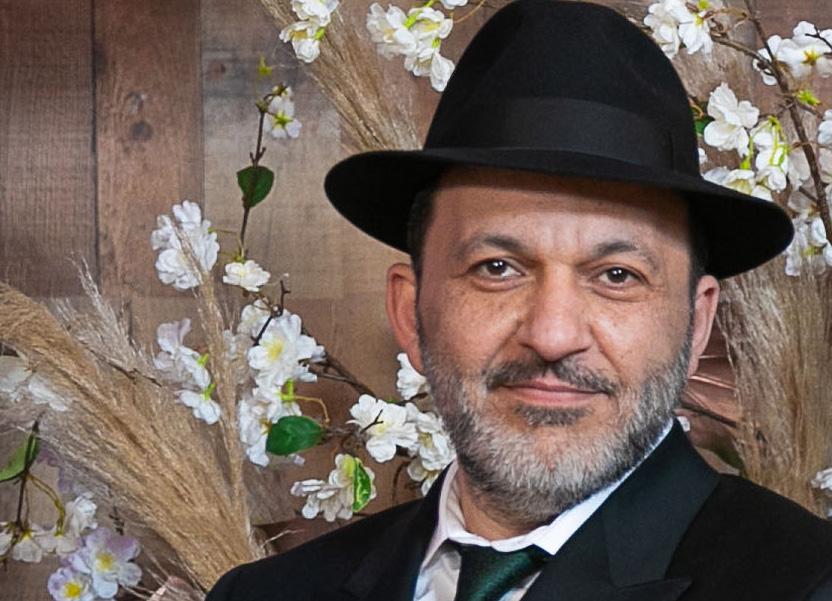
A business panel discussion
The
COLUMNS

TISHREI
& Dry Cleaning
short essay
A
tefila Singers
inspiration
Beautiful Minhag Origin of Tashlich
on Duty R’ Meir Harlig and the lulav
with the Rebbe A galllery by JEM
Baked Desserts
culinary delights
visit to 3 eateries
Heights Kosher
restaurant guide
Pages
Our favorite
share
The
Chossid
Tishrei
KOSHER Yomtov
New
A
Crown
Local
KIDS Fun
silent meeting
story by Sandy Eller
A
Soffer
Malchus
letter by the Rebbe Health
Janet K. Kennedy Mental Health Daniel Schonbuch, MA, LMFT Humor Mordechai Schmutter Numbers & Zmanim Then & Now 1418 President St. 28 30 36 42 48 80 86 90 96 92 6 8 72 76 100 103 106
From the Publisher Mica
Dvar
A
Dr.
CONTENTS 18 60 64 10
4 COLlive Magazine

FROM THE PUBLISHER MICA SOFFER
PUBLISHER

Mica Soffer
EDITOR
Rabbi Yehuda Ceitlin
CONTRIBUTING WRITERS
Menachem Wineberg
Dovid Zaklikowski
Rabbi Shea Hecht
Rabbi Yehuda Ceitlin
Sruly Meyer
Sara Spielman
Zev Gotkin
Menachem Levy
Daniel Schonbuch
Chanie Apfelbaum

Libby Herz
Sandy Eller
Mordechai Schmutter
COVER PHOTO

Shneiur Chaviv
PHOTOS
JEM
Hasidic Archives
Shalom Burkis
Nechama Photography
ADVERTISING
Phone: 718-427-2174 ext. 2
Email: ads@COLlive.com

EDITORIAL INQUIRIES OR SUBMISSIONS
Phone: 718-427-2174 ext. 1
Email: Editor@COLlive.com
COLlive does not endorse any products or services reported about or advertised in COLlive Magazine unless specifically noted. The acceptance of advertising in COLlive Magazine does not constitute a recommendation, approval or other representation o quality of products or services, or the credibility of any claims made by advertisers including, but not limited to, the kashrus or advertised food products. The use of any products or services advertised in COLlive Magazine is solely at the user’s risk and COLlive accepts no responsibility or liability in connection therewith.

There are some years that we just can’t wait to end, feeling as if the new year will bring renewal and better beginnings with it. There were some years when we’ve been through endless personal and communal challenges. I feel like this past year of 5783 was not one such year.
Of course, plenty of difficult times have occurred over the last 12 months. A quick review on COLlive.com reveals the painful loss of lives, the steady expected-yet-unaccepted slew of crimes in Crown Heights, and terror against Jews in the holy land of Israel. But outshining that was the beautiful and unifying energy of the Hakhel year that was felt in almost every corner of Crown Heights and in Chabad communities worldwide. School projects, community shiurim, special gatherings, and specific farbrengens were all held in that spirit.
This year, Crown Heights was filled with visitors of all ages from Israel and around the world - more so than usual. We also had (in no particular order) overflow crowds at the Simchas Beis Hashoeva, an all-out Mitzvah Tank Parade, a Great Lag BaOmer Parade that was truly great, a huge Siyum Harambam on Eastern Parkway, and a grand event celebrating the groundbreaking for expansion of the United Lubavitcher Yeshiva on Crown Street, and more.
Hakhel, guided by the instructions of the Rebbe, was like an antidote to the darkness and craziness that is displayed in modern society. When we were painted as relics, dividers, and villains, Hakhel helped us see ourselves as heroes, unifying and shapers of the future.
And to wrap up the year, we saw the completion of the 8th Children’s Sefer Torah. The final few thousand letters were recruited by dedicated Chassidim - men and women of all ages. The Siyum at the Kosel in Yerushalayim was a rare and outstanding demonstration of Jewish unity.
Hakhel showed us how powerful we are when we’re energized and united. With the year ending, this is our chance to keep the momentum going and bring Moshiach now.
Photo by: Nechama Photography
FIND US ON SOCIAL MEDIA: @COLliveOfficial @COLlive 718.679.9450
COLlive Magazine is published in print periodically by the Collive Media Group Inc. and is distributed free in Brooklyn, NY.
MicaSoffer
6 COLlive Magazine
TAKES TOURO YOU FURTHER
What does your dream career look like— is it in a courtroom, boardroom, or saving lives in the ER? Maybe you want to earn a graduate degree or conduct cutting edge research. If you’re ready to explore a world of opportunities, TOURO TAKES YOU THERE. touro.edu/poweryourpath

yourpath
REGINA DAVYDOVA, PA-C
TOURO’S SCHOOL OF HEALTH SCIENCES ‘06
CHIEF PHYSICIAN ASSISTANT DEPARTMENT OF PLASTIC SURGERY MONTEFIORE HEALTH SYSTEM
Man: The Fulfillment of Creation
By the Grace of G-d In the Days of Selichoth, 5729 [September, 1969]. Brooklyn, N.Y.
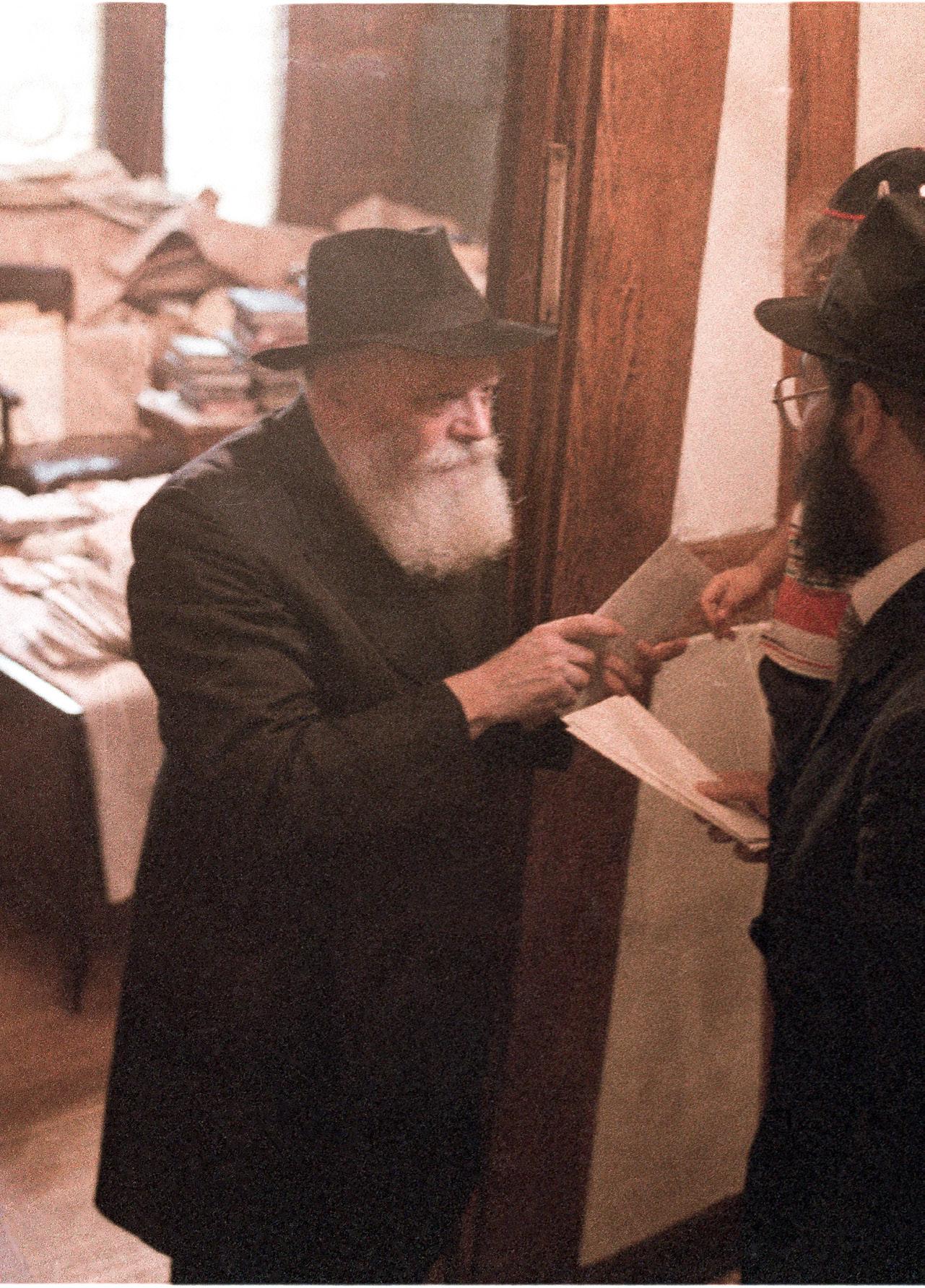
To the Sons and Daughters of Our People Israel, Everywhere G-d bless you all!
Greeting and Blessing:
It has often been emphasized that all things in Torah— Torah meaning “instruction” and guidance—serve as guideposts in our daily life. Our Festivals, needless to say, contain most important and over-all concepts, each festival according to its content. Pesach—the Season of Our Liberation—gives us an insight into the meaning of true freedom; Shovuoth—the Season of the Giving of Our Torah—primarily teaches us what Torah is; Succoth—the Season of Our Rejoicing—inspires us with profound feeling and perception of true Simcha (joy).
Rosh Hashana—which commemorates the Creation of the World, as we say, This is the day of the beginning of Thy works, a memorial to the first day—provides an overall concept of Creation and the destiny of the Universe.
The question has been raised why Rosh Hashana has been designated as the “day of the beginning of Thy works,” whereas actually Rosh Hashana corresponds to the sixth day of the Creation.
The answer was given by our Sages of blessed memory: Inasmuch as man is the ultimate purpose and raison d’etre of all domains of the Universe, and since with the creation of man the whole of Creation was completed and fulfilled, man in effect embodies the entire Creation, as if before him nothing was created.
Nevertheless, the question begs to be asked, How can this be said, when there is a big world besides man, an impressive and noteworthy world, viz., “How manifold are Thy works, O G-d” and “How great are Thy works, O G-d”? Moreover, considering the whole of Creation, man included, we find that the “speaking genus” (man) is much less than the order of animals, and still less than the order of plants, and least in comparison to inorganic matter (earth, minerals, etc.)?
The answer—and this indeed is one of the basic teachings of Rosh Hashana in regard to the entire Creation—is as follows:
The order in the scale of all created things, where inorganic substances exceed plants, and plants outnumber animals, and least of all is man, is based on consideration of quantity. However, when quality is considered, the order is reversed: Inorganic matter, which has no signs of life and locomotion, is at the bottom of the scale; above it is the world of plants, endowed
8 COLlive Magazine
with growth but lacking the vitality and movement of animals; higher still is the world of animals, which, since animals do not possess human intellect, is inferior to man—the highest of all creatures. For although an animal has an intellect of its own, the animal intellect is not an end in itself, but a servant whose function is to serve the natural needs of the animal. The human intellect, however—provided the person conducts himself as a human being and not as an animal, also is, and mainly, an end in itself. Furthermore, the human intellect attains its goal and fulfillment not when it serves as an instrument for the gratification of the physical needs, as in the case of animals, but, on the contrary, when all such natural functions as eating, drinking, and the like become servants of the intellect, in order that the person should be able to rise ever higher in intellectual and spiritual pursuits.
Yet, this is not quite the true fulfillment of the human being. True fulfillment is achieved when the intellect leads him to the realization that there is something higher than intellect, so that the intellect “surrenders” itself completely to that which is higher than intellect.
To put it more clearly: Human fulfillment is attained when intellect recognizes that man, and with him the entire Creation, must strive for and achieve complete surrender to G-d, the Creator of the Universe and Master of everything and all in it.
On the first Rosh Hashana this fulfillment was attained by the first man, Adam. It was reflected in his effective call to all created beings: “Come, let us worship, bow down and kneel before G-d our Maker.”
This concept directly relates to, and must permeate, our daily life, as evidenced also by the fact that the Psalm beginning with “G-d reigneth, He robed Himself in majesty” has been instituted as the “Daily Song” (Shir shel Yom) for the sixth day of every week around the year. This is what the first man, Adam, accomplished when he acknowledged the Sovereignty of the Creator, elevating himself and all Creation to a level of complete surrender to G-d our Maker, King of all the earth.
The general lesson to be inferred from all that has been said above is, in brief summary, as follows: Reflecting upon himself, a person will see that most of his life and most of his efforts are taken up with things which, at first glance, are material and mundane, such as eating, drinking, sleeping, and the like, with all preparations therefor. It is also evident that among the human species there is a greater number of “men of the world” than “men of the spirit.” And in general one sees a vast material and physical world immersed in material pursuits. Hence, one may erroneously think that perhaps the material and physical aspects of life
are the most important in the world— Comes Rosh Hashana and teaches us that the opposite is true: To be sure, it took five days and part of the sixth to create all sorts of creatures. Yet, it was man, a very small part of Creation in time and space, that was the essence and purpose of the entire Creation. And in man, too, the essential thing is not the body, which is “dust from the earth,” but the soul, the living spirit which G-d “breathed into his nostrils”; a soul which is “truly a part of G-dliness above.” Only after man was created with the Divine spark in him did the entire Creation become worthy and complete. Thus man can justly be described as the “beginning” of Creation in all its domains, and Rosh Hashana, the birthday of man, as “This is the day of the beginning of Thy works.”
A further instruction follows from the above: Speaking to our fellow-Jews about the necessity to fulfill the Mitzvoth in the daily life, in accordance with the command of G-d, the Creator of the world, Whose Providence extends to each and everyone, everywhere and every minute—some may ask: If this is truly the purpose of Creation, how is it that those who observe the Torah and Mitzvoth in all details are as yet not in the majority? And how is it that Jews are altogether a small minority among the nations of the world? The answer is given in the emphatic message of Rosh Hashana: “This is the day of the beginning of Thy works”—the essential thing is not quantity but quality, so that even one person can elevate the entire Universe to a degree where not only he but all around him can perceive that “G-d reigneth, He robed Himself in majesty,” thereby crowning G-d as King of all the Universe. This is also the primary aspect of the sounding of the Shofar—as symbol of the “Coronation” of the Creator and King of all the Universe.
May G-d grant that everyone in the midst of our people Israel should achieve the above in his share of the world, so that in the sum total of the combined shares the whole world will acknowledge the Divine Kingdom, and we will speedily see the fulfillment and realization of our prayer, together with all our prayers: Establish Thy reign over all the world . . . that every creature shall know that Thou didst create it . . . and everyone that has a soul shall declare, G-d, the G-d of Israel, reigneth, and His Kingdom rules everywhere.”
With the blessing of Kesivo vachasimo toivo
For a good and sweet year, /signed: Menachem Schneerson/
DVAR MALCHUS Kislev, 5783 9
The dual Rabbi Moshe Wiener
Leader of the large social services provider is also a scholarly author
By Menachem Wineberg
There are many who know Rabbi Moshe Wiener as an author of halachic works, outspoken advocate for the holiness of the beard and dignity of tznius and lecturer on Halacha topics in our Yeshivos.
There are many who know Rabbi Moshe Wiener as the Executive Director of Jewish Community Council of Greater Coney Island, one of the largest citywide providers of diverse social services which brings relief and improves the quality of life of all segments of the population, including major critical initiatives benefiting our Haredi communities throughout New York City. Very few realize that the two Rabbi Moshe Wieners are really the same person.
Wiener’s journey to Lubavitch from a non-Chassidic upbringing is a testament to the important work of those who work in hafatzas
hamayanos within the frum community. After spending a summer soon after he turned 14 at a Yeshiva day camp in the Five Towns where he was inspired by the yiras Shomayim, Emunah and Bitachon of the Lubavitch Dubinsky family, Moshe Wiener did not find spiritual satisfaction when he entered Yeshiva University’s High

School in Washington Heights. He sought out the Tanya shiurim at YU, organized throughout the Yeshiva world by the legendary Rabbi Meir Ronass o’h, and delivered by several bochurim from 770, including Rabbis Chaim Farro, Daniel Goldberg, and Heschel Greenberg. Young, impressionable, and looking to grow in his yiras shamayim, these shiurim and the relationships he made (including friendships with two older YU talmidim who already had become Lubavitchers, Rabbi Yechezkel Kornfeld and Mordechai Litzman) helped foster a strong connection to Lubavitch. That relationship was further cemented after spending the summer post 9th grade at a camp where Rabbi Simcha Werner was a learning Rebbe.
His first time seeing the Rebbe was when he attended the Rebbe’s Purim farbrengen in 5728. After that moving
10 COLlive Magazine
Rabbi Moshe Wiener
experience, he began to periodically spend Shabbosim in Crown Heights and utilized the free time YU provided its students each Sunday afternoon to travel to 770 where he learned Chassidus

with 770 bochurim and davened Maariv with the Rebbe before traveling back to his dormitory room at YU. He also met regularly on these Sunday afternoons with Rav Yisroel Jacobson, who the
Rebbe designated to provide him with guidance. He recalls with a smile once consenting to Rabbi Avraham Gerlitsky, who was teaching Tanya in a summer camp he was in, to “kidnap” him for a Shabbos in the middle of the summer to spend Shabbos Mevorchim by the Rebbe.

Although at that point he already considered himself a Lubavitcher, Wiener wouldn’t get to learn in Lubavitch for many more years. “My parents wanted me to get a degree and a college education so they weren’t fond of the idea that I go to learn in Lubavitch. I transferred to Ner Yisrael in Baltimore where there was a program that allowed for students to pursue a college degree while continuing to learn in the Yeshiva,” he
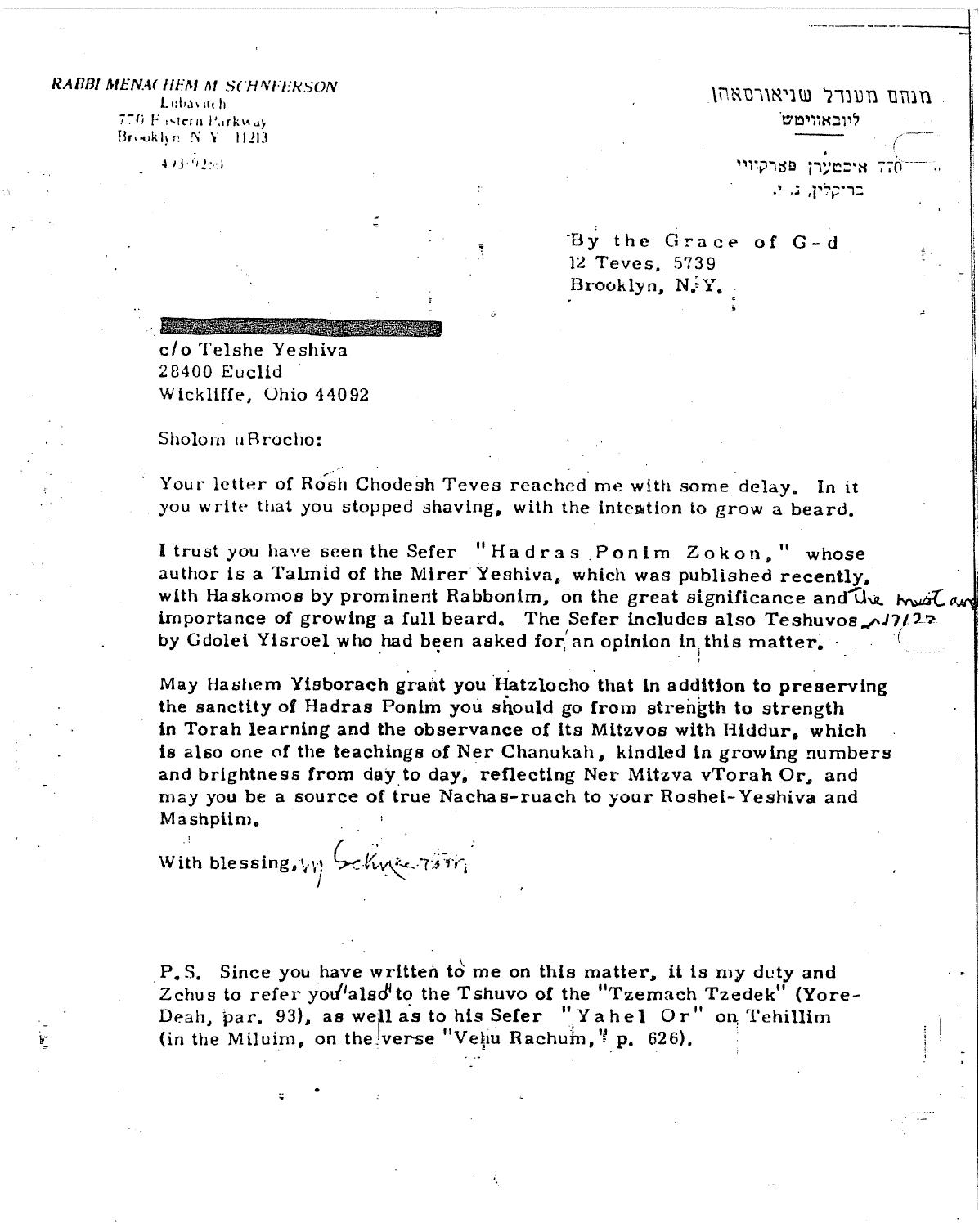
PROFILE Tishrei, 5784 11
Wiener Moshe Kos Shel Bracha
Answers from the Rebbe
says. On Friday afternoons, when yeshiva seder was off, he would learn chassidus with Reb Itche Springer who was the Shliach to Baltimore and teaching at the Shearis Hapleta school in Baltimore at the time.
In Ner Yisrael, he began to learn chassidus with other bochurim, an initiative that did not go unnoticed by the yeshiva’s hanhala, Roshei Yeshiva, Menahalim and Mashgichim, who were less than thrilled by what they saw. Wiener somehow obtained the keys to a large closet in the dormitory where he set up a table and chairs to
secretly learn Chassidus with bochurim. When the students were given an assignment by the secular studies department to prepare an essay about what inspires them that would be reproduced and shared with the entire grade, Wiener used the opportunity to write a lengthy essay entitled “Inquest Into Essence” that addressed core issues of Yiddishkeit from a Chassidic lens, the hanhala was particularly enraged. So many bochurim became involved in the study of Chassidus and the opposition of the hanhala was so intense, that the theme of that year’s “Purim Shpiel” in the
Yeshiva was Moshe Wiener’s “converting” the hanhala to Lubavitch.
Throughout his time in Ner Yisroel, Wiener maintained a steady correspondence with the Rebbe, asking for brachos and advice on how to deal with the delicate situation he was in with the hanhala of the yeshiva, who opposed his influence on their talmidim.
“The Rebbe would send his letters to Reb Itche Springer so that the hanhala of Ner Yisrael wouldn’t intercept them. Those letters gave me tremendous chizuk to keep going,” Wiener says. As the years went on, the hostility towards him became so fierce that the Rebbe eventually told him to back off and refer bochurim who were interested in chassidus to Rabbi Mendel Feldman, a local Lubavitcher Rav, but by then it was too late. In one letter, Wiener asked the Rebbe if hafotzos hamaayonos included encouraging people to daven Nussach Ari, to which the Rebbe responded affirmatively.

“When the son of one of the Mashgichim in Ner Yisroel started davening Nussach Ari, they had enough and told me that I would not be allowed back the following year.”
Following his expulsion from Ner Yisrael, Wiener moved on to the Mirrer Yeshiva in Flatbush where his Lubavitch leanings were not as ill-regarded. He achieved tremendous success in learning chassidus with bochurim there, with several even transferring to
PROFILE
12 COLlive Magazine
An Inquest Into Essense, Ner Israel-Baltimore, 1971
Lubavitcher yeshivas as a result. During those years, Wiener traveled from Mirrer Yeshiva several evenings each week to study in Chassidus classes delivered by Rav Yoel Kahn a’h at the nearby “770 Kevutzah” at the Lubavitcher Yeshiva on Ocean Parkway. Occasionally, Wiener brought Mirrer Yeshiva bochurim to Rav Yoel Kahn’s farbrengen and sometimes also to the Rebbe’s farbrengen.
Inspired by the Rebbe’s call for “Mipi Olelim V’yonkim Yesadita Oz” before the summer of 5733, Wiener founded “Yeshivat HaErev,” a learning program for Yeshiva Day School students in Flatbush (mostly Sefardim) who were otherwise on the street in the summer, and a year-round tutoring and remedial program. Wiener utilized his Kollel fellows from Mirrer Yeshiva as teachers, affording the Mirrer yungeleit their first exposure to chinuch (plus sorely needed
income). Some of those Kollel yungeleit eventually dedicated their careers to chinuch. During those years, Wiener also helped establish the Young Israel of North Woodmere (where he was brought up), which eventually served as the nucleus of the now major frum community in North Woodmere.
published under the title “The Body and the Soul: Unity or Duality – A Torah Perspective” (available on Amazon).
It was also in the Mirrer Yeshiva that he began to work on a sefer called “Hadras Ponim Zokon,” a work dedicated to the subject of beards in halacha and hashkafa. “Shaving was clearly a nisayon that challenged my chaverim in Yeshiva and I realized the need to address the issue in a way that would speak to them,” he says.
To make the sefer appealing to all groups within klal yisroel, Wiener began compiling Torah thoughts and chiddushim on the importance of keeping a beard from great Torah leaders representing all segments of Klal Yisroel, both past and present.

Corresponding with the major Torah authorities internationally, these

While at Mirrer Yeshiva, Wiener attended evening and summer classes at Long Island University, where he earned a postgraduate Master of Science (MS) degree in Counseling Psychology. His dissertation was based on concepts in Chassidus he absorbed at Reb Yoel Kahn’s shiurim and it was later
prominent Poskim and Roshei Yeshiva generally assumed that they were interacting with someone of advanced age and spiritual maturity. He remembers one occasion when the famed Maggid of Yerushalayim, Rav Sholom Mordechai Schwadron, concluded his correspondence with him with a request that
PROFILE
Tishrei, 5784 13
In the Ner Yisrael Yeshiva, he learned Chassidus with other bochurim. The staff were less than thrilled by that
he daven for his Rebbetzin, who was ill at the time, clearly unaware that he was writing to a young, unmarried man in his early 20s. Wiener then sent a letter to the Rebbe stating that the famed Maggid had asked for a bracha for his wife’s health. A few days later, he met Rabbi Leibel Groner who recounted with a broad smile that the Rebbe had asked him to inquire who exactly the Maggid asked a bracha from – the Rebbe or Moshe Wiener…...
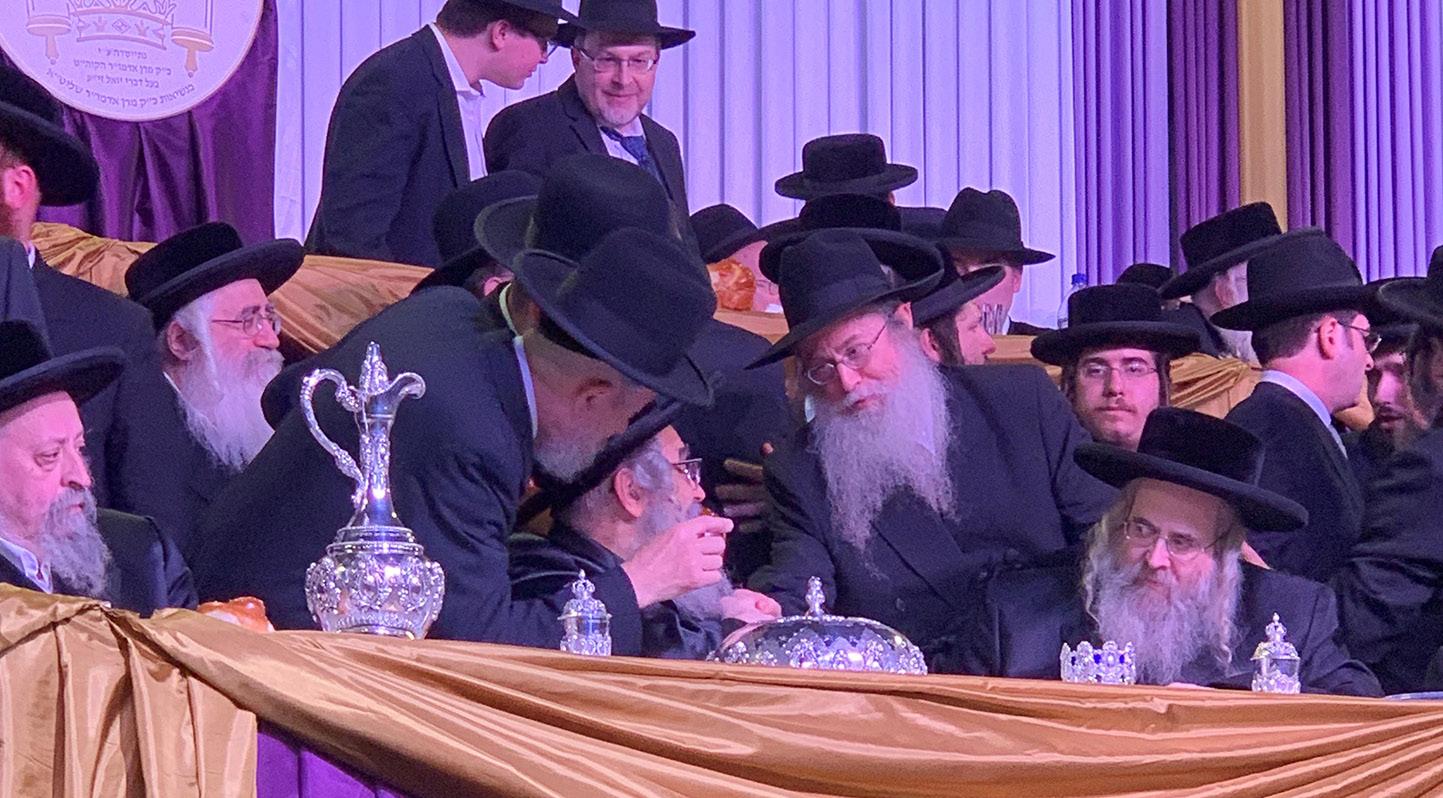
The Rebbe strongly encouraged the publishing of the sefer, offered resolutions to difficult passages and even chose the title and format for the sefer, and on several occasions the Rebbe participated in the costs of publicizing it with $100 bills and emphasized the importance of publicizing the sefer particularly during Sefiras Haomer and the months of Elul-Tishrei. The first edition was published in 5738 with letters of endorsement and support from leading
Rabbonim representing all segments of Klal Yisroel and within a few months, it was sold out.
During Wiener’s yechidus with his then-kallah before their wedding, the Rebbe immediately brought up the status of the second printing of the sefer and expressed his displeasure with the delays that had held up its publication. “After a bit of a mussar speech which left my kallah quite bewildered, the Rebbe finally gave us a bracha for our chasuna,” Wiener says with a smile. The Rebbe provided Moshe Wiener with consistent and passionate encouragement, especially in response to opposition to the sefer from certain circles. In at least one instance, the Rebbe personally intervened and transformed a prominent Rov from opposing the sefer to becoming a major advocate for beard growth. The last two published volumes of Igros Kodesh include eight letters from the Rebbe about sefer Hadras Ponim Zokon.
iener has also served as an expert witness in celebrated cases, including the beardshearing case after the attack on Rabbi Pinye Korf a’h, and a major prisoner rights case which eventually reached the Supreme Court.
Now in its fourth edition, the sefer has been expanded to become a two-volume set of over 1,200 pages, a masterpiece of halachic literature and research. It is widely respected in the Olam Hatorah and is used as a primary resource for people learning the subjects of beards in halacha and hashkafa. Over 40 years later, Wiener continues to promote the sefer and he has merited to see incredible results from it.
“Recently, someone shared with me the following story: An acquaintance of his who learns in the Kollel of Chaim Berlin in Flatbush asked him to borrow the Hadras Ponim Zokon sefer. A little while later, he met him and asked him what happened to the sefer. His friend told him that after reading the sefer he started to grow a beard and the issue became such a sholom bayis problem that he had to remove the sefer from his home. He gave it to a different friend and that friend, too, read the sefer and decided to grow a beard, as did another yungerman thereafter. ”
It was in Kollel following his marriage that Wiener embarked on a project to publish another sefer with immense encouragement and
PROFILE 14 COLlive Magazine
Wiener Moshe and Satmar Rebbe Rav Aharon Kislev 5779
guidance from the Rebbe, entitled “Kvudah Bas Melech”, about the halachic sources of the laws of tznius for women. From the Rebbe’s correspondence with him about the sefer, it is clear that the Rebbe saw the sefer as an important tool to combat some of the struggles that the frum communities were facing in this area. On one occasion the Rebbe wrote: “chaval al kol yom shemisakeves krias v’limud sefer zeh” - “Every day that this sefer is not published is a missed opportunity.” The Rebbe also dedicated some of his precious time to edit the forward to the sefer and offer encouragement and guidance when some of those who opposed Hadras Ponim Zokon also opposed Kvuda Bas Melech. Wiener remembers how Rabbi Zalman Shimon Dworkin a”h expressed his view that this sefer was even more important than Hadras Ponim Zokon, which he personally had invested so much energy into.
In 1981, with his second sefer now complete, Wiener had already left Kollel and was seeking a position in Rabonus at the encouragement of the Rebbe. When finding the appropriate Rabonus was delayed and his family was growing, Wiener accepted a position in the organization he
also). I was given the task of managing a new contract in the name of JCCGCI to provide supportive services the senior citizens who still lived there. My office and the entire JCCGCI was a large closet in the local Jewish ‘Y’,” he says.
In the years since, JCCGCI has grown to become a massive
has headed ever since – the Jewish Community Council of Greater Coney Island (JCCGCI).



“At the time, the Jewish community had basically moved out of Coney Island and the resources of the Coney Island JCC had been transferred to the Brighton Beach JCC and renamed Shorefront Jewish Community Council (which Wiener later assumed management of
operation with over 30 service locations throughout the five boroughs of New York City, with a work force of about 400 social service professionals and providing the full spectrum of social services to the diverse populations of people in need throughout the five boroughs of NYC.
What started out as a program for Jewish people in need expanded to become a
PROFILE Tishrei, 5784 15
Mayor Bill De Blasio Participates In Jccgci’s Rosh Hashanah Food Distribution
Rosh Hashana 2019, Rabbi Wiener with Councilmember Matthew Eugene
With Mayor Eric Adams
His dissertation at the Long Island University was based on concepts in Chassidus he absorbed from Rabbi Yoel Kahn
citywide provider assisting every ethnic and racial group in NYC. Divided into five divisions (Senior Support Systems, Vocational Support Systems, Education Support Systems, Management Support Systems and Community Support Systems), JCCGCI is now the largest provider in the world of social services for Holocaust survivors (outside of Israel and the former Soviet Union), providing over 1 million hours of homecare per year and multiple additional services. It
the major anti-gun violence “Cure Violence” program for southern Brooklyn, was designated as the stand-alone provider of transportation for older adults for the borough of Brooklyn and Staten Island (serving 6,000 seniors with 500 trips per day), and provides a wide range of vocational services and college and career preparation support for at-risk youth. When former Mayor Bill deBlasio founded the “City
Yeshivos) on topics of Halacha. Over the past 30 years he has instructed over 2,000 bochurim, some of whom are now melamdim, Shluchim, menahalim and even Roshei Yeshiva (and some of whom now have sons old enough to be second generation talmidim). Many maintain a close relationship with Wiener over the years. He has also managed to author several monographs on various topics, with 16 titles available through Amazon.
is the sole provider of NYC’s Internship Placement Services program for Public Assistance recipients with offices in all five boroughs; operates Adult Literacy programs in lowincome immigrant communities throughout the city; runs 8 Older Adult (formally known as “Senior”) Centers and 3 Meals-on-Wheels programs; and operates after-school programs in both public and Yeshiva schools.
After extensive advocacy, JCCGCI was designated to create and operate a “Haredi” Workforce Development Program with sites in Williamsburg, Borough Park, Far Rockaway, Crown Heights and Gravesend, which succeeded in making over 700 job placements during its first three year contract term. JCCGCI also initiated and runs
Clean-Up Corps” to clean up NYC post-COVID, it was JCCGCI which was selected and entrusted as the nonprofit to manage the program. JCCGCI succeeded in hiring over 1,300 previously unemployed individuals and established 127 worksites throughout the five boroughs. After the funding ended a year later, JCCGCI helped over 300 of the participants find permanent employment. Its Non Profit Help Desk (NPHD), founded in 1992, has supported over 2,000 nonprofits with capacity building technical assistance, helping them responsibly manage their fiscal and organizational needs. Despite his busy schedule, Wiener makes time to teach each week at Oholei Torah (and occasionally at other
42 years on the job, Wiener isn’t stopping any time soon. JCCGCI continues to expand and take on new projects as the need arises. In just the past few months alone, JCCGCI opened one of the first “Trauma Recovery Centers” in NYC, to serve the borough of Brooklyn, which is already developing a waiting list.
JCCGCI established a “Connect 2 Care Building Resilience in Youth Project” mental health outreach program. JCCGCI is also setting up new sites for its School Based Conflict Resolution Program; an expansion of its therapeutic services mental health program; opening a new Gun Violence Prevention Program and expanded occupational skills training opportunities in the Haredi communities of NYC.
JCCGCI is an “or lagoyim”, a shining Kiddush Hashem in the melting pot of diverse communities in New York City.
PROFILE 16 COLlive Magazine
A few days later, Rabbi Leibel Groner said the Rebbe asked him who did Rav Sholom Mordechai Schwadron asked a bracha from...
wishes you and your family a
On behalf of hundreds of families in our community, THANK YOU to all our donors for your generosity and support this Tishrei and all year long.
Chevra Simchas Shabbos V’Yom Tov
Feeding Crown Heights families since 5738-1977
You can feed a Crown Heights family
Donate today at: www.CSSY.org/Tishrei
PayPal: www.PayPal.me/cssy

Cashapp: $cssycashapp
Zelle: office@cssy.org
Or mail your donation to:
CSSY
593 Montgomery St. Brooklyn, NY 11225
המיתחו
הביתכ הבוט
CSSY
Consistently Shy, Consistently Forging Ahead

The life of Shimmy Benabou
By Dovid Zaklikowski
He would quietly move around the store. Many never knew that he was the owner. His sharp eyes taking it all in; constantly strategizing. Where should the crackers go? What about the chocolate? Should the coffee be at the back or the front?
“Consistency, consistency, consistency,” he would say, “is the only way to success.” That is, consistently making upgrades. Consistently staying one step ahead. Consistently calculating the most desired flavored chips; consistently putting the customer first; but on top of all consistent in never giving up in the face of failure.
While individuals with the name Benabou abound in the Crown Heights neighborhood, most would have not been able to pick out Shimmy
Benabou from a crowd. Then after a difficult illness, Shimmy slipped away, leaving his family and friends with a hole in their hearts. It was only then that his picture appeared from time to time in the large store front of the store he ran with his wife Shoshe.
“For years we never exchanged a word,” said neighbor Sholom New, “but when you saw him, he was consistently with Shoshe walking at the same time towards Kosher Town.”
After his tragic death, among the employees at Kosher Town there was an eerie silence. His familiar face at the iconic grocery store on the corner of Albany Avenue and Empire Boulevard was missing from the aisles; his curious eyes bulging from around the coffee station; the quick movements of his hands as he organized shelves. There were so many reminders. Each one a ping on the heart. But for Chaim Lipsch there were some that brought a wicked smile to his face. They were Shimmy classics.

18 COLlive Magazine
“I haven’t been here for a while,” one former regular told him, “but I have been thinking about the large bill I have at the store.”
The cashier did not recognize the woman. Perhaps she usually came in the morning, when he was not there. But according to her own admission, she had constantly made purchases on credit over two years, until she learned that her husband was not paying the bills. “It must be a tremendous amount of money,” she said, “But now I have saved a small fortune, and I hope that it will cover the bill.”
The ever polite Chaim could not really care less about the story. He was there to help in any way, and when he looked up her phone number and nothing came up, he was baffled. “Your number is not in the system,” he told her. She was adamant that surely there was a mistake. After haggling a little longer, Chaim said that he would ask the store manager to look under her name later that day, “Come back tomorrow.”
She did. But he had no news for her. Shimmy had done it again. There were no traces of when or how it happened. What were his motives? What was he thinking when he hit the trash button on this large outstanding bill?
Not that Shimmy would want it, but there was also no one to thank. It was classic, consistent. Consistent to be better. Consistent in being
kind. Consistent in doing it without fanfare. It was Shimmy.
Language Doesn’t Matter

The Benabou family arrived, in the early 1990s, to New York for the wedding of their daughter and sister Dorit to Ronen Giro. The parents, Asher and Alice, kept on pushing off their return date. With no money, in a small basement apartment, he began to ask where he could send his son to learn. Thus, Shimmy began his studies at the United Lubavitcher Yeshivoth on Ocean Parkway. “He was a newcomer,” said Rabbi Yitzchok Tenenbaum, “he did know Lubavitch, but that never stopped him.”
While he may not have known the language and lingo, growing up Shimmy excelled in his Judaic studies, and was a good student at the Bnai Akivah Yeshivah not far from his home.
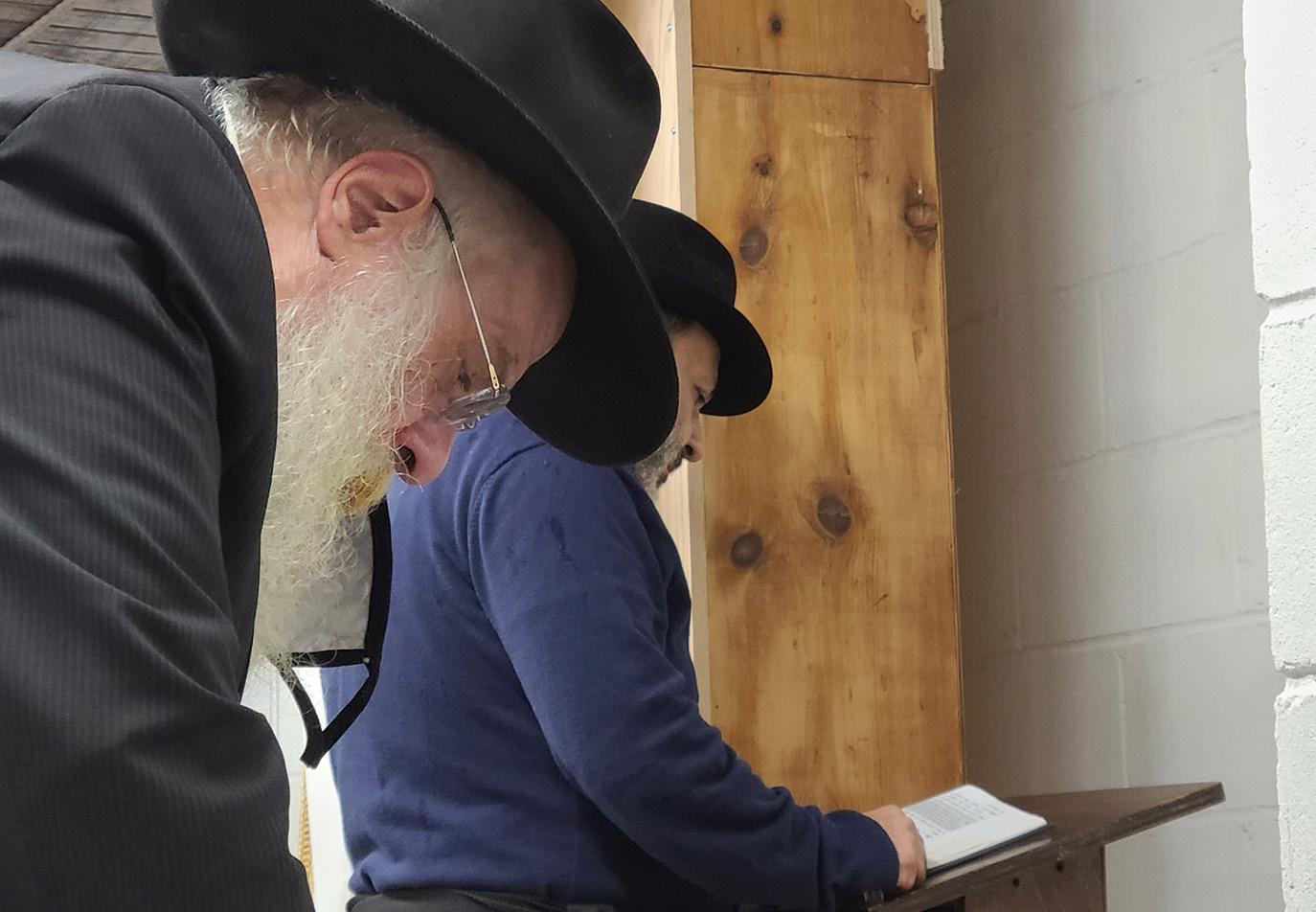
His motivation pushed him to learn the language, and to try to understand the studies. After himself acclimating, he was there for others, said Yaron Pinson. He had moved from out of town and joined the class, and Shimmy was there to welcome him, “He was able to feel how I felt on that first day in Yeshiva not knowing anybody. He was always thinking of and caring for others.”

Shimmy would later say about that time, “Motivation is stronger than language.”
Shimmy’s life would be
one of blending his natural tendencies with what he believed was right, not just for himself, but for those around him. The blend would start with his marriage to Shoshe Wudowsky, throwing himself into an accepting, but decisively chassidishe Ashkenazi family, while he
FEATURE Tishrei, 5784 19
was a proud Sephardic, who had a love for Chassidic ideas, but never fully embraced all of its customs—though never trampling on those who wanted to.
The home they built included Moroccan dishes, classic Sephardic customs, their melodies, and a love for the Rebbe, the learning of Tanya and Chabad niggunim.
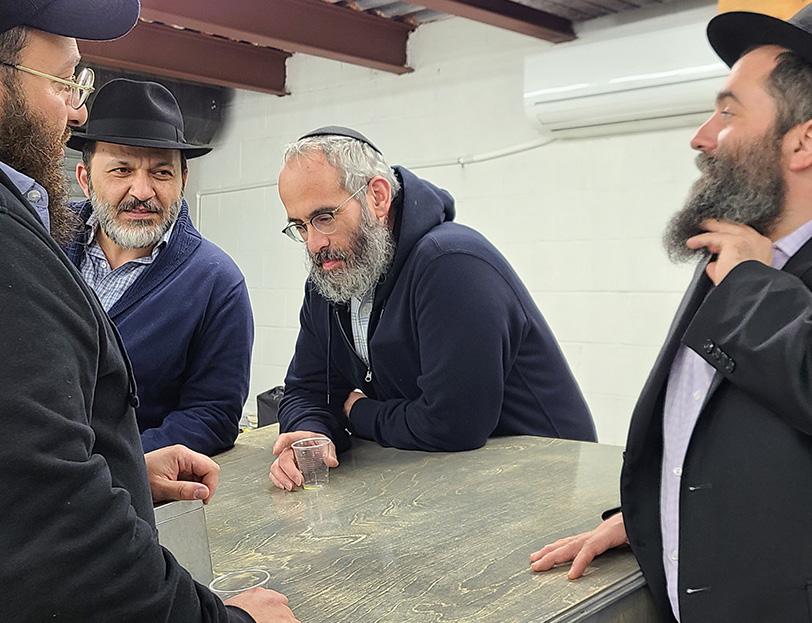
While at the office he was a pointed, shrewd businessman, always in a whirlwind of ideas one step ahead, but at home he was the calm, loving father. If it was natural for him to fight to the bitter end, he nevertheless bent over to do everything for peace.
“Shimmy worked on himself every day of his life,” says Shoshe, “At home, he had no chaos about him.”
At first he partnered in a grocery store on Kingston Avenue, when that did not work out, Shimmy forged ahead purchasing the grocery store on Albany Avenue. He and Shoshe would later open Cafe Rimon, a dairy eatery, down the block.
Kosher Town slowly expanded into several neighboring stores, and then to housing the café and coffee station.
“We worked very hard,” said Shoshe. “There were years that we had nothing.” In the office, at times things were
Heights Print&Ship store, said that Shimmy didn’t cut corners. “There was no easy way out. If he wanted to do it, he did it right, without letting his inhibitions get in his way.”
Shul Changes

After his mother’s passing at the end of February 2020,
tense, suppliers needed to be paid and employees needed their paycheck, it was left there and far away from his family. “Our children never knew what was going on,” she said.
Even during tense times, said Chaim Lipsch, their discussion was always fused with Shimmy’s unique humor, he treated the employees well “and always paid us on time.”
Down the block, Mendy Smetana at the Crown
despite his natural shyness, said Shoshe, “He overcame his fear for his mother,” and made a resolution to lead the davening three times daily. Then Covid-19 hit and everyone was secluded to their homes. As soon as the idea for the porch minyan was conceived, Shimmy started one on his back porch.
The minyan continued long after lockdown, while before he was not much of a shul goer, from his respect for his

FEATURE 20 COLlive Magazine
“I accept it all with love,” Shimmy said about the horrifying pain he was in, “I have no complaints to Hashem”
mother, he established one in his garage. “The shul changed his life,” Shoshe said.

It was an eclectic group of people, neighbors, family, friends and those who came once and fell in love with its welcoming vibe. It includes French, Israelis, Americans and hardcore ‘gezhe’ Lubavitchers. “The shul was home,” said Shoshe, “he loved the people.”
Reflecting the diversity, was the type of coffee he and Shoshe would prepare daily for everyone who came. Some wanted one scoop of sugar, others two, then Splenda, or soy milk. Although he never understood those who would want to drink decaffeinated coffee—which the store never carried—when someone started to come who wanted decaffeinated, he raised his eyebrows in surprise, but from the next day, he prepared that too.
“Shimmy treated everyone with the greatest respect and warmth,” said Dov Baron, who joined the daily minyan, “even strangers. He managed to remember the exact way each person enjoyed his coffee. This is just one small example of how he was always striving to make everyone comfortable, respected, and cared for.” He later purchased a coffee machine that serves the daily minyan until today. Coming into contact with those he would have never otherwise met, brought life lessons. One he told several times was that for years he

believed that a particular person was a bit strange, then he joined the minyan and he realized that he was in fact a smart and interesting person. “My whole life I judged people,” he said then. Being harsh on himself, he would say over and over, “I learned that we should all focus on getting to know people, and they may turn out to be kind and nice.”
While the Benabous always had guests, the shul, said Shoshe, brought so many
people to know him more, to know “the real shimmy, warm, shy, but overflowing with love.”
Then a year later, shortly before his daughter’s wedding, Shimmy was diagnosed with cancer. “I was dealing with two sides of the rainbow,” said Shoshe, “Shimmy was very ill, and we were marrying off our daughter Rosie. It was the happiest time and a very scary time. But there was no question that he was going to
FEATURE Tishrei, 5784 21
survive.”

After many years of hard work, Kosher Town was doing well, but now they were facing hell. “We used to say that we work so hard that we cannot even get to Borough Park,” but then they found themselves spending much of their personal time going to treatments in Borough Park. The two began to tell friends that they should “take each moment with your family and enjoy them. Teach your
or did not have the strength. Then one day he reached him on the phone, and he said he should come. Shimmy had just come back from the difficult treatment in Borough Park. He told him about the shul and about the new location of a takeout store he was opening on Kingston Avenue, “He was sick, very sick, but he was just moving forward.”
“I accept it all with love,” Shimmy told him about the horrifying pain he was in,
His home included Moroccan dishes, Sephardic customs and melodies, and a love for the Rebbe, the learning of Tanya and Chabad niggunim
children and friends not to wait. It should be now.”
It was difficult, and full of complications, but that last year he traveled several times on vacation with his family. He tried to have as much meaningful time together. In addition, over that year, despite how difficult it was, he continued to come to shul several times a week, made farbrengens in his home, and continued his weekly shiurim. Now a teacher in the Rabbinical College of America, when Rabbi Tenenbaum heard that Shimmy was sick, he wanted to go visit him. While he made several efforts, he was always told that Shimmy was at treatment
“I have no complaints to Hashem.” He continued to tell him what the Alter Rebbe wrote in Tanya Lehaskilcha Binah.
“I did not know what to do with myself,” said Rabbi Tenenbaum, “We learn Tanya, but here was a person who was living with it. He was actually implementing it in his life. I could not believe it.”
Shimmy implored that the shul be kept open, to make sure that it would be the welcoming place he envisioned and of course, “Have the best food.”
Then on a Shabbos morning, Shimmy returned his soul to his Creator. It was devastating for his family, friends and
the community he built. A year later, Shoshe says that it was clearly what Hashem wanted. Shimmy was healthy, went to the doctor monthly, and it made no sense that the cancer was found in an advanced stage and not earlier, “It was clear that if Hashem would have wanted him to live, he would have lived. This was Hashem’s hand.”
Ultimately, she said, the only thing “you go down with is the way you treat people, and your good deeds. It is not rocket science. And the only thing he went down with was his good deeds.”
For her, being alone, the sounds of the shul in the morning has been a true nechamah, “The shul was a savior. He left me with an extended family. I love that it is here.”
In his memory the shul recently dedicated a new Torah. Shoshe repeated what Shimmy said about the Torah that was dedicated for her parents and that is the way she feels: “This is a moment that we were all waiting for. A moment we become united with Bubby and Zaidy. The Torah is a living thing. The way I understand it, is that every time you want to connect to Bubby and Zaidy you could do it through the Torah.”
Dovid Zaklkowski is the proud father of Shaina, Motty, Meir, Benny, Mendel and Sholom. His can be found in all Crown Heights bookstores and at HasidicArchives.com. He could be reached at DovidZak@gmail.com.
FEATURE 22 COLlive Magazine


Reb Yossel Hirsch The childhood friends from Auschwitz - and their self sacrifice
By Rabbi Shea Hecht

REB YOSSEL HIRSCH was a baker and one of my father’s closest friends. He was a year younger than my father, but passed away shortly before him.
Reb Yossel was a Bobover chassid who immigrated from Poland to the United States after World War II. His levayah was held in Jeffers funeral chapel in Boro Park.
On the way to the cemetery, the levayah passed by the Bobover shul, with the expectation that the Bobover Rebbe would come out to pay his respects to Reb Yossel. This is a custom among many Chassidic sects.
Being a Lubavitcher chassid, I wanted to see how it was

done in Bobov, so I ran ahead and got to the Bobover shul just before the Rebbe came out. I figured I would get close enough to see and hear if the Rebbe would say a eulogy and what he would say for his chassid, Yossel.
Here is what the Bobover Rebbe said.
“Yossel Hirsch was sent to Auschwitz along with a childhood friend by the name of Shloima Weiss. Yossel was in Auschwitz for a long time, over a year. Every morning, the Jews were instructed to check the bulletin board to see the new list of names written there. Whoever’s name was on the list had to join the march that led to the gas chambers. “One morning,
24 COLlive Magazine
Yossel and Shloima checked the bulletin board, and both were horrified to see that Shloima Weiss’s name was written on the board, which meant that he was going to be killed that day in the gas chamber.
“The way it worked was that if a person’s name was on the list, he had to go to an office and register with the commandant. If everything checked out with the person, one of the Nazi guards would tell him where to line up with the others who shared the same fate, and he or she was led to the gas chambers
that day. The Germans were precise and systematic even with their methods of murdering people.
Yossel told Shloima he was going to register in his place, Shloima exploded. ‘What? Are you crazy? You’ll accomplish nothing They’re just going to kill us both! You’re not doing this.’

“Without saying another word, Yossel hurried to the office to register. He ran into the office and stood before the commandant. “As it happened, Yossel and Shloima were both on the short side. But Shloima was skinny, frail, and weak, whereas Yossel was on the stocky
side and looked healthier.
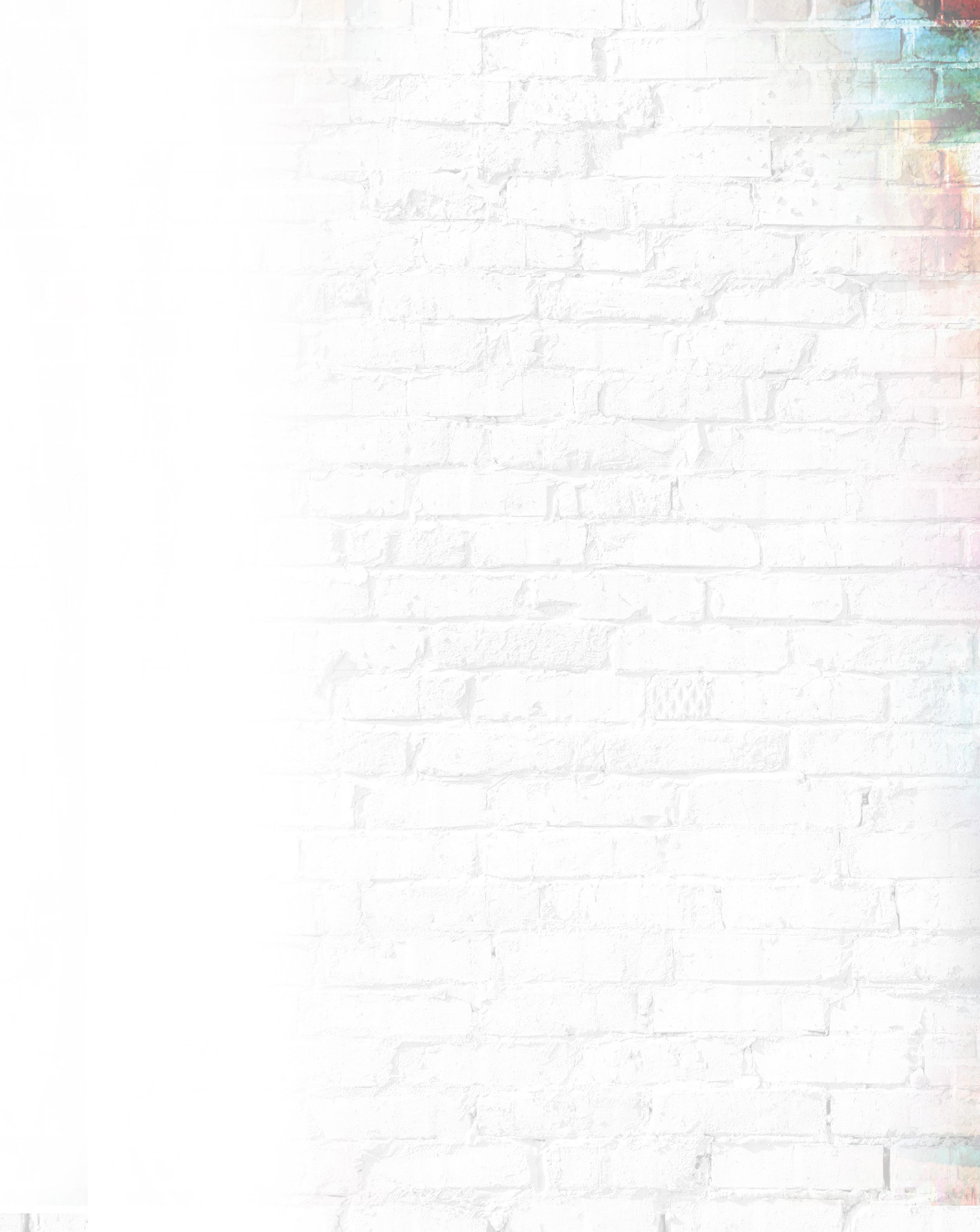
“Every day the Nazi guards would walk around the camp to see if someone wasn’t working hard enough and wasn’t producing enough of whatever they thought he was supposed to be producing. The underachievers were the ones who were put on the list to be sent to their death.
“There was Yossel standing in front of the commandant, who saw that something
“Yossel turned to Shloima and said, ‘Listen to me, I’m going to go instead of you.’ “When
was wrong. Yossel didn’t fit the picture of someone who belonged on the list. He had
STORY Tishrei, 5784 25
Shloima exploded. ‘What? Are you crazy? You’ll accomplish nothing. They’re just going to kill us both!
too much meat on his bones, and he still had a spark of life in his eyes.
“The commandant asked him, “Who are you?” “Yossel looks the commandant right in the eye and said, ‘I’m Shloima Weiss.’
“The commandant looked him up and down and asked again, “Who are you? Something is wrong here. This cannot be.’ “Yossel said, “I am sorry. I do
numbers were tat- tooed on their arms, they were just one number apart. “The commandant stared at Yossel and repeated, “This is not the right number!’
“Yossel looked the commandant in the eye and said, ‘Do you think I don’t know what this list is for? I know why the names are on the bulletin board! It’s for the last march. Would I be here

Weiss lived. Yossel Hirsch lived. They both married. They both had children. They both had grandchildren.”
The Rebbe then spoke about the extraordinary mesirus nefesh of Yossel Hirsch, a Jew who willing to lay down his life so that his beloved friend might live, the essence of ahavas Yisrael.
not know what can be or what cannot be. All I know is that I am Shloima Weiss.” “With that, the commandant jumped of his chair, walked around the table, and grabbed Yossel’s arm, roughly pushing back his sleeve to look at the number on his arm. Then he checked his list to compare Yossel’s number with the number on the list. “This is not the right number. You are not Shloima Weiss!’
“Now, Yossel and Shloima were childhood friends and arrived in Auschwitz together on the same train. When the
if I wasn’t Shloima Weiss?! Maybe someone made a mistake when he wrote my number on the list. I’m telling you that I’m Shloima Weiss.’ “The commandant thought for a few seconds, then sent him out of the office and corrected his paper. Apparently, he figured that with the number being only one off from the correct one, it was plausible that a mistake had been made. Shloima Weiss’s name was taken off the list.”
The Bobover Rebbe finished the story and looked up to heaven. He said, “Shloima

When I tell this story, I always mention that as a kid growing up in a Chassidic family, we would often hear about the greatness of mesirus nefesh. Usually the stories that were told to us were of events that had taken place hundreds of years earlier, from the Talmud or from the early Chassidic masters. Those stories were always impressive, but they weren’t the kind of stories I could fully identify with. This story about Yossel Hirsch was different. Here was a man whom I knew personally. He was older than I was, but still a contemporary. That made the story extremely powerful for me.
An excerpt from the new book “Whatever It Takes,” a collection of true stories of courage and hope, as told by Rabbi Shea Hecht, a communal leader for 40 years in the Crown Heights community of Brooklyn, New York. It is available for purchase on mosaicapress.com and Amazon.com.
STORY 26 COLlive Magazine
Yossel didn’t fit the picture of someone who belonged on the list. He had too much meat on his bones, and he still had a spark of life in his eyes.

















PlumbersHaven.com | (718) 604-1300 516 Empire Blvd Brooklyn, NY 11225 !הבוט הנש
7 Ways
Teshuva is like CleaningDry
 By Rabbi Yehuda Ceitlin
By Rabbi Yehuda Ceitlin
The central theme of Elul, the final month of the Jewish calendar, is teshuva — repentance (or, more accurately, returning to Hashem). We strive to better ourselves as we prepare for the Yomim No’raim (days of awe).
This process culminates on Yom Kippur, one which the Torah says (Vayikra 16:30), “For on this day, He shall effect atonement for you to cleanse you. Before Hashem, you shall be cleansed from all your sins.”
Perceiving the work of teshuva as a form of dry cleaning can help visualize and actualize the cleansing of our souls. Here are seven things that the two have in common.

1. Notice the Stain
The first step in giving your garment a cleaning is recognizing that it is in need of one. However carefully we wear our clothes, there will be stains that will need to be addressed.
The first step in doing teshuva — returning to Hashem — is to recognize that you have strayed, that your actions have stained your neshama. Once you notice the blemish that the aveira has created, you can clean it.
2. Go the Extra Mile
For everyday clothing, you can throw it in the washer with detergent and a short while later — it’s done. But
garments, which require professional treatment that takes longer. You do it because those clothes deserve the extra effort.
Our neshama - the one granted to us by Hashem - also requires extra gentle care. The focus of teshuva isn’t only about making up for misdeeds but also on coming closer to Hashem. Chassidus describes the latter as “Teshuva Illa’a” (“Higher Teshuva”) - the extra mile.
3. Pre-Inspection
When the cleaners take in clothes, they perform a pre-inspection, checking for stains, fabric type, and special
28 COLlive Magazine
handling requirements. Stains are then pre-treated using solvents or spotting agents to break down and remove the stains.
The month of Elul and then the Aseret Yemei Teshuva, between Rosh Hashanah and Yom Kippur, allows us to do just that. The stretch of 29 days plus 10 days enables us to dive into introspection and review those negative traits we have stubbornly held onto throughout the year. We can then focus on each of them - whether they are wrongs we have done to others or to Hashem.

4. The Agitating Wash
The actual cleaning is done in dry cleaning machines that do not use water but a robust solvent added to the drum and a small amount of detergent. The drum rotates, and the clothes are tumbled gently in the mixture, helping to dislodge dirt and stains from the fabric.
With the prerequisites out of the way, the hard work of teshuva begins: feeling and expressing regret for the way that our wrongdoing has impacted ourselves, others and the universe. This agitating process and our salty tears lead to rinsing away the stains from our aveiros.
5. Don’t Linger
Once cleaned, the garments are immediately placed in a
drying machine that removes any remaining moisture left. Wet clothing left to linger may develop a musty smell or be otherwise damaged, so it’s important to dry the clothing promptly.
Tears of regret are an important tool — but as soon as they have served their purpose, we cannot dwell on our sadness and fall into despair. Melancholy is the enemy of positive action, the Alter Rebbe teaches (Tanya 31). Instead, we dry our tears and channel our regret into a feeling that inspires us to improve ourselves.
6. Plan for the Future
Once the cleaning process is complete, the clothing is pressed, folded, boxed, or hung on hangers and placed in a protective bag. As you take them back home, you try to avoid getting them stained again with that greasy stain that took so much effort to remove.
Once our neshamos have been cleaned through teshuva, the next step is resolving to be better in the future (Mishneh Torah, Teshuva 2:2). We try to keep away from the habits and situations that have led us to
go astray. We try to keep our souls as pristine as possible.
7. Make it a Habit
Despite our best efforts, a clean garment only remains that way for a while. As we go about our day, spots and stains tend to come up, and regular cleaning can ensure the clothing is ready for use whenever needed.
Similarly, Chassidus urges us to perform a “cheshbon hanefesh” (an accounting of the soul) every night before going to sleep. This is based on the instruction of the Tanna, Rabbi Eliezer, “Repent one day before your death” (Avos 2:10). Because we don’t know the day of our eventual death, the Gemara (Shabbos 153a) concludes that we should do so daily and always be prepared to give a reckoning of our actions to our Creator.
ESSAY
Tishrei, 5784 29
- Rabbi Yehuda Ceitlin, Editor of COLlive.com and COLlive Magazine, is the outreach director of Chabad Tucson, and Associate Rabbi of Cong. Young Israel of Tucson, Arizona. He coordinates the annual Yarchei Kallah gathering of Chabad Rabbonim and Roshei Yeshiva.
Our Favorite Tefillos
6 renowned Jewish vocalists pick their moment of the Yomim Noraim
 By Sruly Meyer
By Sruly Meyer
Amidst the preparation for the Yomim Noraim, there is a lot of hustle and hurry. There is much to be done, and then just like that we are in Shul and davening for the holiest days of the year begins. The notes and melodies of the Chazzan bring a certain calm and allow us to be in the right mind. From the haunting echoes of the Selichot to the heart-soaring crescendos of Neilah, the Chazzan is charged with helping us feel these words not just on our lips but in our souls. It’s a fusion of music and spirituality.
COLlive spoke with 6 well-known singers in Jewish music to hear about their favorite Tefilah during Rosh Hashana and Yom Kippur davening.

30 COLlive Magazine
Eli Marcus
Avinu Malkeinu
“Growing up on Shlichus in Los Alamedos, California, my father was chazan for all the tefillos. We had a small, tight-knit community and I have very fond memories of those Yomim Noraim.” Today, he davens at Chabad of East Cobb in Atlanta where he has been for the past few years.


As a popular Jewish singer, Eli Marcus performs on an almost nightly basis at concerts, weddings, and bar mitzvahs. Yet even for such an experienced singer, davening on the Yomim Noraim can be a challenge. “When you perform on stage with a microphone, you don’t need to project your voice the way a chazzan needs to in a Shul. Vocal fatigue can set in and no drinking on Yom Kippur doesn’t help. You need to be aware of how your voice is feeling and change the pitch accordingly, from a higher note to a lower note or vice versa as necessary.”

Asked how he makes davening for the amud on such holy days feel different from just a regular performance, Eli rebuffs the premise. “If performing on stage means putting on an exciting show, davening for the amud should feel very different. But if the intent is to connect people to Hashem, to uplift people’s hearts, to bring kedushah to the world through music, then they are really the same idea even though the setting is very different.”
Eli finds the melodies and words of davening very moving and he struggles to pin any particular tefillah as his favorite. “Avinu Malkeinu, Unesane Tokeif, and the other classics are always special.”
LITURGY Tishrei, 5784 31
Benny Friedman
Vehaya Bayom Hahu
“Early on in my music career, someone shared with me a perspective that has shaped the way I think about music forever. He told me that just as a doctor heals the body with medicine, a singer heals the soul with music. Those words echo in my mind, especially during the yomim noraim, when people pour out their hearts to Hashem through the words and songs in davening.
“One of my favorite moments in the davening of Rosh Hashana is when the crowd bursts into song at Vehaya Bayom Hahu. Recently, I heard that the famous Shliach to Milan, Rabbi Gershon Mendel Garelik, was especially fond of it too. I always loved the way Mordechai Ben David sang it with the traditional tune and since then it is something I look forward to every year.”

Shmuli Ungar
Nussach
of Chazaras Hashatz
As a talented singer, Shmuli Ungar’s voice is associated with some of the Jewish world’s most popular songs, but when it comes to his favorite moment in the tefillos of the Yomim Noraim, he doesn’t go for the classics. Rather, his choice is a surprising one; its the tune of Chazaras Hashatz that is sung by the chazzan on Rosh Hashana and Yom Kippur.

“It’s that somber tone when the chazzan begins saying “Baruch, ata” that grips me. The whole davening is beautiful but it’s small moments like that which are most powerful for me.”

LITURGY 32 COLlive Magazine
Joey Newcomb
Ve’ye’esayu chal le’avdecha
(An Ashkenazi piyyut in Musaf)
“There is one moment in davening that stands out for me every year; when the chazan reaches the words “Ve’ye’esayu chal le’avdecha” everyone gathers around the bima and sings until the words “veyitnu lecha keser melucha”which describes Hashem as King - which the whole Shul cries out together.

“What’s ironic about it is that as a kid, that was when everyone would sit down and take a break; now it is probably the highest point in davening for me.”
Yaakov Shwekey

Lecha Atzmi Lecha Dami
There is a piyut in davening that not all communities say but part of it goes: “Lecha Atzmi” - To you are my bones, “Lecha Dami” - To you is my blood. In other words, all that we have are gifts from Hashem. I sing this song with my brother as a duet because as singers we can’t do everything ourselves; we sometimes need inspiration and ideas from someone else, a reality that fits with the theme of these words.
As a singer, I have gotten to see firsthand that everything comes from siyata dishmaya. People often ask me for tips to become successful and I always tell them that it’s up to Hashem; If He wants it to happen, He’ll find a way for it to succeed. The talents that we have are gifts from Hashem and we shouldn’t take credit for them.

LITURGY Tishrei, 5784 33
Mordechai Shapiro
Ein Kitzva
“For over 40 years, my father served as the Chazan for our Shul. As a kid growing up, I would stand next to him while he davened, absorbing the melodies he would sing each year. Now as a chazan myself, I try incorporate the nussach I grew up hearing from him into the davening I lead today.
A highlight of the davening for me is the song of Ein Kitzva, where we proclaim Hashem’s greatness with a jubilant tune. I can picture myself standing next to my father, his tallis swaying as he leads the shul in song. It’s an uplifting moment for me and one where I try to make my father proud.

Ohad Moscowitz:

Unetaneh Tokef
“As a singer, I love davening, not from the singing point of view, but more as a vehicle to inspire. I used to help the chazzan in Antwerp, Belgium, where I grew up. He was a Holocaust survivor and used to daven everything by-heart. This is how he had to do it on Rosh Hashana and Yom Kippur in the Nazi concentration camps. He sang Unetaneh Tokef in a special way.
“Today, as a Chazzan at Beth Israel Congregation in Miami Beach, Florida, I daven Unetaneh Tokef with his nusach. I never change it. I always think about all the people that heard this melody in Auschwitz, and that’s what I think about on yomim norayim.”
“When I sing at a wedding or concert, I’m always thinking about my voice, and if i’m overdoing it, or how to make it good and healthy,” Ohad further explains. “But on Yom Kippur, I am totally given over to the davening. Often, after Yom Kippur, I will notice my voice is strained, but it’s so important to focus on the davening, and I remove everything else from my mind but this tune, sung in the camps.“


LITURGY 34 COLlive Magazine
Give the gift of the Rebbe to your family
A fresh, easy to navigate, online platform featuring thousands of videos of the Rebbe for all parts of one’s life



ה’’ב
The BeautifulMinhag
By Rabbi Shmuel Lesches
As the sun sets on Rosh Hashana, Jewish communities worldwide gather by rivers, lakes, and oceans to observe the custom of Tashlich. For many, the perception is that Tashlich instantly offloads our sins, and “we are good to go.” That is sourced in its name, which derives from the Possuk (Micha 7:19), “v’sachlich bi’metzulos kol chatosom” (You shall cast into the depths of the sea all their sins).
But that superficial grasp of Tashlich yields the notion that,
through this ceremony, we are throwing our sins to the seas. This simplistic explanation attracted many denunciations over the centuries. The maskilim (followers of the secularist “Enlightenment Movement”) ridiculed the custom and attributed it to heathen sources.
In truth, the passuk upon which Tashlich is based and which we expressly recite during the ceremony does not speak of us casting our sins to the oceans. Instead, it is Hashem who is casting our
sins into the sea after we have repented. Thus, Tashlich is no different from so many other prayers where we ask Hashem to accept our sincere efforts to better ourselves after we have done Teshuvah to the best of our ability.
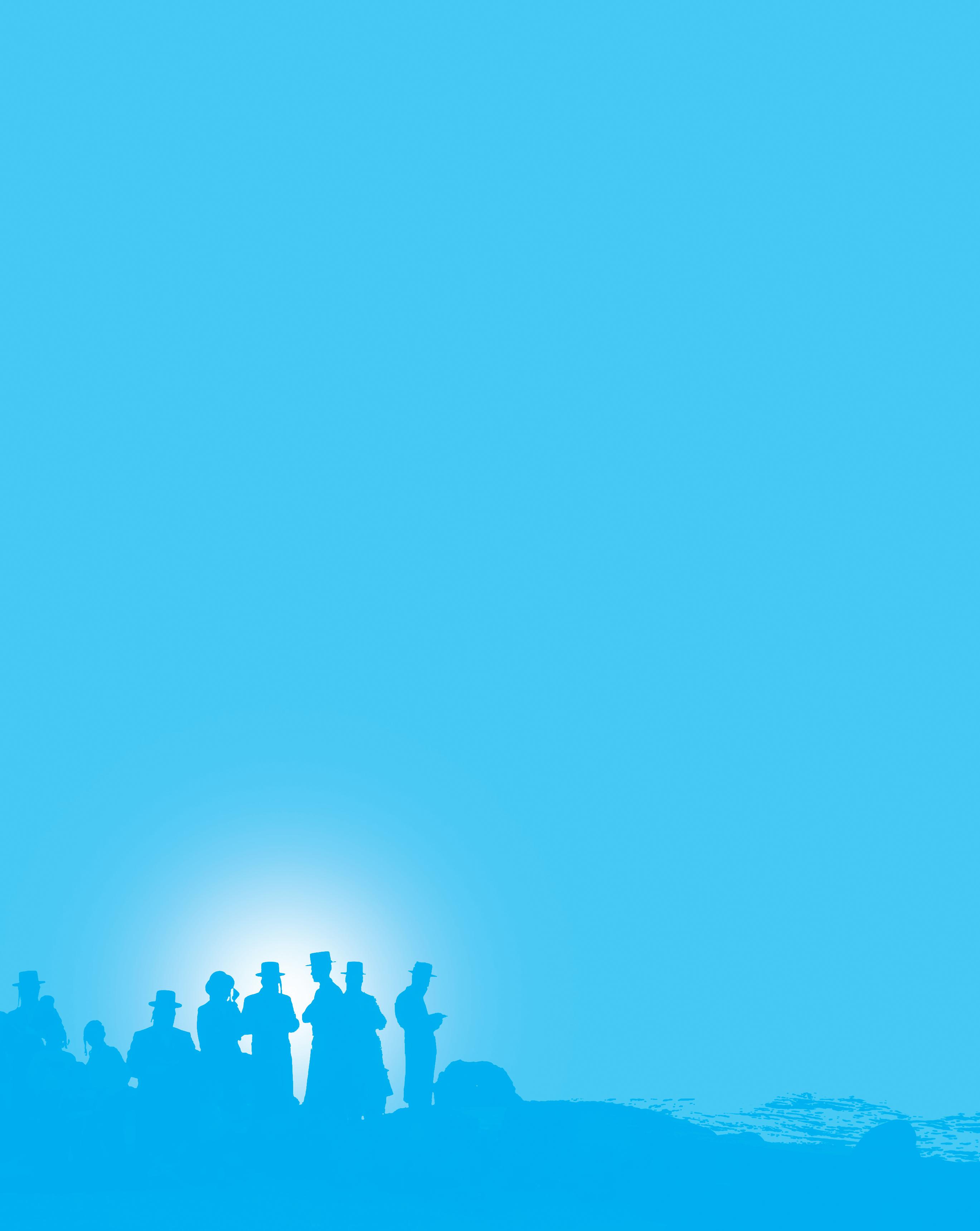
This realization is the impetus for a much more significant and better-founded question: What is so unique about this Possuk to have given rise to the custom of Tashlich when it is just a further iteration of our ongoing requests that our repentance be accepted? This may be the driving catalyst for the many explanations provided over the generations to explain Tashlich’s objective.
Ashkenazi Origins
The earliest explicit source
36 COLlive Magazine
for Tashlich is found in the writings of Rabbi Yaakov ben Moshe Levi Moelin, an early prominent Ashkenazi Posek known as the Maharil (not to be confused with the Maharal of Prague). He was a renowned Chazzan and composer of Piyuttim who lived in Germany at the beginning of the 15th century. He compiled a detailed description of Ashkenazi Minhag, which provided an authoritative source for future generations.
Tashlich, as recorded by the Maharil, is based on a known Midrash. He wrote, “This that we are accustomed on Rosh Hashana, after the meal, to go to the seas and rivers, to cast into the depths of the sea all of our sins, is on account of the Midrash (Vayera – Yalkut §99, Tanchuma §22) in which Avrohom our forefather passed through the river up to his neck on the way to the Akeidah, after that he recited the verse (Tehillim 69:2), ‘Save me Hashem, for the waters have come until my very soul,’ a reference to the Satan who assumed the guise of a river to prevent the Akeidah.”
It is evident from the Maharil’s words that Tashlich was widespread during his times, at least in the Maharil’s locale. The fact that Tashlich was a firmly established rite in the Ashkenazi world is apparent in all subsequent Halachic literature, including the Remo in Shulchan Oruch (O.C. 583:2). The only Ashkenazi resistor seems to have been
the Vilna Gaon and his followers (who also rejected the custom of Kapparos), notably Rabbi Chaim of Volozhin and the Chayei Adam. Even so, in the present day, almost all who generally follow the traditions of the Vilna Gaon nevertheless perform Tashlich.
Earlier Echoes
While there is no explicit mention of Tashlich in the
(an ancient Greek city at what is now Bodrum in Turkey) issued an edict guaranteeing Jews the right to “perform their holy rites according to the Jewish laws and to have their proseuchae (places of prayer) by the sea, according to the customs of their forefathers.”
Gemara, nor in the writings of the Geonim, there are precedents for davening next to the water, which long predates medieval times.
The Jewish philosopher Philo, who lived in Egypt shortly before the destruction of the second Beis Hamikdash, mentions that Alexandrian Jews davened at the seashore during troubled times. The non-Jewish author Tertullian (160-220 C.E.) writes about Jews organizing davening at seashores or riverbanks. The historian Josephus (Antiquities of the Jews 14:10, §23) tells us that the town of Halicarnassus
Furthermore, the Geonim tells us about an ancient custom that existed already in the times of the Gemara and exhibits elements of both Tashlich and Kapparos. Rashi (Shabbos 81b) writes: “I discovered in Geonic responsa that they used to fashion baskets from palm leaves and fill them with earth and manure. These were made twenty-two or fifteen days before Rosh Hashana, one for each boy and girl in the house, and sown with Egyptian lentils or peas. They called this a porpissa. It would grow, and on the day before Rosh Hashana, each one would take his own basket, circle it around his head seven times, and say, ‘This instead of me, this is in place of me, and this is in my stead.’ And he would then cast it to the river.”
Sephardic acceptance
Originally, Tashlich was practiced only among the Ashkenazim. This is apparent in the total silence of the Sephardic Rishonim regarding any such practice, as well as its omission by Rabbi Yosef Karo, both in Shulchan Oruch, as well as in his work that underpins it, Beis Yosef. A significant cause of its subsequent spread into

ROSH HASHANA Tishrei, 5784 37
“You shall cast into the depths of the sea all their sins.”
(Micha 7:19)
most Sephardi populations (aside from specific Yemenite communities) was the spread of the Kabbalistic customs of the Arizal, Rabbi Yitzchak Luria (1534-1572). In Shaar Hakavonos, his student Rabbi Chaim Vital writes: “The custom of the Ashkenazim on the first day of Rosh Hashana, after Mincha but still a little before sunset, in which they go to the ocean or spring, or well of living water, and they call it Tashlich – this is a beautiful minhag.”
The Shaar Hakavanos (cited by Magen Avraham 583:5) is also the earliest source to recommend that Tashlich be done outside city limits.” Although there can be no doubt that this recommendation is based on Kabbalistic considerations and other reasons, Sefer Minhag Yisroel writes that this preference might also have a historical basis.
Non-Jews who observed the Jews at Tashlich might imagine that the Jews were poisoning their water sources. This preposterous claim provoked many a pogrom during the Bubonic Plague (Black Death) era in the 14th century. It is possible that suspicions such as these provoked the populace of the Russian town of Mogilev into attacking its Jewish population during Tashlich in 1645 at the behest of their mayor.
Rabbi Yosef Yuzfa Neurlingen, writes in the 1630 work Yosef Ometz about the customs of the Jewish community in Frankfurt am Main: “It is the Torah custom of our forefathers to perform Tashlich... this custom has been widespread here throughout the ages, until
by the forces of Revolutionary France in 5555 (1795), a client state known as the Batavian Republic was established for a time, forbidding all religious practice in public (in the name of equality and not to be seen as a slight imposition on anyone else). As a result, it was announced
recent years... when the guards at the gate of the River Main were combative. As a result, this custom has become almost completely forgotten by the masses, and even the meticulous do not go there but to the water well.”

Problems also arose elsewhere. Following the invasion of the Netherlands
on Rosh Hashana 5557 (1796) in the central shul of Amsterdam that performing Tashlich as a group would be forbidden, and it should only be recited individually. This edict contributed to Tashlich’s abandonment by most of Amsterdam’s Jews, even after the laws were repealed 17 years later. Kiddush Levana suffered a similar fate after being banned on 20 Elul 5556 (1796).
Other Explanations
Aside from the Maharil’s explanation cited at the beginning of this article, here are several more reasons:
1. In his work, Torah Haolah (3:56), the Remo explains Tashlich as follows: The depths of the sea demonstrate the existence of an all-powerful Creator who fashioned the world and ruled over it, for example, by
ROSH HASHANA 38 COLlive Magazine
The Hebrew word for fish, Dagim, is an acronym for Yud Gimmel Mechili Derachmi, the Thirteen Attributes of Mercy
placing a boundary between land and sea and not letting the oceans flood the earth. That is why we go to the oceans on Rosh Hashana, the Day of Judgement, so that we can perceive Hashem’s aweinspiring majesty and properly contemplate the Creation and Hashem’s exaltedness over it, which inspires us to repentance. The verse “You shall cast into the depths of the sea all their sins” should be understood in this vein – the “depths of the sea” are the medium through which one can come to recognize the glory of Hashem and thereby make amends. After that, his “sins will be cast away.”
2. The Shelah explains, based on the Zohar, that the “depths of the sea” represent the lowliest Kelipos, forces so evil that whatever falls to them is trapped forever, as irretrievably as whatever falls to the depths of the ocean. This assures us that, if we repent properly, our sins will be cast into the lowest level of Kelippos from where they can never resurface.
3. The Alter Rebbe explains in his Siddur that water is reminiscent of the level of Chassadim (the attribute of kindness). On Rosh Hashana, we perform Tashlich at its earthly counterpart, a place that represents the channel of Hashem’s abundant goodness to us, and we thus beseech Hashem to treat us with kindness during the new year.
Although this explanation is original, it may be another enigma predating it. The Remo, both in Darkei Moshe and in his glosses to Shulchan Oruch, presents Tashlich in what appears to be an unusual place. One would have expected the details of Tashlich to be positioned together with, or after, the laws of Rosh Hashana’s
of Shmuel Hanavi (I:7:2-7), in the period when the Plishtim returned the Aron they had captured after being afflicted by a plague. Subsequent to this, Shmuel urged the people to do Teshuvah: “If you return to Hashem with all your hearts, remove the foreign gods and Ashtaros from your midst, and direct your hearts to Hashem and serve Him alone, He will save you from the hand of the Plishtim.” The Jews heeded Shmuel’s cry and gathered at Mitzpeh where they “drew water and poured it out before Hashem; they fasted that day and said, ‘We have sinned against Hashem.’”
The Targum explains the verse as an allegory, saying that their hearts poured repentance like water.
Mincha (OC 598). Instead, the Remo records the custom much earlier (OC 583), alongside the list of all the special foods consumed on the first night of Rosh Hashana as a siman tov (good omen) for the upcoming year.
Why did the Remo insert the practice of Tashlich out of chronological order?
According to the Alter Rebbe’s explanation, we can perceive how the custom of Tashlich indeed serves as a good omen for the new year.
In contrast, Rashi explains that the people poured water as a sign of humility (since water always flows to the lowest level) as if to say: ‘Before You, we are like this spilled water.’
The ceremony of Tashlich near water evokes this episode and reminds us to repent with humility.
5. The Rashban (Rav Shlomo Tzvi Shick, a student of the Maharam Shick) finds another scriptural connection: The book of Nechemiah

ROSH HASHANA Tishrei, 5784 39
4. The Beis Meir (OC 583) traces the purpose of Tashlich to the times
Jewish kings are anointed next to springs of water
(8:1-3) describes how the Jews observed Rosh Hashana after rebuilding the walls of Yerushalayim: “On the first day of the seventh month, Ezra the Kohein brought the Torah before the congregation... and read from it at the street that was before the water gate.” The Rashban asserts that this Rosh Hashana ceremony
of performing Tashlich near a body of water in general, several sources indicate that fish should inhabit it. Here, too, there are a range of reasons:

1. The Remo (Darkei Moshe OC 583) offers an explanation based on the Sefer Minhagim of Rabbi Tirna: Fish are not subject to Ayin Hara (“evil eye”), and they rear offspring
and nothing can be hidden from Him. By the same token, we derive courage and hope that He mercifully cares for us at all times.
4. Others explain that the Hebrew word for fish, Dagim, is an acronym for Yud Gimmel Mechili Derachmi, the Thirteen Attributes of Mercy, which we recite during Tashlich and ask Hashem to bestow upon us. That Easy?
So, by saying Tashlich, do we really divested ourselves of our sins and reverted to a clean slate?
occurring next to the water gate was no coincidence. Since Rosh Hashana is the day we coronate Hashem as King of the Universe, invoking water to parallel the Halacha that Jewish kings are anointed next to water springs is appropriate.
The Maharshak (R’ Shlomo Kluger) further develops this approach: Kings are anointed next to springs of water to signify that their reign should be crowned with continuity, just as a spring flows continually. Similarly, Tashlich reminds us that our act of crowning Hashem as our King should leave us with a lasting impact that we keep on feeling throughout the year.
Reasons for Fish
In addition to the significance
in abundance. Thus, they represent our request that we proliferate like fish and that we remain protected from and immune to Ayin Hara.
2. The Levush, a student of the Remo, provides yet another link between fish and Rosh Hashana – fish can get trapped in a net at any moment. The precariousness of their lives reminds us that a human being can similarly be ensnared in the net of death and judgment, and this awareness should awaken us to repent.
3. The Shelah focuses on the fact that fish do not have eyelids, and their eyes are always open. This is likened to Hashem’s constant supervision over us, “He who neither slumbers nor sleeps,”
It should be clear that this is certainly not the case. True repentance and connection with Hashem require firm steps and resolute efforts on our part. Tashlich helps us achieve this by fortifying us with many important tools and messages, but we need to discover them to unpack them and harness them in serving Hashem.
May this be the year when we achieve all that and much more, with the coming of Moshiach speedily in our days.
-- Rabbi Shmuel Lesches is Rov of Young Yeshivah Shul and Maggid Shiur of the Yeshiva Gedola of Melbourne, Australia. He regularly publishes Laws & Customs According to Minhag Chabad. A version of this article was originally published in the Young Yeshiva Magazine Issue 29.

ROSH HASHANA 40 COLlive Magazine
the “depths of the sea” are the medium through which one can come to recognise the glory of Hashem

779 East New York Ave | 718.260.4670 • Pediatric & Adult Medicine • Podiatry • Brand New Facility • State-of-the-art Equipment • Open 8a.m. - 8p.m. Care made personal. We merged ER Medical and Crown Medical into an empire of healthcare:
The Chossid who was always there
R’ Meir Harlig and the last Sukkos with the Rebbe
 By Dovid Zaklikowski
By Dovid Zaklikowski
It was the first day of Sukkos 5752 (1991) in Crown Heights. Chassidim and bochurim were rushing to leave their homes early to go to the mikvah. The hurry was to get a ticket to secure a place
on line to make a bracha and shake the Rebbe’s lulav and esrog. It would be a short wait for those lucky enough to be the first. The alternative was to stand in line later that morning or even after Shacharis.
The chossid overseeing that process was Reb Meir Yehuda Yisroel Harlig, the chossid who was always present at 770 Eastern Parkway. Reb Meir, who recently passed away, merited to serve as a gabbai in
Reb Meir standing near the Rebbe shortly before leaving after a farbrengen.
its main shul, and be of service (meshamesh) to the Rebbe.
Every year, the Rebbe would recite a bracha on his set of Daled Minim in his sukkah, which stood in the courtyard of 770. “I would wait outside of the Rebbe’s sukkah,” recalled Reb Meir in a 2001 interview. “The Rebbe would open the door and give me his set.”
Reb Meir was born in 1936 to Rabbi Mordechai and Rebbetzin Bina Harlig in Switzerland, where his maternal grandparents resided. His father later served as a rov in Vienna, Austria, which was his mother’s childhood home. When the German Nazis invaded the country, the family fled to the United States. His father became the rov in the Borough Park shul of Linas Hatzedek and later in Beth David in Crown Heights.
The young Meir learned in the United Lubavitcher Yeshivoth, strengthening his father’s ties with Lubavitch. From early on, Reb Meir’s presence, dedication and discretion were noticed by the Rebbe. It began in the early 1950’s When the Rebbe asked Reb Meir to assist in simple matters, such as finding a sefer or keeping watch after the bag of panim during a break on Yom Kippur to ensure that the requests for blessings that people have sent to the Rebbe remain private.
Reb Meir’s uninterrupted time in 770 gave him front-row seats to important events in
recent Chabad history and many personal anecdotes with the Rebbe. Once, Reb Meir announced that a farbrengen with the Rebbe would be taking place in the “shul downstairs,” to which
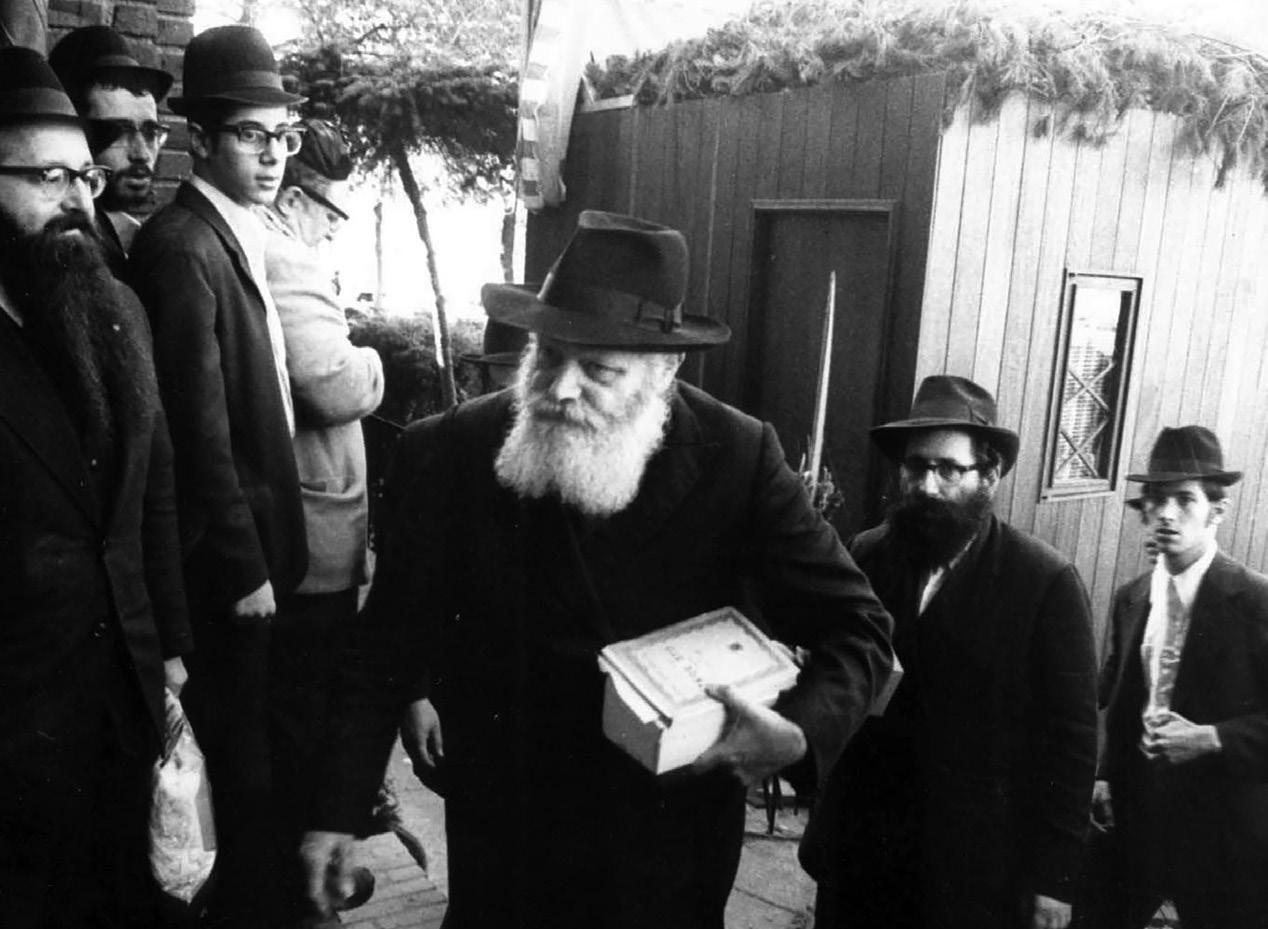
also meticulous on attending the Farbrengens of the Rebbe where he was in charge of the wine and challah for the Rebbe. Once, a Bris Milah of his grandson was going to be held on Shabbos. Since his
the Rebbe commented that on a shul, “You do not say downstairs.” Or when the Rebbe walked into shul to daven Maariv and asked if they would begin to say the winter bracha of “Vesein tal umatar.”
When Reb Meir responded that he “thinks so,” the Rebbe said, “Either it is a yes or a no.”
Reb Meir was the organizer of the large farbrengens at 770 to celebrate auspicious days on the Chassidic calendar. He was
son lived on Shlichus, he wrote to the Rebbe that “because there is a farbrengen, I will stay here”, and only his father would travel for the simcha.
Reb Meir later told that the Rebbe’s response, as told to one of the secretaries, was: “How could he think of acting this way? A Shliach is making a Bris, and while he is there, he should converse with the community and bring them closer to Yiddishkeit. Is he
MEMORIAM Tishrei, 5784 43
In 1966, the esrog became unfit to use. Reb Meir recalled going over to the Rebbe in shul, asking what to do
going to miss this opportunity because of a fabrengen? When he returned, he could read a transcript of everything that was said (i.e. the sichos and maamarim).”
The Ruined Esrog
One of Reb Meir’s most known roles was giving the Rebbe’s lulav and esrog to the public

Rabbi Hadakov brought Reb Meir to the Rebbe’s office and then left the room. The Rebbe then told Reb Meir, “Do not come late tomorrow. Here are the lulav and esrog. Take them and watch them, so you can give them to everyone to bentch on in the morning. When I come from home, bring them to me (to recite a bracha). Afterward, I will give it back,
wrote to the Rebbe asking why he gave such a lofty position to such a young man. The Rebbe responded, “Where were you when he was saving my time? Only now you are writing?”
Over the years, Reb Meir had several interesting interactions with the Rebbe around the bentching of the lulov and esrog. In 1966, the esrog became unfit to use. Reb Meir recalled going over to the Rebbe in shul, asking what to do. The Rebbe told him to go home and ask the Rebbetzin for her esrog for him to use.
on Sukkos. It was a task he always avoided. One Sukkos, the Rebbe’s chief of staff Rabbi Chaim Mordechai Hodakov called for Reb Meir. The previous night, foul language was used at a farbrengen and Reb Meir was certain that Rabbi Hodakov was looking to inquire about details, so he ignored the request. Only after several more persistent dispatches did Reb Meir go to meet Rabbi Hodakov.
and you will continue with the others.”
Until then, from Sukkos 1951, the Rebbe would stand in the Sukkah personally handing each person the lulav and esrog. Reb Meir would later say that he was shocked and could not understand why the Rebbe chose him. But he did as he was told. Reb Meir said he heard decades later that one of the elder chassidim
After davening, the Rebbe usually gave the set for people to continue to bentch. That year, the Rebbe said it was not his esrog to give to others. Only after the last time the Rebbetzin bentched on Hoshana Rabbah, did the Rebbe give it to Reb Meir.
Another time, Reb Meir told the Rebbe that someone by mistake had ruined the esrog. The Rebbe told him, “I do not want to know who did it - for it is not good for him or me.” Instead, the Rebbe gave another esrog to be used.
On Sukkos 1976, while everyone was bentching, the Rebbe called him to his Sukkah and said that he needs Rabbi JJ Hecht, “Had he already come this morning to bentch?” When he responded that he did not, the Rebbe said that he needed to inform about something, “If you see him, let him bentch and then send him to me.”
MEMORIAM 44 COLlive Magazine
Reb Meir leads the Rosh Chodesh Kislev farbrengen.
The Rebbe walked through the larger Sukkah to the small one. There was great confusion, and the scene was of surprise and trepidation
Reb Meir knew, from past years, that Rabbi Hecht would not come to make the brachah. Not wanting the Rebbe to wait, he went to the Rebbe at 9:15 to tell him that Rabbi Hecht had not come yet, “But I know that in his shul they are already started davening, and he most probably won’t come this morning. If the Rebbe wants, I will send someone to his shul to let him know.”
The Rebbe said that they could inform him after davening. When one of his children came to bentch he let him know that the Rebbe was looking for his father. The son let Rabbi Hecht know. After davening he came to 770 from his shul in East Flatbush. The Rebbe told him that he wants to make a rally for children on
not go to the Ohel until he was informed that a set was arranged for her.
In 1975, it was pouring in the
minute, but the Rebbe said, “I just came from the house and saw the large crowd waiting. There are also some elderly people that most probably did not eat yet. First let them bentch, so they can eat. I could wait until later to eat.”
Dramatic news
chol hamoed, especially public school students who attended Released Time, in the Sukkah.
Before Sukkos, at the Rebbe’s directives, someone would prepare a set for Rebbetzin Chana, which her aide would also bentch on. When she passed away in 1964, it was shortly before Sukkos, and the Rebbe wanted to know if they prepared for the aide a set for her to bentch on. When no one could give a straight answer, the Rebbe said that he would
morning. While the lulav would be fine, the esrog, Reb Meir thought, would not be. He told the Rebbe, that perhaps they should bentch inside that day.
The Rebbe responded, “You know that you need to bentch in the sukkah.”
Reb Meir would prepare something for the Rebbe to eat and drink after he bentched. One time, after the Rebbe bentched, Reb Meir wanted to give the Rebbe what he had prepared. It would only take a

In 1990, a bridge connecting 770 with the next door was built over the courtyard where the large communal Sukkah was erected. That year, on the side closer to Union Street, a small sukkah was erected to bentch on the Rebbe’s set. This made the line more organized and blocked those standing on it to see what was happening inside where the people were bentching.
Two thousand tickets were distributed that morning. Those with one and two
MEMORIAM Tishrei, 5784 45
Reb Meir brings the Rebbe his lulov and esrog back before Hallel.
One of Reb Meir most known roles was giving the Rebbe’s lulav and esrog to the public on Sukkos. It was a task he almost missed
digits began to form a line on the path leading to Union Street. They would have to quickly shake the lulov, as the davening would start on time and the Rebbe would need his set back for Hallel. Being the first time that year that they would bentch, and on the set the Rebbe had just bentched a few minutes prior, those on the line were deep in contemplation about the mitzvah and their zechus.
But, on that Sukkos morning, the first ones in line had a bolt
how the gathered make them.”
The Rebbe walked through the larger Sukkah to the small one and placed his set on the table. There was great confusion, and the scene was of surprise and trepidation.
Zalmon Jaffe, the Manchester businessman who was a fixture in 770 during the Tishrei moths, wrote in his diary, “I was becoming a trifle bemused. All the top brass seemed to be present this morning! I went up to [Rabbi]
want to wait in the long line, came.
Those who were celebrating Sukkos for the time were encouraged to go on the line too. To one person who did not know how to say the brachos, the Rebbe helped him say them as he himself read it from the siddur. To those who it was hard for them to say the bracha, and felt the pressure from the ushers and the others behind them to rush, the Rebbe calmed them by wishing them gut yom tov.
When someone tried to skip the line, Reb Meir recalled, “The Rebbe gave them a look, as if to say, ‘Why do you think that it is not befitting for you to stand in line with everyone?’”
from the blue awaiting them. There the Rebbe was standing, and watching them make the brachos. In shock, one held the esrog upside down, another forgot to say one of the brachos, and yet another forgot to pick up the lulav. Patiently, the Rebbe watched each one say the blessings, corrected those nervous, and responded amen on the brachos.
News spread quickly. Like every year, the Rebbe went from his room to his Sukkah in the front garden of 770 at 8 in the morning. Reb Meir waited at the door for the Rebbe to open and give him the set. Ten minutes later when the Rebbe emerged, the Rebbe told him, “Where do they make the blessings? Today, I want to see
Leibel [Groner] and enquired in a loud, cheerful, voice, ‘Hello Leibel! Are you here as well?’”

When it was his turn, Reb Meir handed him the set, and he wrote that he discovered that someone was standing in the background. “He looked like the Rebbe. It was unbelievable! I stared very hard and realized that ‘My word! It was the Rebbe.’ My eyes showed complete amazement and almost total disbelief at what I was seeing.” The Rebbe noticed and wished him a gut yom tov.
After the first went by, those on the line were informed that the Rebbe was there, and people began to prepare themselves spiritually. Soon, the entire neighborhood, even those who would typically not
The Rebbe dismissed those who suggested that he should go to daven or sit down. Jaffe wrote that when someone asked when they would daven, the Rebbe responded today. It would be “today,” but only when everyone finished having a chance to bentch. By the time everyone finished, it was after 3 in the afternoon. It had been seven hours. It would also be the last Sukkos everyone celebrated with the Rebbe before having a debilitating stroke. May we merit to shake the Rebbe’s lulav and esrog again speedily in our days.
MEMORIAM 46 COLlive Magazine
-- Dovid Zaklikowski is a biographer. His books can be found in local Jewish bookstores or at HasidicArchives.com. He could be reached at DovidZak@ gmail.com
From early on, Reb Meir Harlig’s presence, dedication and discretion were noticed by the Rebbe
The Future of Fundraising is Here.

Moments with the Rebbe
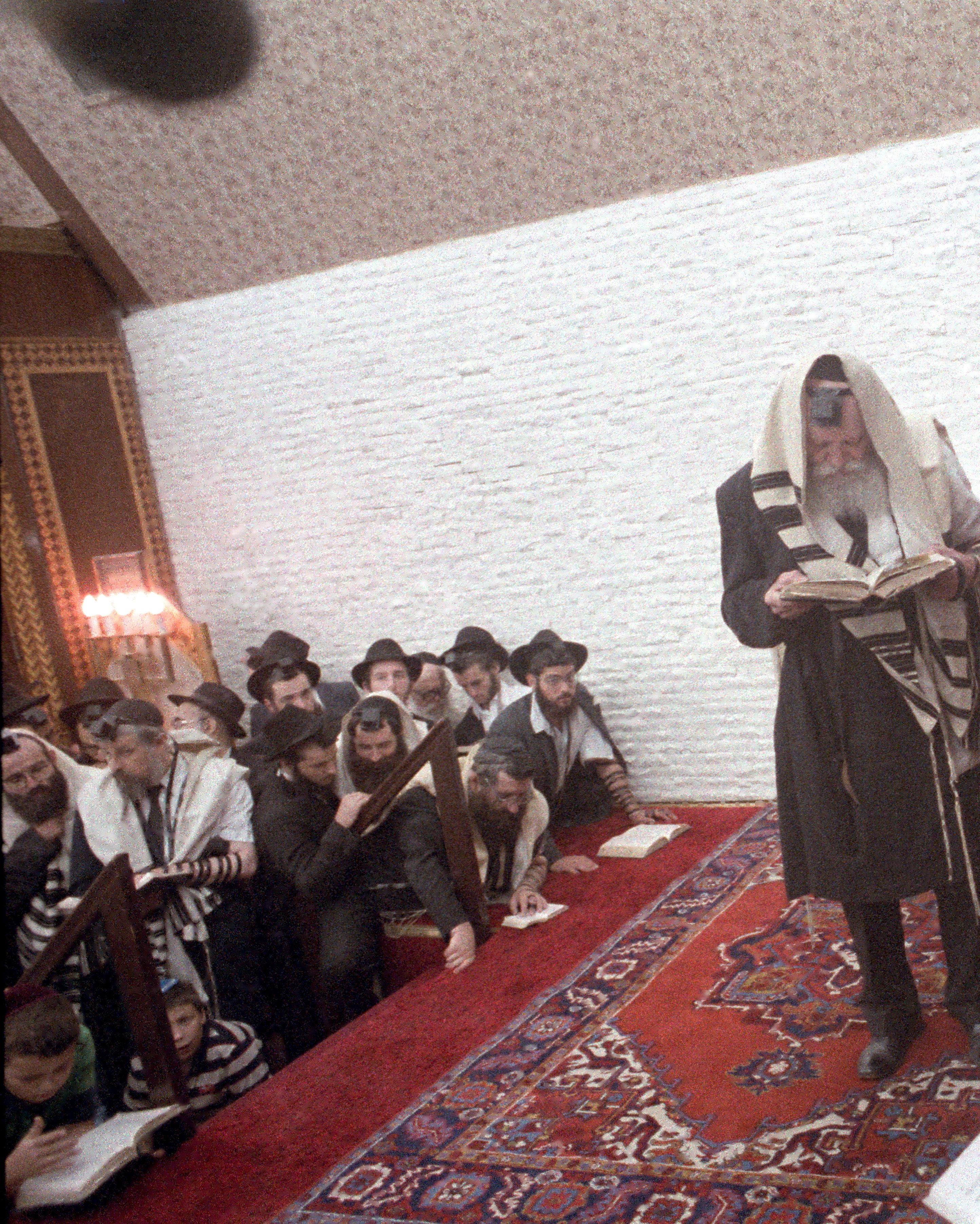 PRESENTED BY JEM
PRESENTED BY JEM
48 COLlive Magazine
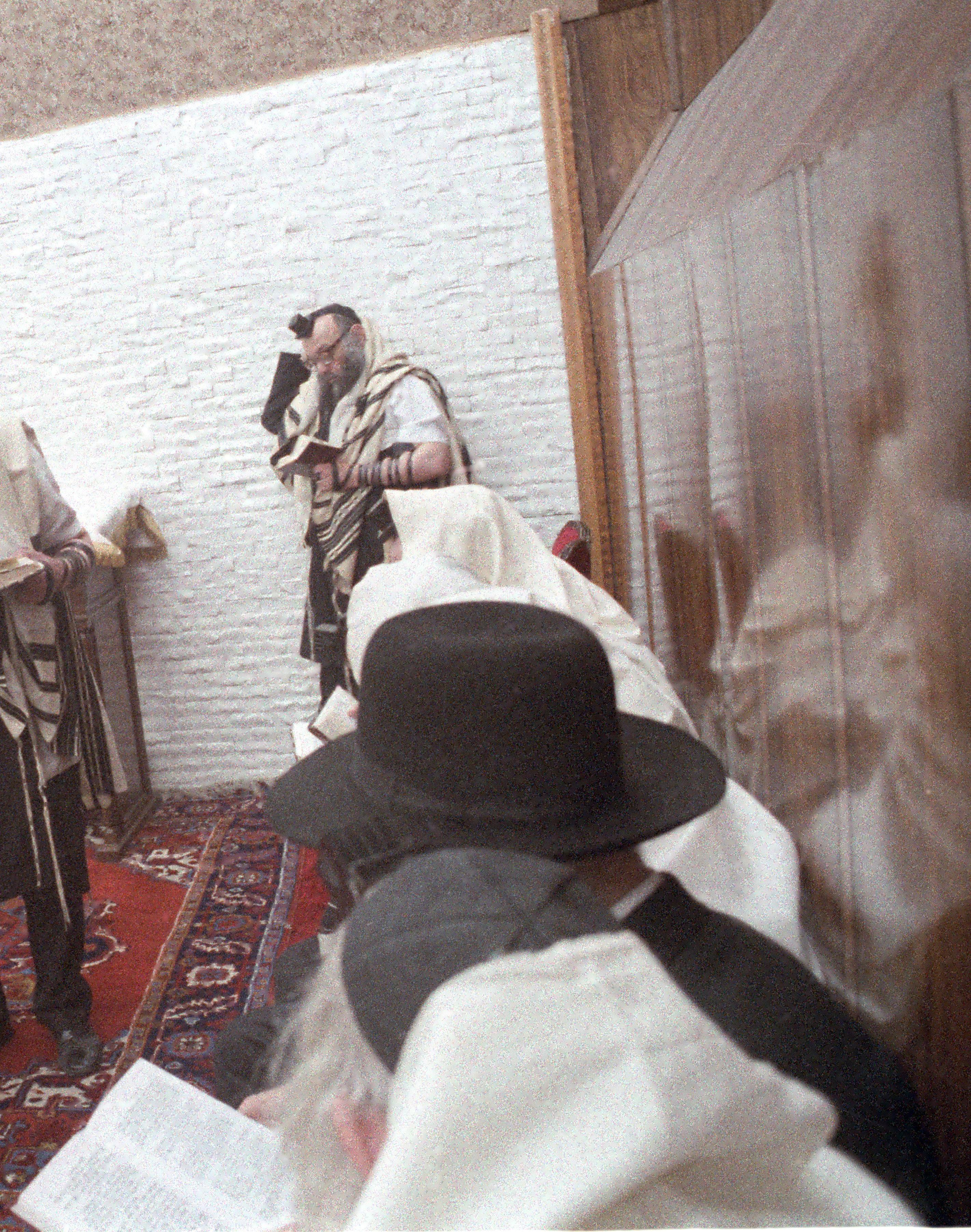
FLASHBACK Tishrei, 5784 49
Hataras Nedarim
The Rebbe recites Hataras Nedarim on Erev Rosh Hashana before a group of distinguished Rabbis seated on the right.
As the Rebbe walks to his car to go to the ohel on Erev Rosh Hashanah, he hands out coins to children to give to tzedaka. The Rebbe spent hours at the ohel reading thousands of panim, and returned to 770 shortly before shekiah

The Rebbe receives panim from people on Erev Rosh Hashana. The Rebbe would place a few bags of these panim next to him when he blew Shofar on Rosh Hashana

FLASHBACK 50 COLlive Magazine
Panim
En-route Ohel
Haftorah at Mincha
The Rebbe reads the haftorah during Mincha of Tzom Gedalya. After Mincha, the Rebbe delivered a sicha about the significance of Tzom Gedalya being pushed off because of Shabbos and the wish that it be pushed away forever with the coming of Moshiach


Rebbetzin Chana’s Yartzait
The Rebbe davens for the amud in honor of his mother, Rebbetzin Chana’s, yartzeit on Vov Tishrei
FLASHBACK Tishrei, 5784 51

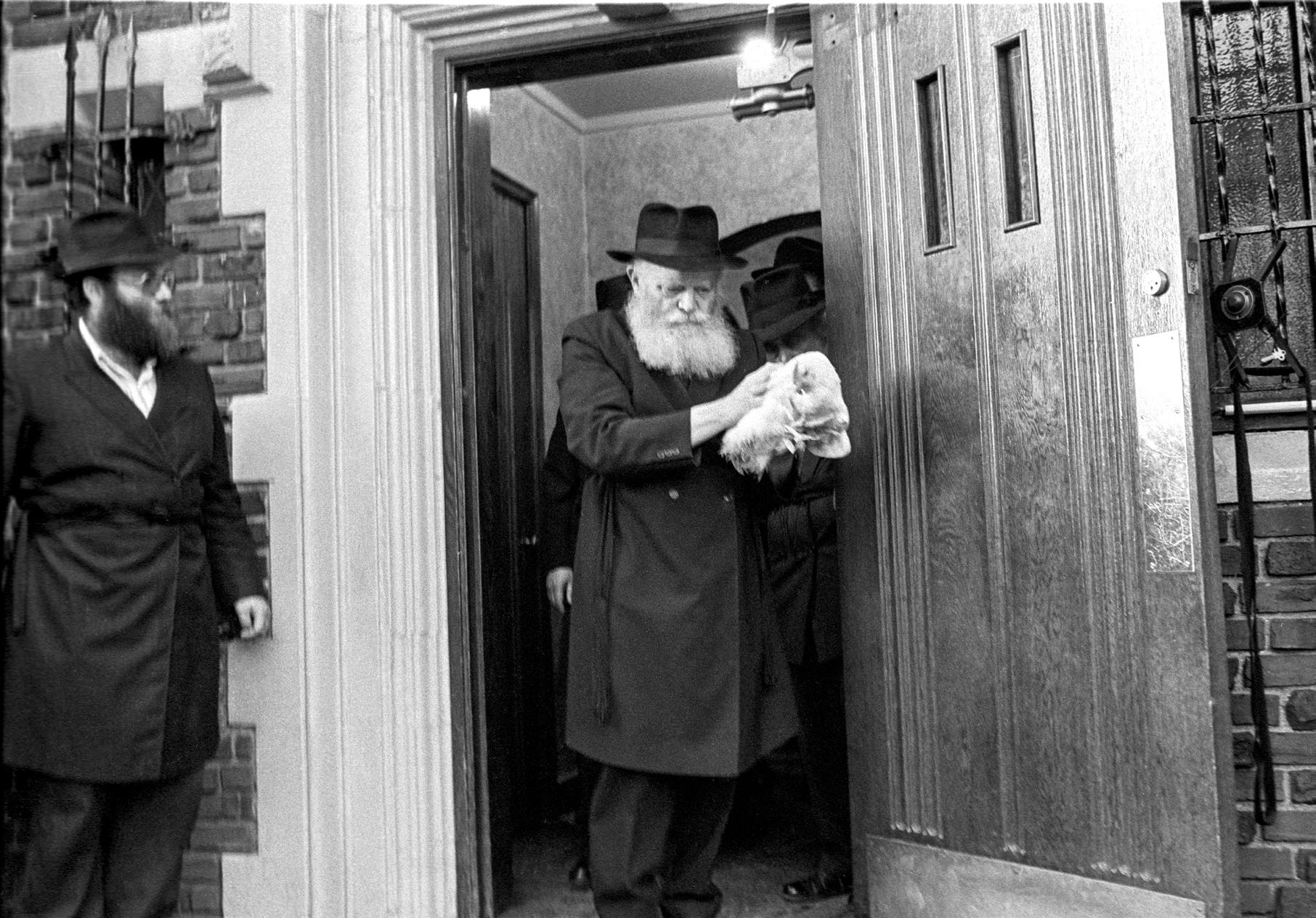
FLASHBACK 52 COLlive Magazine
Kaporos
The Rebbe carries a chicken for kapporos on Erev Yom Kippur
Mincha
The Rebbe gives tzedaka before Mincha on Erev Yom Kippur.
The Rebbe smiles as he hands lekach to a person on Erev Yom Kippur. For over two hours, the Rebbe gave out lekach to the hundreds of people waiting on line, wishing each one a “leshana tova umesuka”.
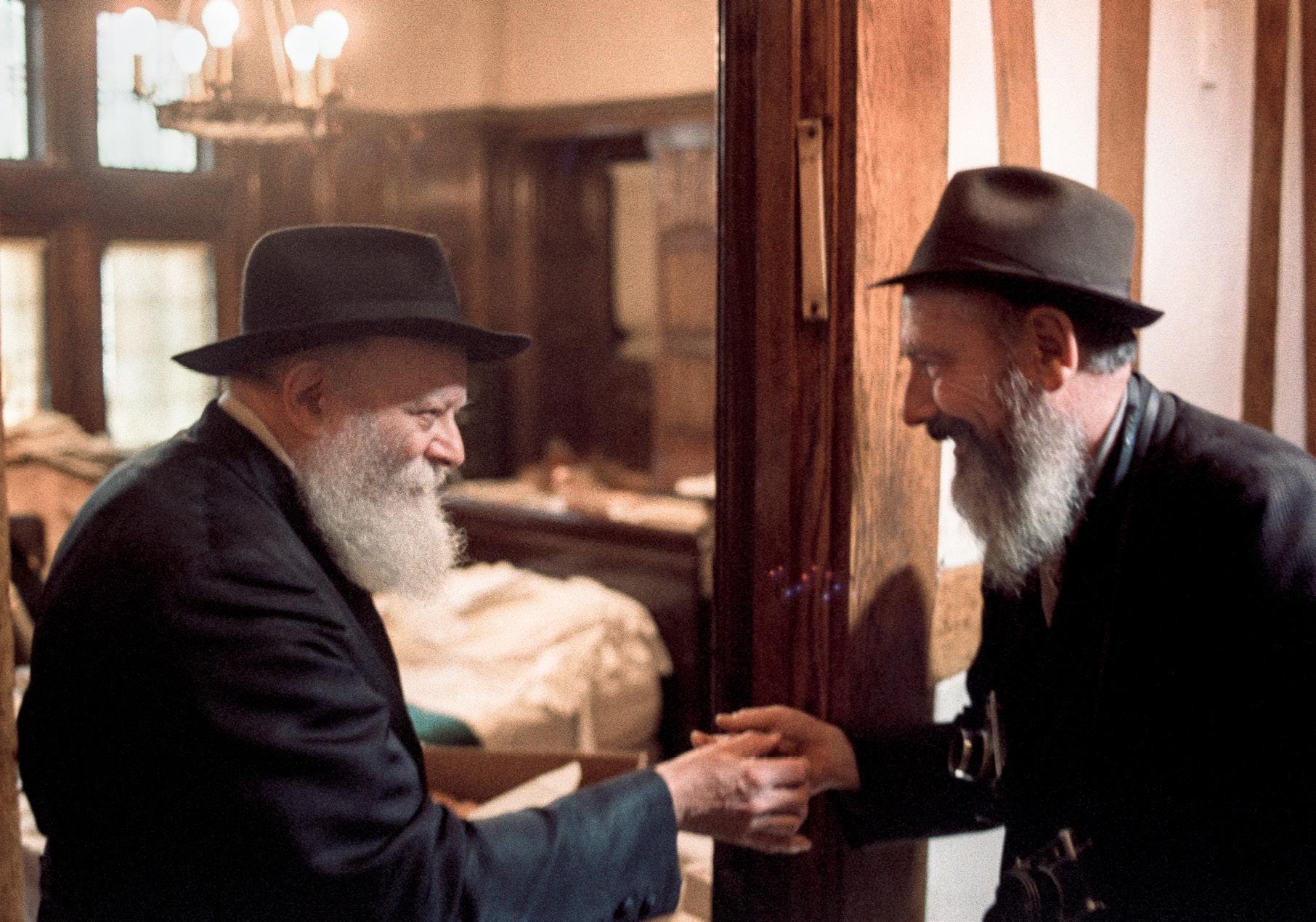

Tishrei, 5784 53
FLASHBACK
Lekach
Returning to Room
The Rebbe Returning to his Room after Yom Kippur
The Rebbe walks to the Sukkah outside 770 to bentch luav and esrog
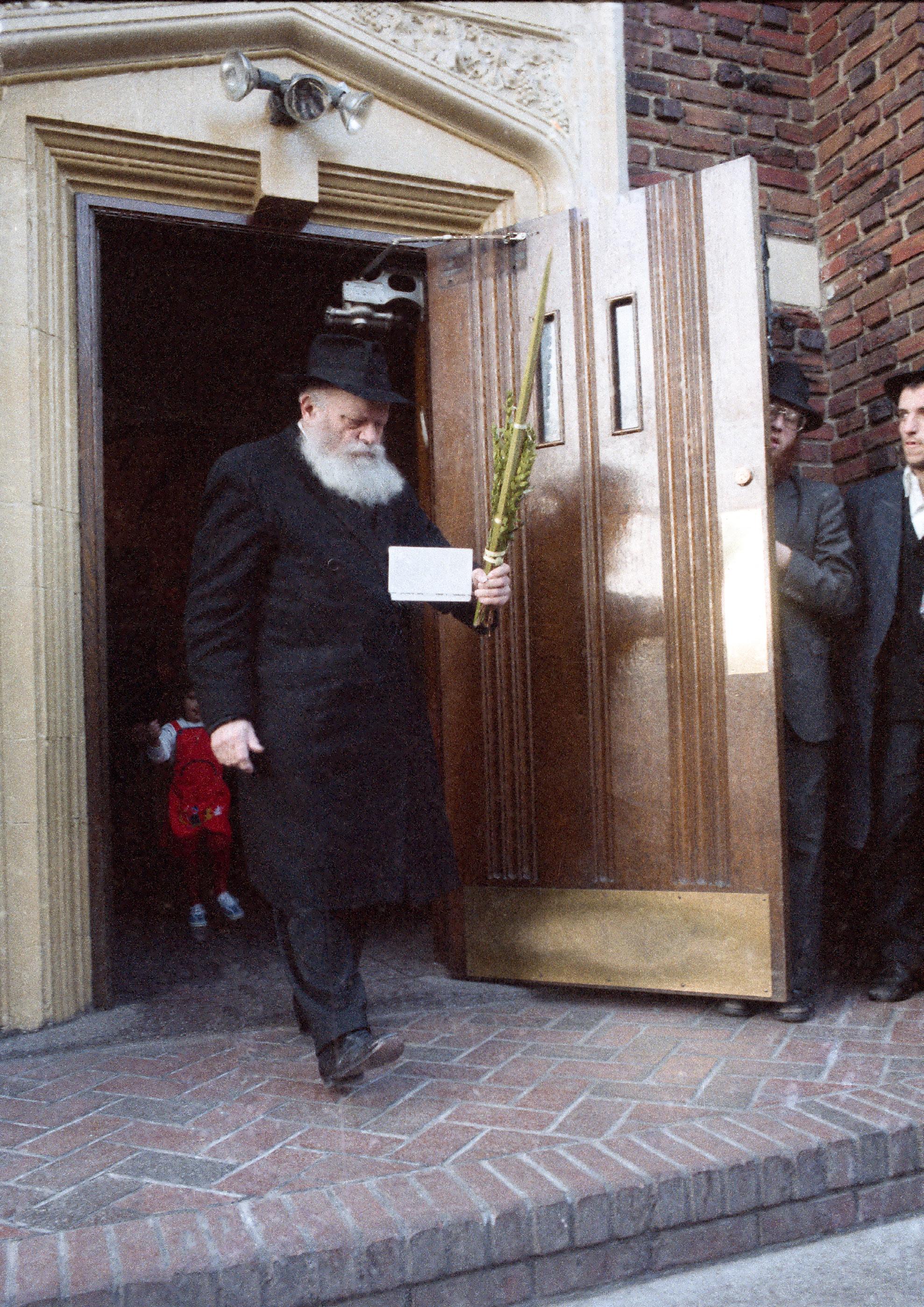
FLASHBACK 54 COLlive Magazine
Going to Bentch Lulav and Esrog
Using the Rebbe’s Lulav and Esrog
On Sukkos, Chassidim would merit to bentch lulav and esrog with the Rebbe’s lulav. In this picture, Rabbi Meir Harlig the Rebbe’s lulav and esrog to a bochur


FLASHBACK Tishrei, 5784 55
Hoshanos
The Rebbe circles the bima holding his lulav while reciting hoshaynos on Hoshana Rabba.
Children’s Rally
The Rebbe enthusiastically encourages the singing of Sheyibane at the Tzivos Hashem rally for children on Chol Hamoed Sukkos. enthusiastically encourages the singing of Sheyibane at the Tzivos Hashem rally for children on Chol Hamoed Sukkos


FLASHBACK 56 COLlive Magazine
Children’s Rally
A girl leads the large crowd in reciting a possuk at the Tzivos Hashem rally on Chol Hamoed Sukkos. In the sicha that followed, the Rebbe explained how each of the four minim represent a different weapon that the soldiers of Tzivos Hashem must use to battle the Yetzer Hara.
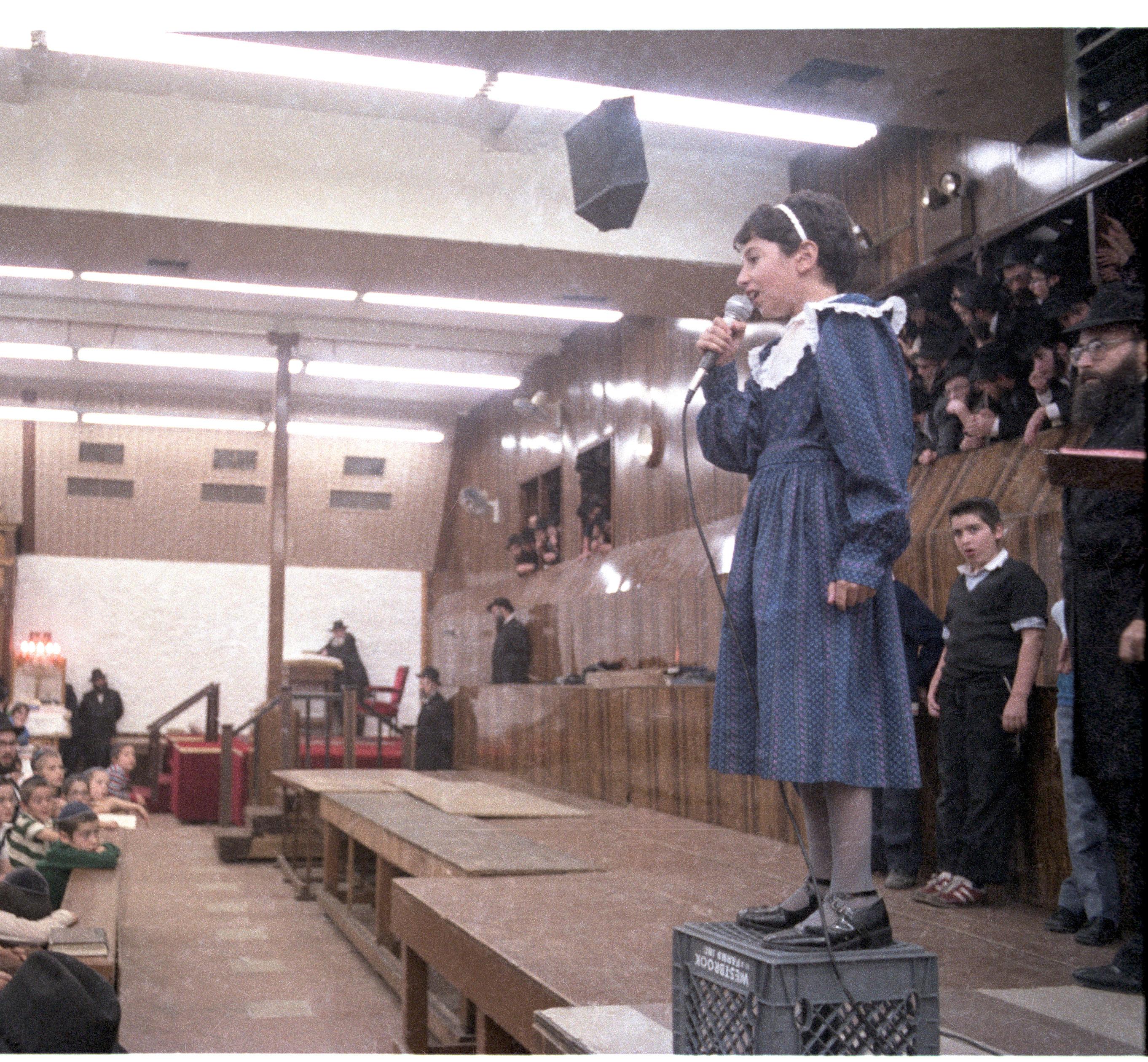
FLASHBACK Tishrei, 5784 57
In keeping with the Rebbe’s instruction that there be dancing each night of Simchas Beis Hashoeva, chassidim dance the night away on the streets of Crown Heights

Lekach
The Rebbe hands out lekach on Hoshana Rabba to those who did not receive on Erev Yom Kippur

FLASHBACK 58 COLlive Magazine
Simchas Beis HaShoeva
The Rebbe hands a dollar to a young girl as he leaves the main Shul after the Yechidus Klolis for guests who had come for Tishrei
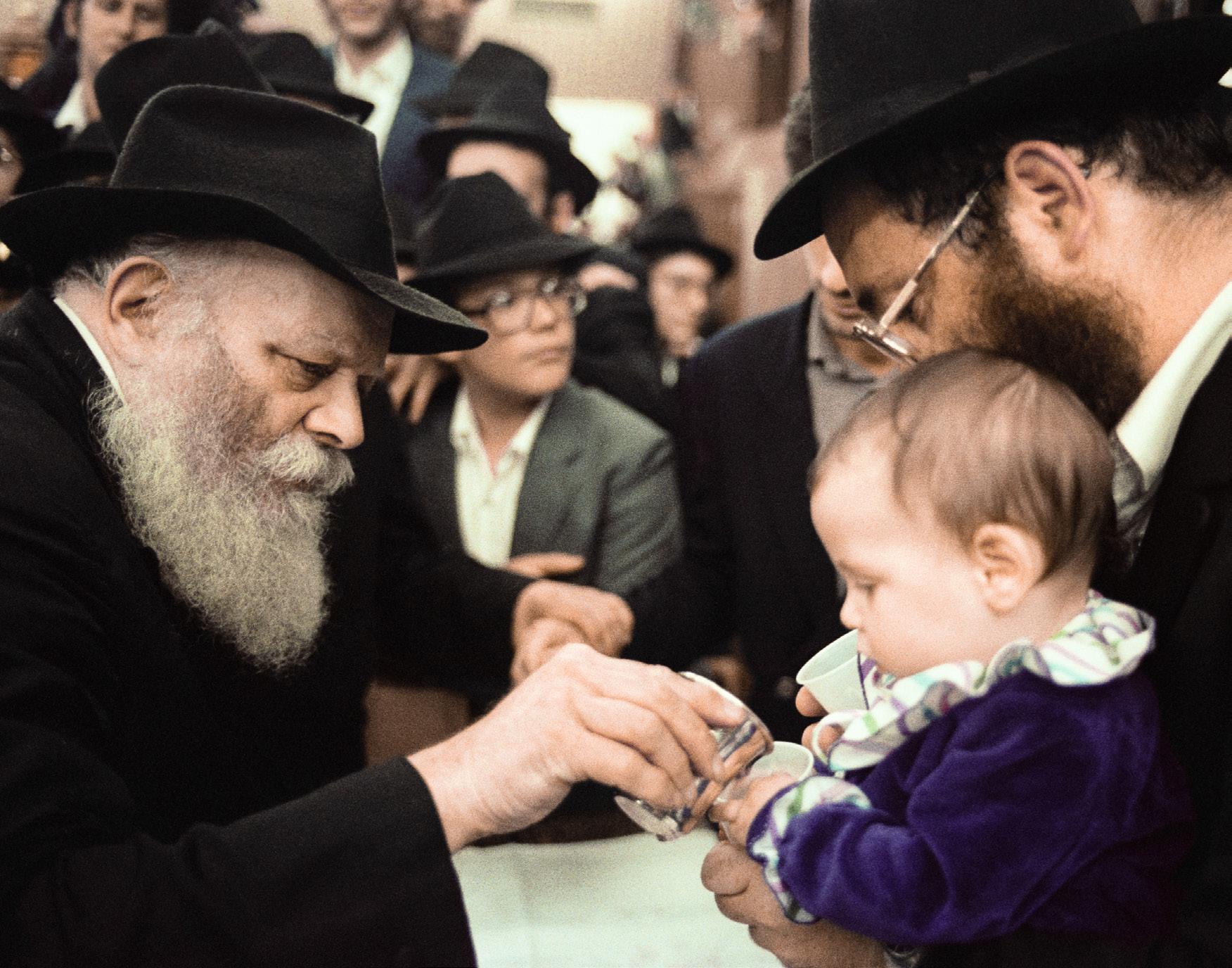
After an exhilirating three day Yom Tov packed with dancing, tahalucha and farbrengens, the Rebbe pours kos shel beracha to thousands of chassidim on Motzei Yom Tov

FLASHBACK Tishrei, 5784 59
Kos Shel Bracha
Yechidus Klolis
Rayim Ahuvim: Past and very present
By Sara Spielman
The story of the Rayim Ahuvim Shul is one that reflects the changes of the past century, beginning from its early days in Brownsville before settling in more recent decades in Crown Heights.
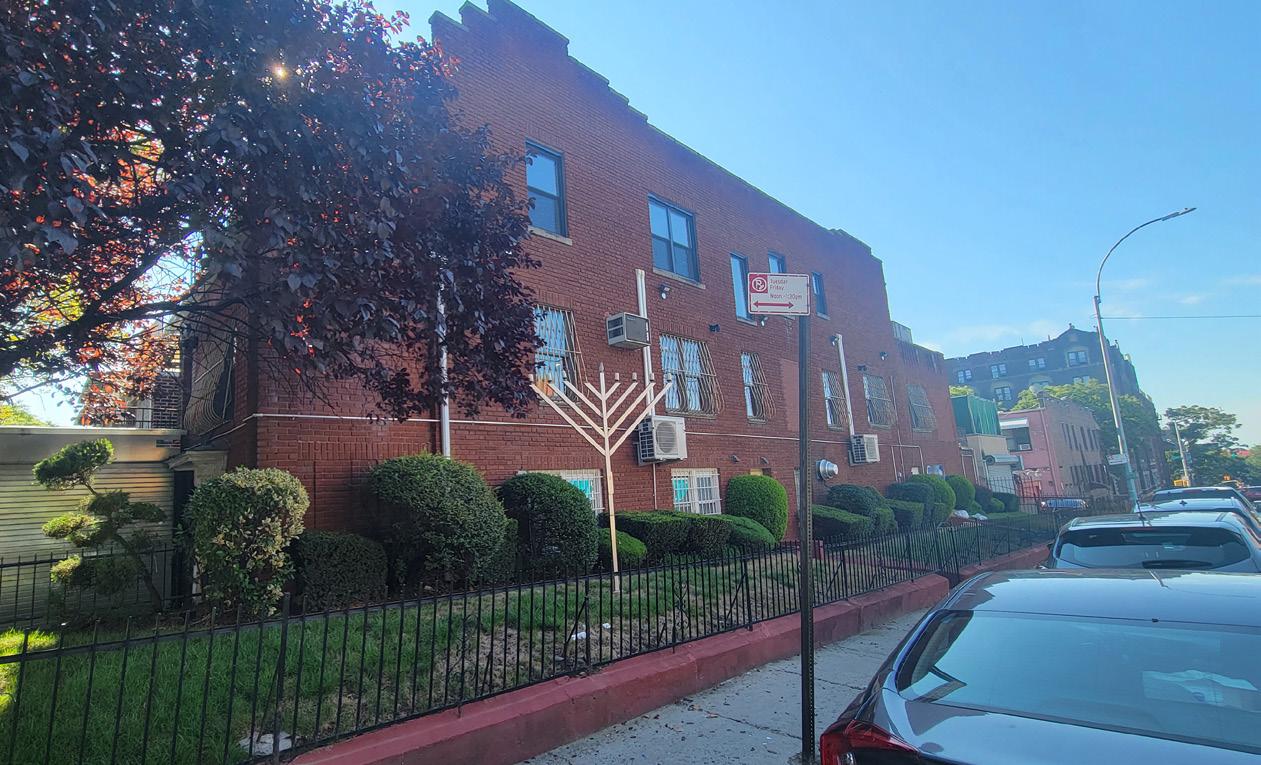
During its brief hey day, the Brownsville neighborhood was unofficially known as a mini-Yerushalayim because of the many frum Jewish families living there. The neighborhood overtook the Lower East Side as a Jewish center in the 1920s when the relatively more successful secondgeneration immigrants moved out of the stifling tenements to cleaner, more spacious living. The shift away from the city was also encouraged by the building of the Manhattan and Williamsburg bridges in the early 1900s, greatly easing the commute to the city from outlying neighborhoods.
Close to 50 shuls catered to almost every Jewish immigrant group tracing back to Europe. “The neighborhood was littered with shteibels that
were always open and always had hot water for tea or coffee at the ready for the men studying at all hours of the day or night,” E.L. Tenenbaum writes in her biography about Rabbi JJ Hecht.
Standing out among all these shuls was Rayim Ahuvim, a shul where R’ Hersch Meilech Hecht (Rabbi JJ Hecht’s grandfather) served as gabbai. The Hechts were known for their chesed and their hachnosas orchim, particularly for those coming to New York
to collect tzedaka. Hersch Meilech and his sons originally davened at Rayim Ahuvim in Nusach Sefard and when his son Shea was chazan, “it was with such gusto it was said his Nishmas Kol Chai could be heard three blocks away,” Tenenbaum writes.
At one point, the leading members of the shul banded together to build a much needed community mikvah in
60 COLlive Magazine
Congregation Tiferes Menachem - Rayim Ahuvim 1614 Carroll Street Brooklyn, NY 11213 718-778-7076 www.tiferesmenachem.org
Brownsville. They bought a private two-story brick house with a small front yard at 1849 Prospect Place and built one of Brooklyn’s only mikvahs in the basement.

Famously, the Frierdiker Rebbe used this mikvah during his visit to America between 1929 and 1930. As recorded in Tennebaum’s biography, the chassidim asked the Rebbe to recite a maamor for them. The Rebbe agreed
but insisted on going first to the mikvah - the one cared for by Hersch Meilech in Brownsville, the only mikvah in the area. When he was notified that Frierdiker Rebbe would be coming, Hersh Meilech emptied it out, bought new rugs, and scrubbed the floors clean himself. Then he slipped a generous donation into the towel intended for the Frierdiker Rebbe. Not only did the Frierdiker Rebbe refuse to
TIFERES MENACHEM
DAVENING SCHEDULE:
Sunday shacharis: 7:30 and 7:45
Monday through Friday shacharis: 6:30, 7:00, 7:45
Sunday through Friday minchah: Bizmano and mariv bizmano and maariv 9:30 nightly
DAILY SHIURIM CHASSIDUS:
6:15-6:45
Chassidus shiur with Rabbi Moshe Klein
7:00-7:30
Chassidus shiur with Rabbi Motti Lipsker
Between minchah and maariv
Daily Rambam shiur, one perek between minchah and maariv by Rabbi Levi Yitzchok Rappaport
SHIURIM AFTER FIRST MARIV:
Sunday:
Rabbi Fishel Oster in חישמו הלואג ינינע
Monday:
Rabbi Mendel Heller in בקעי ןיע
Tuesday:
Rabbi Sholom Gansburg in the Rebbe’s םירמאמ


Wednesday:
Rabbi Yitzchok Holtzman in ןקזה ר”ומדא ךורע ןחלוש תבש תוכלה
Thursday:
Moshe Katzman in the Chassidishe Parsha רוא הרות and הרות יטוקיל
SHABBOS SHIURIM:
Friday night:
Bbetween minchah and maariv Rabbi Avrohom Sebag תוחיש יטוקיל
Shabbos morning: Rabbi Moshe Klein Chassidus 8:30-9:30
Between minchah and maariv Rabbi Moshe Klein תוחיש יטוקיל
COMMUNITY Tishrei, 5784 61
Please credit Hecht Family Archive for the pics
take the money, but the Rebbe also insisted on paying five dollars for using the mikvah. Hersch Meilech refused to take the money and asked the Frierdiker Rebbe for a brochah instead.
“I give you a brochah that your grandchildren will be my chassidim,” the Frierdiker Rebbe replied, and the brochah came true in all six of [the senior] Shea Hecht’s sons. This was at a time when Chabad had little foothold in America, and barely a handful of Lubavitcher chassidim lived in America at all.
Sadly, the golden days of Brownsville were short-lived and by the 1960s the once thriving community drastically changed as many of the original residents moved out and the population became comprised of a lower-class majority with rampant crime.
With the negative changes in the area, the shul moved to Crown Heights, where it continues to thrive today. “It was a shul that relocated from
a bad area to a good one, which is what happens when neighborhoods change,” said Levi Hecht, a grandson of Hersch Meilich who davens regularly at the shul. “It took on a new Rabbi, Shamosh, and set of treasurers, and the shul and the mikvah became a joint venture, although it had originally been separate when the shul was in Brownsville.”
In the 70’s, most of the nonChabad people in Crown Heights had moved out, so Lubavitchers from the neighborhood took it over. With the shifts in constituency came new changes to the Shul. The Nussach was changed to Nussach Ari, and recently it adopted the name Tifferes Menachem to honor the Rebbe.
Over the years, many wellknown Lubavitch personalities davened there including Rabbi Yosef Wineberg who sometimes davened there on Shabbos and the Yomim Noraim and also used the mikvah. Rabbi Leibel Groner
also davened there in his last few years and would frequently farbreng on Shabbos.
Located on the corner of Carroll St and Schenectady Ave, the newly renovated building features an expanded men’s shul on the first floor with a separate women’s shul upstairs, a men’s mikvah in the basement, and an impressive Beis Medrash on the top floor that is open 24/7. Serving the eastern side of Crown Heights, it has become a daily hub of activity, Torah learning, and minyanim.
With shiurim almost every night and farbrengans and programs on all the chassidisher yomim tovim, the shul has developed a warm, chassidisher atmosphere. “In the last five years, the shul has become extremely active,” said Katzman. “People come for mikvah in the morning and many stay to learn and daven. About 40-50 people attend farbrengens and about 70-80 people show up for davening during the week and on Shabbos. We have a kiddush every Shabbos and we try to make it engaging by bringing people to farbreng,” said Katzman.
A shul with a storied history, Rayim Ahuvim continues to grow and is a source of inspiration and community in Crown Heights.

COMMUNITY 62 COLlive Magazine

Forward working
A panel discussion on strategies, innovations, challenges, and emunah
By Zev Gotkin
With so much uncertainty about the economy and the future, it’s reassuring to hear perspectives from some of our most esteemed local business leaders on a range of topics relevant to our thriving Crown Heights business community. That’s why we convened a panel to answer hot-button questions on the minds of many of our working professionals, entrepreneurs, and business owners.
Our panelists:
Levi Aronow, Founder of Railroad Pizza, with 2 branches in Crown Heights
Rabbi Shloimy Greenwald, CEO and Founder of RaiseThon, MYS Buying Group and Greystone Investments
Yitzy Geisinsky, Founder and President of Alacrity Energy –Optimized Energy Solutions
Shneur Landa, CEO of Fello, an audio visual equipment rental service
Mendy Lipsker, CEO of CCI Citycard, Mendy Realty, and Dynamic Energy

64 COLlive Magazine
Question: What drives and motivates you the most in your career?
Lipsker: I like to keep busy and help people.
Geisinsky: Problem solving, adding value, and finding solutions for our clients.
Landa: It’s a combination of things. I take pride in our hardware [tech rentals] being used at many big events by our high-profile clients, including Square, Eventbrite, and Shopify. The high-stakes nature of what we do always keeps things exciting and interesting. Every single day presents its own set of challenges and opportunities.
Question: How has your business been affected by the current economy and what’s the best way to be prepared for an economic downturn?
Aronow: We haven’t been affected by the economy itself but by a potential outcome of the economy, and that is theft and vandalism. When
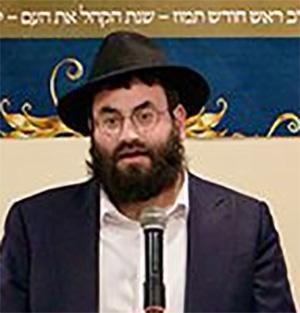

times are hard for people, specifically when authority doesn’t take crime seriously, business owners start hurting more.
own hardware has decreased and so they’re more inclined to rent from companies like ours. Renting the equipment you need just for the time you
Greenwald: Everyone is being affected and anyone who tells you they’re not is not being honest. The best way to be prepared is to be careful about what deals you take, think everything through, and run all of your numbers before you go into anything.
Landa: We’ve noticed slightly more sensitivity about pricing recently. Naturally, with inflation, the cost of our services has risen. One of the positive ramifications of the downturn is that as interest rates soar, the appetite of companies to purchase their
need it rather than purchasing or leasing keeps costs down so business is booming for us right now and we’re experiencing more frequent orders from our customers than ever.
Geisinsky: Thankfully, our industry has seen a boom lately with all the recent climate legislation, including the new IRA (Inflation Reduction Act) signed by the Biden administration toward the end of last year. There is a lot going on in renewable energy right now, so that’s been good for us. As far as preparing for a potential economic downturn, I think it’s important to have effective middle and upper management who are creative problem solvers and good thinkers who know how to pivot when necessary and have their eyes and ears on the ground. Having the right personnel and good people is more important than having experience.
BUSINESS
Tishrei, 5784 65
Having the right personnel and good people is more important than having experience.
- Yitzy G
You’ve got to cast a wide net and put yourself out there. I try everything because you never know where the business is going to come from.
- Shloimy G
Question: They say finding and keeping good people is harder now than ever. How do you create a great environment for your employees that inspires them to work hard and stick with your company?
Aronow: It really comes down to empathy. I believe that when people see that you care, and that they matter, there is a stronger sense of belonging and that is what leadership is all about. And, it doesn’t necessarily have to be that they will all stay or that you will retain everyone. Sometimes, letting people go is for their benefit, which follows the same rule of empathy and understanding.
Greenwald: I think you need to be loyal, you need to be generous, and you need to show your employees that you care about them on a personal level.
Landa: This is one area in which we’ve been very fortunate. We’ve been in business for thirteen years and our average employee has stayed with us for 6-8 years. I believe we owe our strong retention to a strong management that truly advocates for the people. Our COO and HR department pays careful attention to the management side of the business and they are always thinking of ways we can keep employees happy and the workplace interesting and fun. For example, our company sponsors a lunch for all the
employees every Wednesday. We also offer excellent benefits, including healthcare, 401K, and paternity and maternity leave. We’re also flexible about employees working from home when they need to. There’s an understanding that as long as you get the work done, we’re here to support you. Another reason we have such a great culture is that we are very
myself with “yes-people.”
Hearing everyone’s ideas and contributions makes for a much better vibe. The best ideas and solutions to problems can come from anywhere so it’s important to take their opinions seriously. By including them in the process, we help them stay motivated and ensure they stick around. People feel valued when you make them

selective about who we hire. This has kept our team from growing as quickly as it could have, but we have a very high standard and we don’t compromise it.
Geisinsky: Beyond providing fair compensation, we value our employees’ voices and try to include them in the decision-making. We empower them to be part of the solution, not just take orders and push buttons. I don’t like to surround
part of the solution.
Question: What would you say is the number one challenge facing your business or your industry right now and how do you plan to handle it?
Lipsker: It’s hard to get potential clients on the phone. You need personal interaction.
Landa: One challenge we’re dealing with is our services
BUSINESS 66 COLlive Magazine
“[One] reason we have such a great culture is that we are very selective about who we hire. This has kept our team from growing as quickly as it could have, but we have a very high standard and we don’t compromise it.”
- Shneur Landa
are being requested in other countries, such as Canada, but we’re not quite ready to scale internationally. When delivering abroad, we’ve had challenges mitigating customs delays and shipping delays. This is something we’re trying to figure out, but it looks like we’ll likely be opening an operation in Canada at the beginning of next year, so that we can more easily transport inventory and fulfill orders.
Geisinsky: Renewable energy is a complex business for the consumer to understand so there is always an education barrier that requires us to teach our prospects about their options and help them figure out what solutions are right for them. Another issue is financing. Our solutions save businesses a lot of money over the long haul, but a lot of up-front capital investment is required to get started so we’re working with banks and lenders to make more financial products available to more people. If we can finance everything properly, our clients are cashflow positive within the first month.
Quetion: What are some things you are currently doing to market your business and which marketing tactics have you found most effective?
Aronow: We are currently pursuing two marketing strategies. 1) We’re focusing

on expansion. In today’s market it’s about getting closer to your customers. If we move to be closer to our customers, they’ll be more likely to frequent our establishments more often.
2) We also do some sales
will be at an event that’s using our equipment, see all that all the hardware that was used at the event came from Fello, and then they call us. It also helps that they’re seeing our hardware at events hosted by big name companies who
promotions. For example, during the 9 Days, we ran a campaign offering free French fries with every purchase of a pizza pie. The value is just unbeatable!
Lipsker: I use all platforms to market my business, including Facebook Groups, WhatsApp Groups, Instagram, TikTok, LinkedIn, Twitter, and Coldcalling.
Greenwald: You’ve got to cast a wide net and put yourself out there. I try everything, because you never know where the business is going to come from.
Landa: Our business is unique because we don’t do any outbound sales. The only marketing we really do is SEO and paid advertising on Google, but we’ve grown mostly through referrals and word-of-mouth. Often, people
are our strategic partners and clients. This gives us greater credibility. Now that we’ve matured as a company, our reputation and positioning in the market is what attracts business for us so we don’t have to market as much.
Geisinsky: Mostly word-ofmouth, networking, LinkedIn, and referrals. We also earn a lot of referrals from our clients and even our vendors, because they know we can manage projects and find solutions to challenging problems.
Question: What is a new software, tool, or app that you’re really excited about and how has it helped your business?
Landa: Right now, we’re all just learning about what
BUSINESS Tishrei, 5784 67
It’s hard to get potential clients on the phone. You need personal interaction.
- Mendy L.
AI is and everyone is either marveling or fearing it, wondering how it will help or hurt them. No doubt, AI will help our business in a variety of ways. There is so much we’re doing right now that has the potential to be done by AI automation. For example, our business requires a lot of data analysis to do things like monitor inventory and forecast when items will need to be shipped so we can do it at minimal cost. Right now, much of this data analysis is done by people, but automation opportunities from AI will help us do all of this at a lower cost and less effort.
Geisinsky: Thanks to Satellite technology and platforms like Google Earth as well as much more advanced Satellite solutions we’re using, we can now bid on jobs remotely without doing site visits. Ultimately the [power] grid is going ‘smart.’ The power grid is going to utilize AI to limit brownouts and black outs. This will create opportunities for you to get paid by your local grid for use of your battery during peak energy periods, which creates a market-place where people can buy and sell energy.
Lipsker: Cardknox is an online gateway that can process credit cards and track your activity. We sell it in CCI Citycard International.
Greenwald: I don’t find that AI is disrupting us; I believe it’s only helping us. I use AI
whenever I can to benefit my business.
Shneur Landa: Our IMS (inventory management system) is fully integrated with our website. Our site can accurately show our customers what is available and alert us when we need to pause an item or order more supply. Customers can go to our website or log into their user portal to see what is in stock in real-time
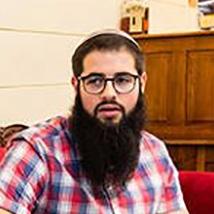
or something like that. Using our custom-built software, we make the process of ordering as simple as possible. Our tech also integrates with other platforms like Hubspot allowing us to manage inquiries and sales tickets more easily.
Question: Where do you see future growth opportunities either in your industry or the wider market?
and view up-to-date pricing. This minimizes the amount of time customers have to spend speaking with our representatives. We are able to provide a fluid environment and seamless experience to our customers, including co-branded pages for our accounts, each with their own specific guidelines tailored to the needs of each account. As a result, our customers hardly ever have to speak to a rep unless it’s a logistical question
Aronow: The more precise answer to this question isn’t what people should do, but rather how. If you go into something strictly for the money, you get blindsided by all the hype and fake opportunities and you end up making the wrong moves. If you chase your craft, the money will follow. Money is a result, not a creation.
Lipsker: We recently got involved in the energy
BUSINESS 68 COLlive Magazine
It really comes down to empathy. I believe that when people see that you care and that they matter, there is a stronger sense of belonging and that is what leadership is all about.
- Levi A
business — electricity, natural gas, and solar. This is a great sector to invest in, because it helps businesses and property owners save on their energy costs.
Landa: We’re seeing a very big opportunity with a subscription model in which customers can buy a monthly subscription, similar to that of Spotify or Amazon Prime, and pay as they go without a specific end date. A subscription model not only generates a more steady revenue stream for us, but it also provides a better experience for our regular customers. Our subscribers also get additional services such as onsite support, complex phone support, hardware swaps, and exchanges. We’re growing by adding more and more partners to the roster of subscribers. At this point, we are poised and wellpositioned for this growth, because we have so many large, name-brand companies partnered with us.
Geisinsky: The growth right now is in solar, batteries, EV chargers (electric car charging stations), and everything that goes into financing, building, or selling renewable energy sources. There are opportunities at both the residential and commercial level as well as in utility-scale solar farms, wind, or battery back-ups. Anything to do with renewable energy will be big for at least the next ten years.
Question: How do you remain strong in your bitachon and your Yiddishkeit in business?
Aronow: To say that one is always strong in his belief can be true, but I don’t believe I am personally. We have our challenges in this regard. I believe everyone has their own way of connecting to Hashem. Getting to a place where you have emunah every day is certainly a journey, but learning Shaar Yichud ViEmunah is absolutely the answer to helping guide us to understanding.
Lipsker: I’m part of a WhatsApp group with over 4,000 participants hosted by Michael Safdie that has a 10-minute bitachon class based on Chovos Halevavos.
Greenwald: By learning and giving shiurim every day. I try to take out a sefer and learn during every free moment.
Landa: Tzedaka. When times are tough it can feel scary to invest in your business and take the risks necessary for growth. One way my partner and I overcome that fear is by giving tzedaka. We know nothing can go wrong when we’re partnered with Hashem. Every quarter, we allocate an aggressively large portion to charity. This has no doubt brought us tremendous bracha in the form of new business. And, doing this gives us strength because it
reminds us that Hashem is with us. And when you have Hashem on your team, what else do you need?
Geisinsky: Experience. I’ve seen it both ways – you have a full-proof plan and it blows up on you at the last minute and other times when you’re facing a big problem, it all comes together and turns out fine. My advice is to have a big vision, and just dive in. Accept that you don’t have it all figured out and rely on Hashem to give you the answers at the right time. I’d also like to add that while business is important, it is only one part of my life so I try to keep everything in its proper perspective. Often, when I meet other people in the industry, I’m the only frum Jew they work with so I know I have a responsibility to represent more than just myself. *
We hope the above thoughts and insights from these successful business leaders provided you with ideas and inspiration to help you navigate your own business challenges and seize the opportunities that lie ahead.
BUSINESS Tishrei, 5784 69


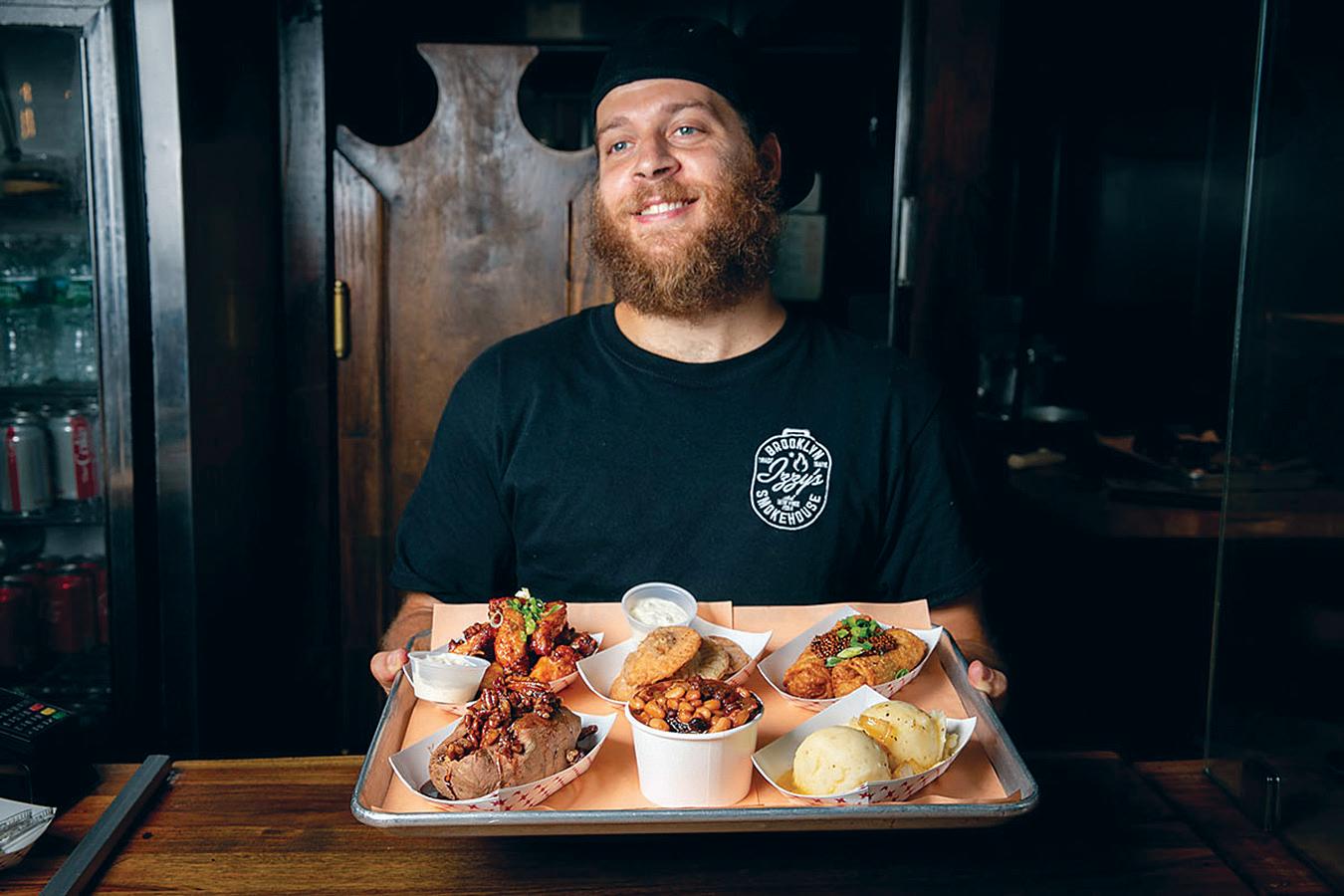


INTEREST-FRE E SMAL L BUSINES S LOAN S FOR NE W YORK CITY Startups • Expanding Businesses • Storefronts • Home-Based • Men/ Women Owned Get a loan up to $50,000 No Interest. No Fees. Ever. Restrictions apply. TWO GUARANTORS MAY BE REQUIRED. The Hebrew Free Loan Society provides interest-free business loans to low-and moderate-income residents of New York City. Find out what HFLS can do for you: 212.692.9023 • biz@hfls.org WWW.HFLS.ORG SOMETIMES ALL A BUSINESS OWNER NEEDS TO SUCCEED IS A HELPING HAND LET US LEND YOU A HAND. An initiative of the Hebrew Free Loan Society in partnership with Crown Heights Young Entrepreneurs




You won’t find them in ordinary kitchens. Or at ordinary stores. Sub-Zero, the preservation specialist. Wolf, the cooking specialist. Cove, the dishwashing specialist. Find them exclusively at your local kitchen specialist. Drimmers Appliances 1608 Coney Island Ave, Brooklyn NY 718-338-3500 Monday—Thursday: 9am – 6pm Fridays: 9am – 1pm Saturdays: CLOSED Sundays: 10am – 6pm Drimmers MCKB 41 W. 25th Street, New York, NY 212-995-0500 Monday—Thursday: 10:30am – 6:30pm Fridays: 10am – 1pm Saturdays: CLOSED Sundays: 11am – 5pm
A conversation with Dr. Janet K. Kennedy on modern sleep challenges and solutions

 By Menachem Levy
By Menachem Levy
On Rosh Hashana, the day Hashem assesses and determines the fate of individuals and humanity for the coming year, we’re told that one should refrain from sleeping during these holy days. The reason, given in Gemara Yerushalmi, is that one’s luck should not “rest” as well while judgment is being passed.
That custom is only during the daytime. The problem, according to Dr. Janet K. Kennedy, is that many people are nowadays not sleeping at night either, and it is a year-round phenomenon.
Kennedy is a licensed clinical psychologist specializing in the treatment of insomnia and other behavioral sleep disturbances. She regularly lectures on sleep-related topics and is the author of the book “The Good Sleeper: The Essential Guide to Sleep for Your Baby--and You.”
5 Tips for getting a great night’s sleep
By Dr. Janet K. Kennedy
Get up at the same time every day to get your body clock right.
Avoid screens for up to an hour before bed.
Do calm, relaxing activities before bed.
Make sure your bedroom is dark, cool, and quiet.
Don’t try to sleep if you aren’t feeling sleepy. That will only put your body under stress.
72 COLlive Magazine
She spoke with COLlive Magazine about modern sleep deprivation, the need for consistent sleep patterns and the impact of caffeine and screen time.
COLlive: You have been in this field for many years and have undoubtedly seen hundreds of patients. Are Americans getting enough sleep?
Dr. Kennedy: The short answer is no. Sleep deprivation is pervasive in this country, with some studies showing that about a third of Americans do not get enough sleep.
That is a huge percentage. What is considered a good night’s sleep?
Dr. Kennedy: One good night’s sleep is not what matters; it’s consistency that is key. If we go to sleep at similar times each night and wake up at about the same time every morning, our inner body clock falls into a rhythm, and we get the most out of our sleep. Falling asleep within 20-30 minutes of getting into bed, being able to fall back asleep easily after waking up in the middle of the night, and feeling refreshed after waking up in the morning are all signs that one is sleeping properly.
I would imagine that we need varying amounts of sleep at different stages throughout our lives. How much sleep should a person be getting in their teens and on to their adult years?
Dr. Kennedy: Teens really need about 9-10 hours of sleep a night for their developmental health. What complicates that is two factors: 1) School starts early in the morning. 2) It takes them longer to feel tired at night, resulting in them staying up later. The American Sleep Association recommends that adults get 7-9 hours a night but that can vary and many people do just fine with slightly less than that. Less than six hours of sleep consistently can cause long-term health problems.
What type of problems?
Dr. Kennedy: Increased chances of contracting diabetes and metabolic issues. Sleep deficiency also affects us indirectly because it causes us to make poorer decisions and eat more junk food, thereby detracting from our health.
Let’s talk about taking naps during the day. After a bad night’s sleep, one might be tempted to take a nap during the day to shake off the exhaustion. Is that a good idea?
Dr. Kennedy: It really depends on what type of nap. A 40-minute nap in the middle of the day can help boost energy levels and cognitive strength. It allows enough time to fall asleep but stops just short of reaching deep sleep, which can be difficult to wake up from. Ironically, people who are
Sleep quiz
1. We say Modeh Ani because sleep is --- of death?
2. Whose sleep is the first mentioned in the Torah?
3. Who had the longest sleep recorded in the Gemara and how long did it last?
4. According to Gemara, how long can a person go without sleep?

5. Whose sleep is mentioned on Yom Kippur?
6. Why is sleep good for resha’im and bad for tzadikim?
7. Why did Hashem create sleep, according to the Rebbe?
8. What did the Frierdiker Rebbe say about the Rebbe’s habit at 4z:00 AM?
9. Why don’t Chabad Chassidim sleep in the Sukkah on Sukkos, according to the Mitteler Rebbe?
10. According to one opinion, when won’t humans need sleep?
ANSWERS:
1. Sleep is one-sixtieth of death, 2. Adam, 3. Choni Ha’maagal, 70 years, 4. Three days, 5. Yona Hanavi, 6. Because resha’im don’t sin while sleeping, while tzadikim don’t learn Torah while sleeping, 7. To give us a chance to ‘start over’ each day, 8. That at 4:00 AM, the Rebbe still didn’t go to sleep or had already woken up, 9. The Sukkah is too holy, 10. When Moshiach comes.
HEALTH
Tishrei, 5784 73
sleep deficient have a harder time with naps because they fall into deep sleep faster than usual, which makes it harder to wake up.
Interesting. For some people, coffee at 3 PM can keep them up at night while others can drink a coffee and go straight to bed. How does caffeine play into the sleep discussion?
Dr. Kennedy: Caffeine does two things: 1) It makes it harder for us to fall asleep. 2) It prevents us from getting restful sleep even if we do fall asleep. I don’t recommend people drink coffee after 2 PM, and if they have a hard time falling asleep, I suggest backing it up even earlier in
the day. People might think that the coffee after dinner isn’t affecting them but that is incorrect; it is affecting them in ways they may not be aware of.

We hear a lot about the negative effects of screen time on our sleep. Why is that so and what is a healthy approach to screen time before bed?

Dr. Kennedy: Screens emit blue light into the retina that shuts down the natural production of melatonin that our body produces to get us into a mode of sleep. Since the screens are close to our faces, we are exposed to a lot of it. Also, our brain needs
time to wind down and ease up so it can tell the body that it’s ok to relax and go to sleep. Screens, particularly phones, keep us connected to all the stress and worry of the day and don’t allow it to settle down. I recommend staying off screens for up to an hour before bedtime and filling that time with calm, relaxing activities such as reading a book.
This has been so insightful and no doubt our readers will benefit a lot from your advice. Thank you for your time.
My pleasure! Happy New Year to you and all your readers.
HEALTH
Referrals for ALL ages

P: 718.758.0400

W: MaskParents.org
E: info@maskparents.org
Mental Health, Addiction School Issues
BottomLineMG.com BE OUR PARTNER! DONATE ONLINE AT WWW.MASKPARENTS.ORG F A MILYMATTERS RADIO SH O W 620AMTHURSDAYSAT9PM
the courage, call MASK’s confidential anonymous helpline today!
how she can help me for shabbos.
I
It’s
She let my sisters and I bake whatever we like.You should try it sometime Ok whatever you say ZOOM GROUPS AVAILABLE
MASK provides referrals to licensed therapists, in-outpatient programs. Have
I was so surprised when my Esther came over asked
& Hey!Want to hang out this afternoon?
hear there’s a real chill down by Leah’s house SorryPromised my mom I’d help her prepare for Shabbos Serious? Since when do you like that stuff?
actually fun
ASK THE THERAPIST
WITH RABBI DANIEL SCHONBUCH, LMFT

HOW TO CHOOSE THE RIGHT THERAPIST
Choosing a therapist can be a daunting task, especially if you are not sure what to look for or what to expect. This is especially true when you maintain specific religious values and have expectations of the outcome of therapy.
The truth is that several years ago, I would’ve said that most therapists are probably good if they have proper training and a fairly good reputation. However, I believe that the world has changed. The type
of therapist can and often does impact the quality of therapy and the kind of advice you will receive.
One particular example of this is that therapists come from different backgrounds and have received different levels of training. I, for example, am a marriage and family therapist. One can surmise, by the very nature of my title, that I work with families and marriages. This is not exactly true for all therapists. Some therapists
deal more specifically with individuals and not necessarily relationships. That doesn’t mean that other therapists don’t deal with relationships. It means that their training is understanding the client’s individuality versus their relational needs. The very nature of family therapists is to try to keep families together. This might not necessarily be the goal of others who focus more on individuality.
76 COLlive Magazine
THE ADVICE YOU RECEIVE SHOULD ALIGN WITH YOUR NEEDS AND BELIEFS
THE TYPE OF THERAPIST CAN
Another challenge of modern-day therapy is the bias that the therapist maintains. There is no question that we all have a bias, even if we try to limit our personal bias filters. Good therapists will try earnestly to limit their bias, but we are all human and will probably point our clients in the direction that we are likely to go in ourselves. For example, several areas of bias may affect the client, including attitudes toward marriage, taking medication, or other important identity issues. Therefore, I suggest that you choose a therapist who maintains similar values and orientation.
Another difference may be the type of training someone has or the type of therapy they practice. If your therapist was only trained in Freudian-based psychoanalysis, he or she has a predetermined understanding of what your problems may be (they are often about your father and mother).
However, if they were trained by someone in the school of Logotherapy, following Dr. Viktor Frankl, the questions they ask are not necessarily about your past, but about your future. Logotherapists focus more on your values and what’s meaningful to you and less on your history. The point is that different therapists concentrate on different parts of who you are and must be clear about what you want to achieve.
Here are some types for those seeking therapy for
themself or their loved ones:
1. KNOW YOUR GOALS AND PREFERENCES.
Before you start looking for a therapist, it is helpful to have a clear idea of what you want to achieve from therapy and what kind of therapist you are comfortable with. For example, do you have a specific problem that you want to address, or do you want to explore your feelings and thoughts more generally? Do you prefer a more directive therapist who gives you homework assignments or one who is more supportive and empathic? Do you want to work with someone who shares your cultural background, identity, orientation, or religious beliefs?
2. DO SOME RESEARCH.
Once you have a general sense of what you are looking for, you can search for potential therapists online or offline. You can use a website like PsychologyToday.com or contact Relief (reliefhelp. org), an organization that maintains a comprehensive list of frum or orthodoxfriendly therapists in your area. You can also request referrals from your primary care doctor, friends, family, or other trusted sources.
MENTAL HEALTH Tishrei, 5784 77
AND OFTEN DOES IMPACT THE QUALITY OF THERAPY AND THE KIND OF ADVICE YOU WILL RECEIVE
3. CONTACT AND INTERVIEW.
After narrowing down your list of potential therapists, you can contact them by phone or email and ask them questions to see if they are a good fit for you. Some questions you can ask are:
• What are your credentials and experience?
• What are your areas of expertise and specialization?
• What are your fees and payment options?
• What is your availability and cancellation policy?

• How do you approach therapy, and what methods do you use?
• How do you measure progress and outcomes?
• How do you handle confidentiality and privacy?
4. TRUST YOUR GUT.
Finally, after you have contacted and interviewed several therapists, you can choose the one that feels right for you. Trust your intuition and pay attention to your feelings when talking to them. Do they seem interested, respectful, and understanding? Do they listen well and answer your questions clearly? Do they make you feel comfortable and safe? Remember that
therapy is a collaborative process that requires trust and rapport between you and your therapist. If you don’t feel a connection with them, it is unlikely that therapy will be effective.
Choosing a therapist is an important decision that can affect your mental health and well-being. By following these tips, you can find a therapist that meets your needs and helps you achieve your goals.
-- Rabbi Daniel Schonbuch, LMFT, is a renowned psychotherapist who treats individuals and families to overcome depression, anxiety, PTSD, and trauma. He is the director of MyTalkPlace.com, which offers insurance-based tele-therapy for the frum community.
MENTAL HEALTH
WISHING OUR CUSTOMERS A HAPPY AND HEALTHY NEW YEAR

Flourless Apple
Flourless Apple Pecan Pie
PAREVE | SERVES: 6-8
This genuinely healthy dessert is a new and fresh way to elevate your appreciation of apple and pie.
8 medium-to-large Fuji apples, peeled and sliced thin
1 tsp cinnamon
PECAN “DOUGH”
4 cups pitted dates
2 cups toasted pecans (see note, p. 138)
OPTIONAL GARNISH
Whipped cream
Ice cream
Preheat the oven to 350°F. In an oven-safe pan, combine the apples and cinnamon. Cover; cook for 75-90 minutes. Let cool; drain off excess liquid.
PECAN “DOUGH”
Set out a 9- or 10-inch pie plate.
In a food processor fitted with the S-blade, pulse together dates and pecans until the mixture forms a “dough” ball.
Divide the pecan-date dough into two equal parts. Place each part between 2 pieces of parchment paper; using a rolling pin, roll it into a round wider than your pie dish.
Place rolled-out dough into the pie plate. Use your fingers to make sure the bottom and sides of the pie dish are covered with the dough.
Add the cooked apples. Cut the second sheet of dough into strips. Place the strips over your pie in one direction, leaving a half-inch between strips. Repeat process, placing strips in the opposite direction to create the illusion of a lattice (see photo). Trim edges.
Refrigerate. Serve with ice cream or whipped cream, if desired.
Tips: For added depth of flavor, substitute 1 cup of toasted pecans with 1 cup of sweet and spicy pecans (Trader Joe’s brand).
Roll up excess dough into bite size balls. They make a great snack.
RECIPES 80 COLlive Magazine 204
ApplePecan Pie

RECIPES Tishrei, 5784 81
Apple andHoney
Ingredients:
5 small Gala or Macintosh apples, peeled and sliced into thin half-moons
½ cup unsweetened applesauce
¼-½ cup honey, to taste
1 tsp pure vanilla extract
1/3 cup avocado oil or melted coconut oil
4 eggs, lightly beaten
1 cup Rorie’s Grain-Free Flour or spelt flour
1 tsp baking powder
½ tsp cinnamon
Directions:
1. Preheat oven to 350°F. Line 1 (9-inch) springform pan with parchment paper; coat the sides with oil spray.
2. In a large bowl, combine apples with wet ingredients.
3. In a second bowl, combine dry ingredients. Fold into apple mixture.
4. Pour batter into prepared pan; place on a baking sheet (to catch any overflow). Bake for 45–50 minutes, or until the top is golden.
5. Allow to cool. Run a knife around the sides to loosen. To serve, open the springform pan and remove the cake before cutting into wedges.
6. Store in refrigerator for up to 4 days.
RECIPES 82 COLlive Magazine
PAREVE | SPELT OPTION | Yields 8-10 servings
Cake

RECIPES Tishrei, 5784 83
Harvest Bundt Cake
Serves 12
I love the simplicity and beauty of an elegant, iced Bundt cake—especially the way the icing falls down the sides. Decorating the cake with the best of the harvest season, using apples, figs, and pomegranates, makes this a stunning holiday centerpiece. And with apples and honey, it’s perfect for Rosh Hashanah.
Ingredients:
3 extra-large eggs
1 cup (packed) dark brown sugar
1 cup canola oil
1 cup honey
3 cups all-purpose flour, plus more for flouring the pan
1½ teaspoons baking powder
1½ teaspoons baking soda
1 teaspoon plus 1⁄8 teaspoon ground cinnamon, divided
½ teaspoon ground ginger
¼ teaspoon ground nutmeg
½ teaspoon kosher salt
1 cup plus 2 tablespoons apple cider, divided
2 Granny Smith apples, peeled, cored, and grated
1½ cups confectioners sugar
For decorating:
Cinnamon sticks; star anise; fresh figs, halved; gooseberries; pomegranate seeds; baby apples; honeycomb
Directions:
1. Preheat the oven to 350°F. Grease a nonstick Bundt pan with cooking spray and lightly flour it.
2. In a large bowl using an electric mixer, beat the eggs and brown sugar until creamy. Add the oil and honey and beat until fully combined.
3. In a separate medium bowl, whisk together the flour, baking powder, baking soda, 1 teaspoon of the cinnamon, the ginger, nutmeg, and salt.
4. Add the dry ingredients into the bowl with the wet ingredients and mix well. Add 1 cup of the apple cider and the grated apples and stir until combined.
5. Pour the batter into the Bundt pan and bake for 50 minutes, until a toothpick inserted comes out clean. Cool for 10 minutes, then run a knife around the edges to loosen the cake from the pan. Unmold onto a cake stand and cool completely.
6. To prepare the icing, in a small bowl, whisk together the confectioners sugar, the remaining 2 tablespoons apple cider, and the remaining 1⁄8 teaspoon cinnamon until smooth. Pour the icing over the cake so that it drips down the sides.
7. While the icing is still tacky, decorate the cake with the toppings of your choice. Serve immediately.
8. This cake gets better as it sits but is best eaten within a few days. Remove the toppings from leftover cake so it doesn’t get soggy.
Note:
Apple cider is an unfiltered apple juice and can be found in the refrigerated section of most major supermarkets. Freezer-Friendly: Wrap leftover slices in plastic wrap and freeze in a zip-top bag for up to 2 months.
RECIPES 84 COLlive Magazine
Totally Kosher” Copyright © 2023 by Chanie Apfelbaum. Photographs copyright © 2023 by Chanie Apfelbaum. Published by Clarkson Potter, an imprint of Random House
Chanie Apfelbaum
Totally Kosher Author

Born and raised in a kosher home in Brooklyn, Chanie Apfelbaum grew up eating traditional Jewish foods such as gefilte fish, stuffed cabbage, and matzah ball soup. Today, living just a few blocks from her childhood home, she revisits family favorites and reinvents traditional holiday dishes. Her creative twists on old-time cuisine prove that kosher fare is anything but old-fashioned. With five kids in tow, she celebrates her heritage one dish at a time, creating fun recipes with a modern flair and Middle Eastern vibe. Chanie works as a recipe developer and food photographer. She also shares her love of food, family, and tradition through interactive cooking demonstrations and workshops to audiences worldwide. You can follow her culinary adventures at www. busyinbrooklyn.com or on social media via @busyinbrooklyn.
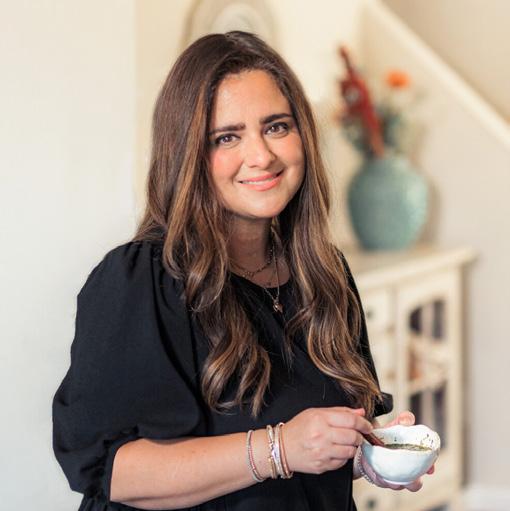

RECIPES Tishrei, 5784 85
Photo Credit: Lauren Volo.jpg
A glimpse into Crown Heights’ culinary delights
Visiting Artisan Bakehouse, Pina Pita, and Patis
 By Libby Herz
By Libby Herz
Crown Heights is alive with Kosher culinary exploration and innovation, and the flavors of Artisan Bakehouse, Pina Pita, and Patis weave a tapestry of deliciousness within a diverse culinary landscape. Let’s explore the offerings of these savory gems.



86 COLlive Magazine
Artisan Bakehouse: Tradition Meets Innovation

Artisan Bakehouse is known for its refreshing drinks, scrumptious pastries, and hearty breakfasts. It was opened by Levi Krinsky in 2015 and originally focused on sourdough and bread creations. “Back then, you couldn’t find sourdough sandwiches or avocado toast,” he said. “I wanted to show other restaurants what they could do with bread.”
The journey can be traced back to Italy, where Krinsky would spend his summers with his grandparents, Rabbi Gershon Mendel Garelik OBM and his wife Bassie Garelik, the Rebbe’s first Shluchim in Milan. “I was very much enthralled with the bread that we would have there, and I started experimenting with sourdough and bread baking,” he said.
His Italian heritage and fascination with the bread culture of Italy led his bread-baking hobby to blossom into a full-scale venture. He began offering gravlax sandwiches with dill and the now-famous TLT tuna sandwich. Then, Artisan Bakehouse expanded and began

Brooklyn Artisan Bakehouse

665 Empire Blvd, Brooklyn, NY 11213
718-872-5155

www.brooklynab.com
@brooklynartisanbakehouse
Sun-Thurs: 7:30 AM - 9:00 PM Fri: 9:00 AM - 3:00 PM
Most popular: Power breakfast.

Signature drink: Strawberry hibiscus iced tea.
New Items: Pizza
Busiest day: Sunday and Thursday
Busiest time: 11:00 AM - 2:00 PM
offering an extensive breakfast menu, which was a rarity in Crown Heights at the time. Soon, they added croissants, mouth-watering cinnamon buns, and creative salads with the perfect texture, crunch, and sweetness ratio. Coupled with its signature rustic charm and vibrant decor, Artisan Bakehouse carved itself into a distinctive identity.
Recently, Bakehouse relocated to a larger venue on Empire Boulevard and Albany Avenue. The expanded space and event area marks a new chapter for the restaurant. The spacious area is available to host a variety of gatherings such as sheva brochos, brisin, and upshernish. Their recently expanded menu offers dinner options such as sourdough pizzas and innovative fresh fish dishes like fresh tuna tataki paired with sun gold cherry tomatoes. “Come by and try our new menu,” Krinsky said. “Everything is super light, delicious, and very, very fresh.”
EATERIES Tishrei, 5784 87
Pina Pita: An authentic taste of Israel
Nestled just one block from 770, Pina Pita is one of Crown Heights’ best-kept secrets. Under the ownership of Peretz Gurwitz, each dish brims with authentic Israeli flavors.
“This was an existing place that had topquality fast food,” Gurwitz says. The new ownership gave the space a makeover and an efficiency upgrade while still keeping the original Israeli recipes.



Pina Pita offers rich shawarma with hefty helpings of hummus and charif. The falafel is soft and scrumptious on the inside and crunchy on the outside. “ Our falafel is on par with the best falafel balls you’ve ever had,” says Gurwitz.
The offerings, reminiscent of the streets of Israel, have recently expanded into new options such as breakfast shakshuka. Plus, Pina Pita’s speedy delivery guarantees that you will receive your order within twenty minutes. It caters parties, events, and offers lunch menus for office meetings. Soon, it will unveil its dessert and acaii bowl options.
The affordable yet luxurious taste of Israel makes Pina Pita especially attractive to young Israeli bochurim who yearn for the comfort of familiar flavors, and it is open all night during the month of Tishrei.

Through quick delivery and a menu brimming with authenticity, Pina Pita has become a beloved destination that continues to tantalize taste buds and create lasting memories.
Pina Pita
250 Kingston Ave, Brooklyn, NY 11213 718-484-7814
www.pitapina.com

Sun-Thurs: 11:45 AM - 10:45 PM
Most popular: Falafel and shwarma
Busiest day: Thursday, Sunday, and Monday
Busiest time: Lunchtime and after 6:00 PM
EATERIES 88 COLlive Magazine
Patis: Culinary Craftsmanship
The void left by the closure of the once-popular Basil Pizza & Wine Bar in Crown Heights is quickly being filled in a neighboring storefront on the same street corner.
Now occupying 266 Kingston Avenue, a block off Eastern Parkway, once the location of Calabria Romanstyle pizza, is a new branch of Patis. The growing bakery and cafe chain specializes in French-American artisan pastries, bread and sandwiches. It has 15 locations across New York and New Jersey.
Patis began as a humble coffee shop in Lyndhurst, NJ but has grown to restaurant-style setups in inviting spaces established all over Brooklyn, Manhattan, and the Five Towns. A previous branch in Crown Heights was located on Troy Avenue.

“It’s a place where food is an art form,” says owner Benny Azizov. His goal for Patis is to bring unique culinary innovation and design to the kosher consumer. Here, every detail, including the interior design, is meticulously curated to provide a meal and an exquisite journey for the senses.
The new branch on Kingston lives up to that plan. Its ceilings overflow with white flowers and greenery to create a rejuvenating atmosphere, with plush chairs to sit on. Delectable samples of strawberry croissants, tiramisu swirl, and pistachio madeleine cookies are ready to be picked up on the counter.
Besides its freshly baked pastries, Patis offers an array of croissant or sourdough-based sandwiches, specialty drinks, perfectly balanced salads, and hot paninis. The fusion of flavors, the attention to detail, and the commitment to beauty make Patis an experience that goes beyond the ordinary.
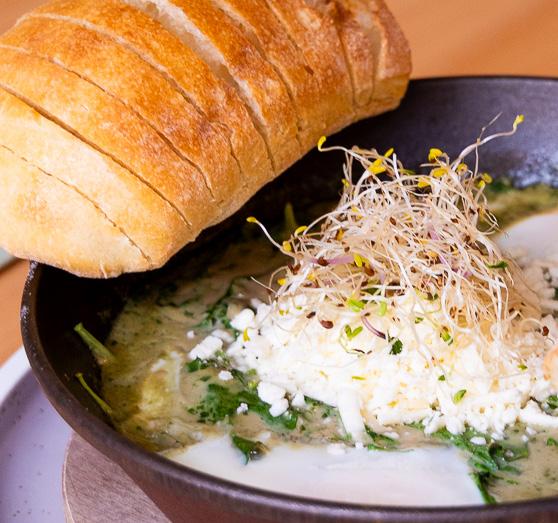
“When I started,” says the manager, “We only sold pastries. Now, we offer twelve different types of sandwiches and five styles of pizzas.” Patis offers hot paninis and presses, pastas, cheesecakes, signature beverages, and a lot more.
The inviting atmosphere of Patis makes it the perfect place to gather friends and family. Whether you’re treating yourself to a special indulgence or sharing a meal with loved ones, this delightful cafe promises an unforgettable experience. In the competitive world of dining, Patis stands out not only in the kosher market.

Patis

266 Kingston Ave, Brooklyn, NY 11213 929-234-6365 www.patis.com
Sun - Thurs: 7:00 AM - 10:00 PM, Friday: 7:00 AM -5:00 PM
Most popular: Wild Mushroom Panini and the Tuna Melt Press
Pastry: Tiramisu Swirl (pastry) and Pecan Pie Sticky Bun

Busiest day: Wednesday (after 12 noon until 6:00 PM)
Busiest time: 11:00 AM to 5:00 PM
EATERIES
Tishrei, 5784 89
Crown Heights Kosher Food Guide
ABE’S CORNER
Gastropub offering unique, delicious food in a spacious and immersive setting.
Kosher Certification: Rabbi
Eliyahu Matusof
674 Rogers Ave, Brooklyn, NY 11226
Phone: (718) 684-7828
ALBANY BAKERY
339 Albany Ave, Brooklyn, NY 11213
Phone: (718) 778-1733
ALMAH CAFE
Kosher Coffeehouse and bakeshop
Kosher Certification: CHK
87 Utica Ave, Brooklyn, NY 11213
Phone: (347) 533-6494
BAKERIE
Modern bakery for kosher breads, sweets & daytime noshes with housemade spreads & coffee.
Kosher Certification: OK
252 Albany Ave, Brooklyn, NY 11213
Phone: (718) 693-8248
PITA PINA
Israeli style falafel, shwarma and sandwiches.
Kosher Certification: CHK
250 Kingston Ave, Brooklyn, NY 11230
Phone: (718) 484-7814
BOEUF & BUN
Innovative, handcrafted burgers pair with a variety of craft beers at this upbeat locale.
Kosher Certification: CHK
271 Kingston Ave, Brooklyn, NY 11213
Phone: (718) 221-8900
BUNCH O BAGELS
Cafe offering bagels plus a roster of entrees, omelets, salads, sandwiches & pasta dishes.

361 Troy Ave, Brooklyn, NY 11213
Phone: (718) 604-0634
CROWN PIZZA
Dark wood & exposed brick adorn the interior of this upmarket pizzeria with specialty slices.
Kosher Certification: OK
419 Kingston Ave, Brooklyn, NY 11230
Phone: (718) 484-4817
BROOKLYN ARTISAN
BAKEHOUSE
Rustic decor, down to earth ambiance and flavorful menu.
Kosher Certification: OK 665 Empire Blvd, Brooklyn, NY 11213
Phone: (718) 872-5155
CHOCOLATTE
Bright & Modern cafe in Crown Heights, free WiFi Open 24 hours.
Kosher Certification: CHK
792 Eastern Pkwy, Brooklyn, NY 11213
ESS AND BENTCH
Offering hot dogs, shnitzel, sandwiches and french fries
Kosher Certification: CHK
313 Kingston Ave, Brooklyn, NY 11213
Phone: (718) 705-7770
GOMBO’S HEIMISHE
BAKERY
Counter-serve bakery specializing in jelly doughnuts, plus other sweets, sandwiches & coffee.
328 Kingston Ave, Brooklyn, NY 11213
Phone: (718) 771-7701
GRUIT
A neighborhood restaurant & garden with a modern American kitchen and strong focus on seasonality & cocktails.
Kosher Certification: OK
252 Empire Blvd, Brooklyn, NY 11225
Phone: (347) 846-0622
HOLESOME BAGELS
Bustling shop offering housebaked bagels, breakfast, sandwiches, pizza & salads.
Kosher Certification: CHK
333 Kingston Ave, Brooklyn, NY 11213
Phone: (347) 955-5300
IZZY’S BBQ SMOKEHOUSE
Kosher BYOB barbecue restaurant serving platters, sandwiches, sides & desserts in hip digs.
Kosher Certification: OK
397 Troy Ave, Brooklyn, NY 11213
GUIDE 90 COLlive Magazine
Phone: (347) 425-0524
KINGSTON BAKE SHOP
Kosher Certification: CHK
380 Kingston Ave, Brooklyn, NY 11225
Phone: (718) 467-2047
KOSHERTOWN CAFE
Kosher Certification: CHK
469 Albany Ave, Brooklyn, NY 11213
MAMA KITCHEN NY
Restaurant featuring a funky modern interior & menu of contemporary & classic Israeli cuisine.
7 Rochester Ave, Brooklyn, NY 11233
Phone: (718) 771-3038
MEAT
MEAT is where food and design meet. Extremely elegant restaurant featuring modern Mediterranean cuisine.
Kosher Certification: OU
123 Kingston Ave, Brooklyn, NY 11213 Phone: (516) 888-1730
MENDY’S
Mendy’s Deli is the place to go for burger, a delicious steak,or a heAvenly sandwich.
Kosher Certification: CHK
792 Eastern Pkwy, Brooklyn, NY 11213
Phone: (718) 907-8877
MERMELSTEIN’S
Deli & Home-style Jewish Food
Kosher Certification:CHK
351 Kingston Ave, Brooklyn, NY 11213
Phone: (718) 778-3100
MOZZARELLA
Fine Dining Dairy establishment
conveniently located in Crown Heights.
Kosher Certification: CHK
265 Troy Ave, Brooklyn, NY 11213
Phone: (917) 633-6770
NORIBAR
High quality Sushi meals using fresh ingredients and skilled preparation techniques.
Kosher Certification: CHK
326 Kingston Ave, Brooklyn, NY 11213
Phone: (347) 913-8888
PRIME AVENUE
Prime Avenue offers a delicious global menu that includes schnitzel sandwiches & Chinese dishes.
Kosher Certification: CHK
377 Kingston Ave, Brooklyn, NY 11213
Phone: (718) 576-6665
SAUCE N CHEESE
Stop-in kosher pizzeria offering slices, calzones & salads in a simple counterserve setting.
Kosher Certification: CHK
509 Albany Ave, Brooklyn, NY 11203
Phone: (347) 425-1450
SUSHI SPOT
Snug storefront offering both basic & specialty kosher sushi rolls for delivery & curb-side pickup.
Kosher Certification: CHK
426 Kingston Ave, Brooklyn, NY 11225
Phone: (718) 756-4040
SWEET EXPRESSIONS
Ice cream shop, candies, chocolates and sweets Hot and cold shakes and smoothies.
310 Kingston Ave, Brooklyn, NY 11213
Phone: (718) 613-0188
TAKEOUT
DOVID MALKA
1552 Carroll Street
718-773-2335
KOSHERTOWN
469 Albany Ave phone 718-778-6171
THE MARKETPLACE
589 E New York Ave
Phone (718) 363-1300
GUIDE Tishrei, 5784 91
The Silent Meeting
By Sandy Eller
On this past Chof Menachem Av, the eighth Children’s Sefer Torah was completed in Yerushalayim after Chabad Chassidim worldwide put in great efforts to sell the remaining letters. It was carried to the Tzemach
Tzedek Shul in the Old City in a joyous procession attended by thousands of Jews. The following story is about an amazing miracle story connected to the first Children’s Sefer Torah. At the time, the Rebbe urged

Chassidim to sign-up as many children as possible to get a letter before Shavuos. Why? Read on, and you’ll find out.
The year was 5740 (1980). The Arab country of Iraq was becoming a real problem for the Middle East, where Eretz
92 COLlive Magazine
Yisrael is located, alongside many Arab countries. Iraq had started building a nuclear reactor, a special power plant that can make electricitybut can also be used to build dangerous bombs.
Israel was not very happy about this. While Iraq’s leaders kept promising that the reactor would only be used for peaceful scientific research, Israel had every reason to believe that Iraq’s dictator, Saddam Hussein yimach shemo, was going to use his shiny, new factory to make weapons - and Israel was very sure that those weapons would be pointed directly at their cities, putting their people in a lot of danger.
Iran, another Middle Eastern country, was also worried about what was happening in Iraq. Iran and Iraq shared a border and always fought about who owned what land. As the months went by, the situation in the Middle East didn’t get any better - in fact, it just kept getting worse.
Still, life went on. People went around doing things they always did. Jews in Eretz Yisroel celebrated Tu B’Shvat, Purim, Pesach, and Shavuos, even though everyone was worried about what Iraq was going to do.
A few weeks after Shavuos, the great tzaddik, the Lelover Rebbe, Rav Moshe Mordechai Biderman, took an Erev Shabbos trip up to northern Israel to cut the
wheat that would be used for the following year’s Pesach matzos. It was something he did the week of Parshas Behaaloscha every year, but because the trip took him so far away, he always spent that Shabbos in Meron, right next to the tziyun of the great Tanna, Rebbi Shimon Bar Yochai, known as the Rashbi.
Many of the Lelover Rebbe’s chassidim would often join him in Meron, and they’d spend a very special Shabbos together - but that year turned out to be an experience that none of them would ever forget.
One of the people spending that Shabbos in Meron was Rabbi Eliyahu Alfasi, a shamash of Rav Yisroel Abuchatzeira, known as the Baba Sali. Upon returning home to Netivot in the south of Israel, he shared with the Baba Sali where he had been for Shabbos and who he spent it with.
The Baba Sali, who was frail and over 90 years old at the time, insisted that he wanted to travel to Meron to see the Lelover Rebbe. Rabbi Alfasi tried his best to talk the tzaddik out of the 150-mile trip, which would surely be difficult. But the Baba Sali had made up his mind. He was going, and there was nothing Rabbi Alfasi could say to keep him in Netivot.
The journey from Netivot to Meron indeed took many hours as they had to make many stops along the way due to
Baba Sali’s poor health. When they finally made it to Meron, the Lelover Rebbe, who had himself been sick with a high fever, was overjoyed by the Baba Sali’s surprise visit. It was a double shocker for some because the last time the two tzaddikim met, the Baba Sali said: “Next time I see you, it will be in a sudden manner, like when Moshiach comes, without warning.”
The Lelover Rebbe then insisted that the Baba Sali sits in his special chair, an honor that the Baba Sali initially turned down. Eventually, out of respect to the Lelover Rebbe, he agreed.
What happened next was something that no one could have ever imagined. The two tzaddikim sat there without saying a single word to each other. The room was so quiet, you could feel it - like a heavy blanket made from silence. Everyone who was there to watch the two tzaddikim were filled with wonder, realizing they were seeing living malachim, in our world. While the strange and special meeting felt much longer, the Baba Sali got up after half an hour and said goodbye to his friend, the Lelover Rebbe. The Baba Sali went back to Netivot, while the Lelover Rebbe returned home and was miraculously cured of his illness.
The next day, the Lelover Rebbe spoke to his gabbai. “While we were in that room, the Baba Sali and I had a long
STORY
Tishrei, 5784 93
talk. We both agreed that all the evil things Israel’s enemies had been planning to do to Israel, they would actually do to each other instead.”
The Lelover Rebbe’s gabbai was shocked to hear this because, having been in the room with the two tzaddikim, he knew that neither of them had spoken even a single word. How had they had a “long talk” if no sound ever came out of either of their mouths?
Just weeks later, the Lelover Rebbe’s words came true. Iraq attacked Iran in September, starting what became known as the Iran-Iraq War. There were many dangerous battles, and the two countries fought all throughout the fall and winter. It was hard to tell who was winning - many people were hurt and killed on both sides. But Israel and its people were not harmed.
# More spiritual power
Time went on, and everyone saw Hashem’s miracles protecting Eretz Yisrael from
harm. Just before Pesach, the Lubavitcher Rebbe had a beautiful idea. He wanted to unite Jewish children worldwide by having them come together to write a Sefer Torah.
The Rebbe was very specific: this Torah would only be written for boys and girls who had not yet become bar or bas mitzvah. Every child would pay a dollar of their own money. They could give the money a little bit at a time if they didn’t have a dollar. The Rebbe spoke passionately about how this Sefer Torah would protect the Jews of Israel and bring peace to the entire world, because it would be written for children - who he called “Tzivos Hashem” - “the soldiers in Hashem’s army.”
In the days and weeks that followed, Chassidim and Yeshiva bochurim all over the world got to work signing up children for the unifying Torah. Then, on Erev Shavuos, in June of 5741 (1981), the Rebbe spoke about the children’s Torah again, but he spoke much stronger and more seriously. He said there was terrible darkness in the world, and this Childre’s Torah had
the power to stop something horrible from happening.
While it was erev yom tov and everyone was busy preparing for Shavuos, the Rebbe insisted that Chassidim all over the world stop what they were doing and focus on one thing – signing up letters in the Torah. It was odd. Nobody was sure what the Rebbe was so worried about or why he was certain that this Torah could fix it. Even more strange, the Rebbe also told his Chassidim to reach out to his office in Brooklyn on that same day and report exactly how many letters they had sold. It was clear that this was very, very important to the Rebbe, but nobody knew why. Everyone was left wondering the exact same thing - why was this such a big deal?

Sometimes, we never get to understand why tzaddikim might ask for certain things truly, but in this case, it didn’t take long for people to realize why the Lubavitcher Rebbe felt such a strong need to put a little extra good out into the world that day.
# Israel’s secret plan
At the very same time, Israel secretly planned to take out and destroy everything Iraq had been building. It was called Operation Opera, and Israeli jets were to fly super low over enemy land so they won’t be detected. “Many people will be trying to shoot your planes out of the sky,”
STORY
94 COLlive Magazine
the pilots were warned. “It’s a very, very dangerous and a very secret operation.”
“Iran has never been friendly with Israel, but they’re so angry at Iraq, they sent spies to learn everything they could about their nuclear reactor,” Israeli officials said.
“Iran secretly shared that information with us, giving the Israeli army the knowledge we needed for this mission. Your job, soldiers, is to take out the reactor. It was a miracle that Iran was willing to tell Israel what they know, but we’ll need another big miracle for this mission to go well.”
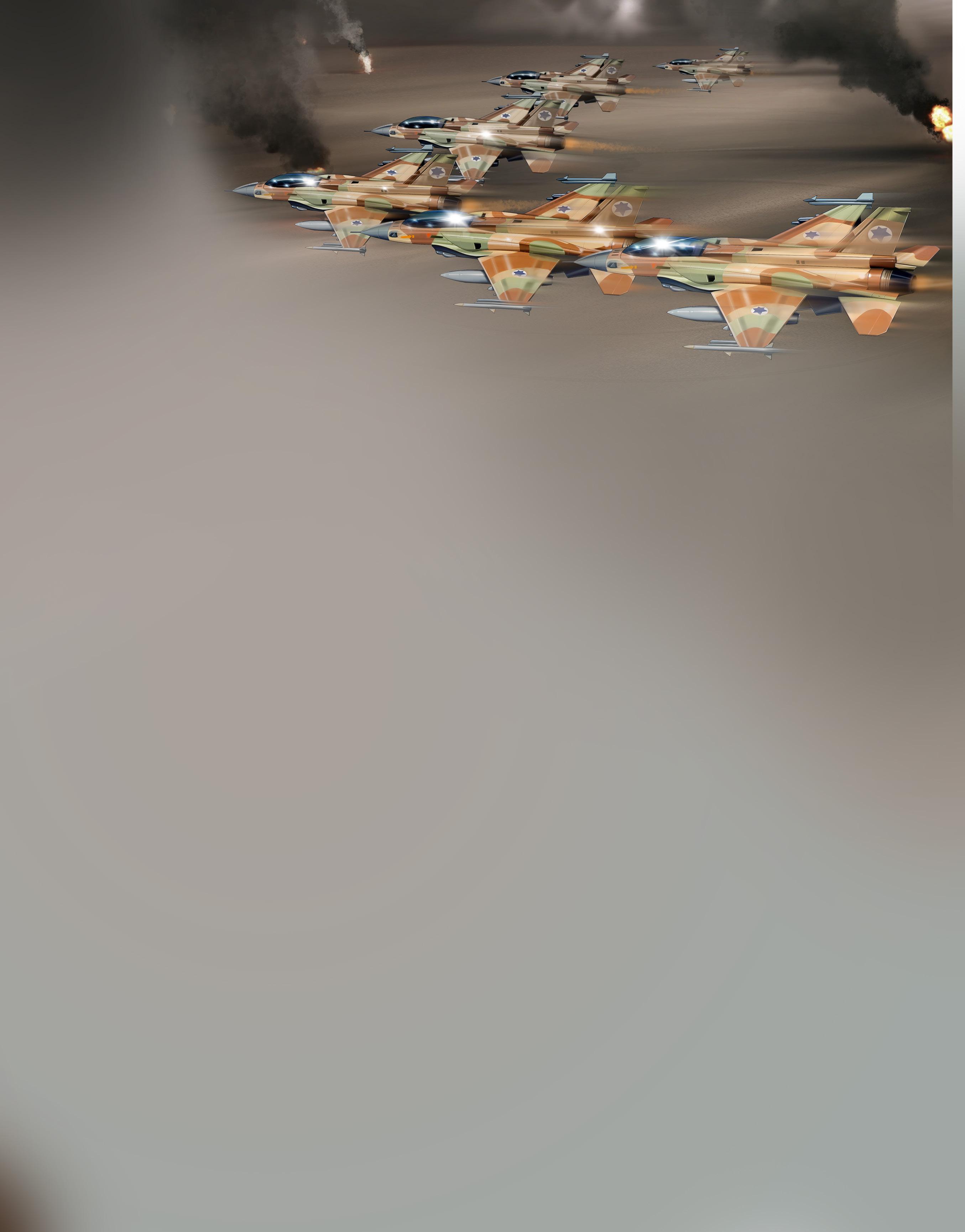
Hoping to hide their planes, Israel sent their fighter jets the long way, and they flew right over Jordan. King Hussein of Jordan was vacationing on his big yacht in the ocean and noticed the Hebrew letters on the bottom of the planes. Guessing that they were on their way to Iraq, he immediately contacted Iraqi officials. For some reason, Iraq’s officials never picked up the phone. The Israeli fighter jets managed to fly a full 600 miles across very dangerous Arab land without being spotted.
The Israeli jets succeeded
in destroying Iraq’s Osirak nuclear reactor, located 11 miles southeast of Baghdad. It was an amazing victory. With Hashem on their side, all of the Israeli pilots made it safely back home. And while world leaders and the international media, including the United States, criticized Israel, most people believe that Israel’s actions helped everyoneeven other Arab countries.
Thanks to Israel, Iraq could no longer make weapons that could kill hundreds or even thousands of people, and it would never have been possible without Hashem’s blessings protecting those planes and allowing so many things to go right. The Rebbe brought those blessings down when he encouraged all the Jewish children in the world to work together.
The Iran-Iraq war continued for seven more years after the bombing, and half a million people died across the two countries. This war changed everything in the Middle East. Arab countries that had been planning to join one another were suddenly very angry
at each other, and instead of coming together against Israel, those Arab countries began fighting with one another instead. It was exactly as the tzaddikim had said.
While they might not wear uniforms or carry guns, our tzaddikim are the generals who lead the Jewish world in ways that affect everyone around the globe. The Baba Sali and the Lelover Rebbe knew how the war would turn out, while the Lubavitcher Rebbe’s Sefer Torah campaign led to a miraculous turn of events. With his guidance, Jewish children worldwide kept the entire planet safe from the danger of that nuclear reactor for years to come.
From TzaddikStory.org for the upcoming book Amazing Miracle Stories #3. Source: Moshe Ish HaElokim (Stories of the Lelover Rebbe).
STORY
Tishrei, 5784 95

96 COLlive Magazine Spot the difference Can you find 10 changes between the first photo and the second?
Rosh Hashana Word Search
Find 16 words associated with the beginning of Tishrei
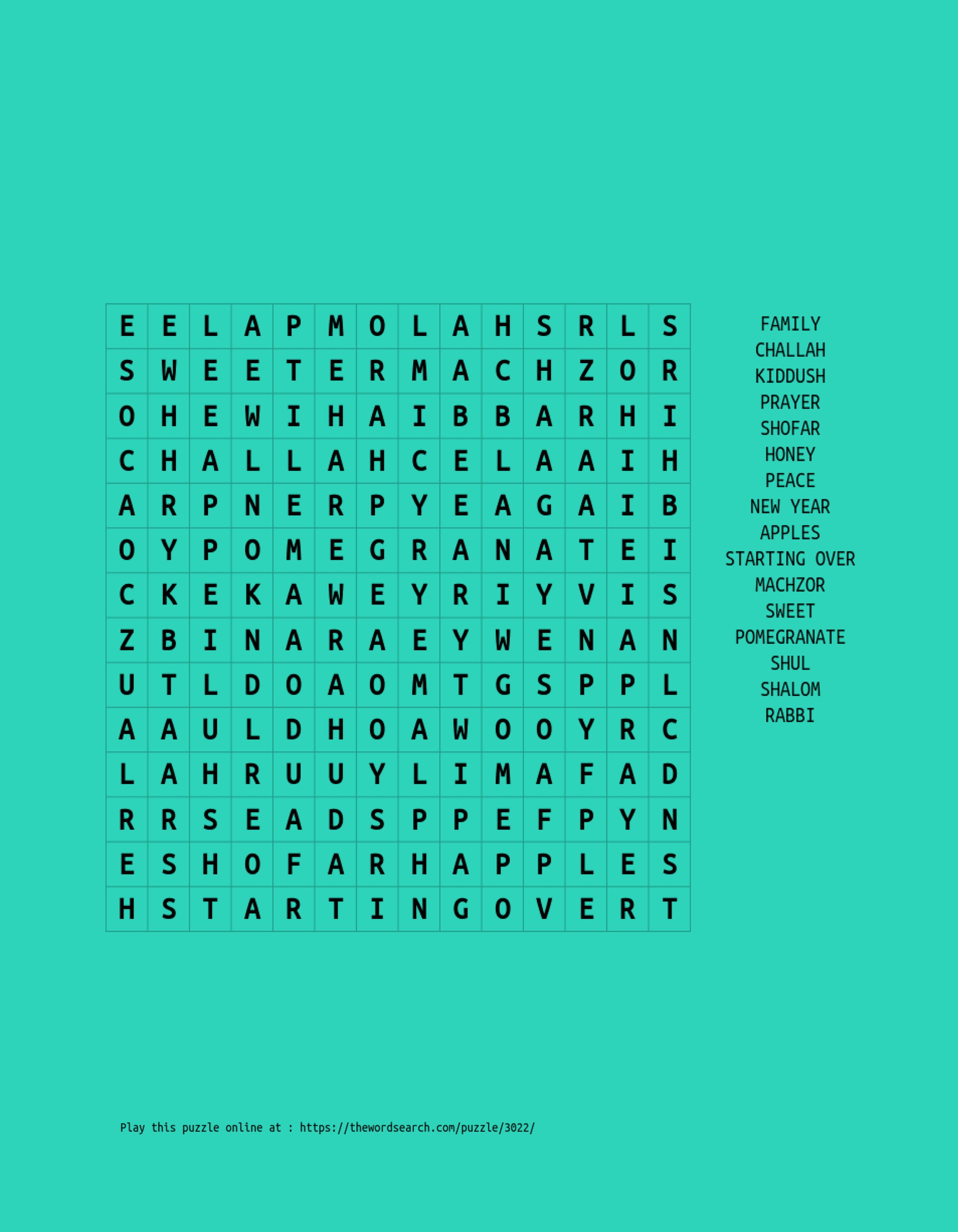
KIDS Kislev, 5783 97
Sticky Maze
What’s an apple without honey? Help lead the way to the sweet jar

KIDS 98 COLlive Magazine
Follow these steps to create a masterpiece for Simchas Torah

KIDS Tishrei, 5784 99
Just davening along
A humorous look at davening amid annoyances and distractions
By Mordechai Schmutter
I don’t think that we go to shul just to daven.
It’s just a theory. I’m not a rabbi, so take everything I say with a grain of salt, unless you’re reading this during the Yomim Nora’im, when you can take it with a grain of honey.
But I recently read an interesting article by a rabbi who mentions a bunch of things that annoy him in shul. But what I found most interesting about the article is that he mentioned me. Actually, he challenged me to write a humor column about it – to take all those things that make us mad at each other in shul – all those things that people do that ruin our kavana – and write jokes about them so that people can read it and go, “Whew! It’s not just me.”

So I’ve been spending a lot of
time in shul this month, thinking about it.
Also davening. But look at the typical morning. You come into shul, and after fighting past the guy who’s using the bookshelf as a shtender, you turn around and realize that someone’s in your makom kavua. So you sit somewhere else. No big deal. I don’t personally believe that my improvement in kavana in a makom kavua is better than the guy who actually came on time to shul. Yes, there is a concept of makom kavua, which we learn from Avraham Avinu, but Avraham Avinu was the only Jew at the time, so he never really had to kick anyone out of his seat. Also, it doesn’t really seem like he was the type. But then, after a while, someone else shows up and
finds you in his seat. So he decides to handle it using the internationally-recognized method of putting his stuff down in front of you and coughing a lot. What are you supposed to say to him? You’re in the middle of davening; he’s not. So you move. Hopefully to the one seat in shul that doesn’t have a regular occupant. Or of someone who you know is sick, probably from getting coughed on. But if this seat has no regular occupant, you can definitely see why. There’s not quite enough room for a human being. Your arms stick out onto the laps of the two people next to you, and theirs do the same to you. And it doesn’t help that one of those guys shukkels side to side. Also, to get into your chair, you have to step over the
100 COLlive Magazine
back.
Alternatively, you can wordlessly hold your ground and specifically not get the message, no matter how many things the guy piles in your place. But not if the guy has a tabletop shtender. How come he gets to save your seat no matter what time he comes just because he stores a shtender on the table?
Somebody did that to me last week. He came late, and the main reason I got out of his seat was that he had a massive shtender. I didn’t even want his shtender. It was in my way, and I couldn’t sit down because I couldn’t figure out how to open it.
So what am I supposed to do? Hand him the shtender? Let him walk around the crowded shul with a 25-lb. shtender trying to find a place to sit between the two guys shukkeling sideways and slamming shoulders? So I moved. But the only place to sit at that point – because he couldn’t drag himself out of bed to kick me out earlier – was a chair that was parked in front of the bookcase. So I came full circle.
Not that there are that many great seats. You can sit next to the guy who davens too loudly. And it’s not the whole davening – he just yells out random parts. And not always in line with what everyone else is saying. And these are guys who always refuse to daven for the amud. Yet they have to keep announcing what they’re up to. Or that they remembered Yaaleh V’yavo.
And their random call-outs keep confusing everyone, not to mention the chazzan.
And speaking of davening too slow, don’t forget the guy behind you who davens a long Shemoneh Esrei so you can’t back up until he’s done. Or the guy in front of you who davens way too fast and who keeps turning around to look at you and sigh.
And then there’s the noise. There’s the guy whose chair squeaks, but he won’t stop shukkeling. Then there are the guys with the phones. There is only one excuse for a phone in shul and that is to text your rav to ask when it’s okay to back up in front of a guy who’s still davening.
And speaking of noise, don’t forget about the kids. They won’t let you.
Now don’t get me wrong. Bringing kids to shul is great chinuch and also adorable if they know how to be quiet and shukkel in front of a page of alef beis. But some kids just walk into shul and cry.
Do you mind? I’m trying to cry to Hashem. How difficult is your life right now, rolling into shul two hours late with your homemade pekeleh and your picture books?
“I got the wrong color lolly.” It’s Yom Kippur. Be happy you got any lolly. I’m sitting here with besamim. And it’s not even the kind I like.
Not that we prefer the kids who show up, get candy, and leave. The candy is so you can sit quietly in shul. Not so you
can traipse in with each of your friends.
“I have a little sister at home. Can she have one?”
“No. Tell your mommy to buy lollies for her. They’re not that expensive.”

And then there are the temperature-control fights between the people who want the window open for air and the people who want it closed because they’re cold.
“Then why do you sit near the window?”
“So I can close it.”
“Well, put on a tallis!”
Or maybe it’s because there’s noise outside. But no one who’s fighting ever gets the idea to switch seats.
In the rabbi’s article, he made it sound like women don’t have any annoyances to put up with in shul. But I’m sure there are pet peeves in the ezras nashim too. I don’t really know them.
I know it starts with having to kick the men out when you first get there.
I’ve heard women complain about this. But this is not really different from kicking someone out of your makom kavua. And the men will get out. They won’t challenge it. But I guess it’s still annoying to have to do that. The men never have to do it when they first come to shul.
“Hey, why is the men’s section full of women?”
“What? It’s roomier!”
It also doesn’t help that when the women walk in, the men have an expression on their
HUMOR Tishrei, 5784 101
face that says, “Great. I had a good thing going here. I had my elbow room, no one’s coughing in my ear, and there are zero windows!” The men aren’t annoyed at you for showing up; they’re annoyed that they now have to go sit in the men’s section. Of course, the noises are annoying for women too, especially when they can’t hear the chazzan. And that guy yelling out random parts of davening? They have no idea he’s not the chazzan.

And don’t forget the men who shmooze in the back of the shul – or at least they think it’s the back of the shul. It’s right in front of the women. Though my advice for that one is that the women should just keep pekelach on hand from previous simchas that they can throw at the men. Unless you think that’s rewarding them for their behavior. But candy does keep most kids quiet.





“Can I have one more for my son? He’s playing outsi—BOOM!”

So women do have reasons to be annoyed, but they go once a week. Men go 14-21 times a week. But I guess that he’s saying that, in case women are jealous that we get to go off to shul and have you fight with the kids in the morning -- just so you know, we’re fighting too. All we want to do is daven, but all these annoying people are in the way. On the other hand, that seems to be the whole point. The point of going to shul is to daven with at least 9 other people and their various annoying personality traits. You have siddurim at home. Maybe the point of davening together is an achdus thing – learning to get along in service of the greater good. Because you know where people don’t kick you out of your makom kavua? At home. Unless you daven at the same time as your wife. Going to shul, I’ve read, is about working on our middos, and maybe instead of getting upset, looking back and laughing because it’s something we all go through. Even rabbonim, apparently. Maybe that’s what the rabbi wanted from me. Or maybe he wanted a funny, non-threatening way to get the message across to the people who do all these annoying things. Most of them aren’t even aware of what they’re doing. Do you think the guy who randomly bangs on his shtender for kavana realizes how many people he’s inadvertently causing to say Yaaleh V’yavo?

blooms@ chanigreenbaum.com 718-484-1952 @chanigreenbaumevents @cgblooms BSD BSD
Crown Heights - Williamsburg Borough Park - Flatbush - Monsey
Candle Lighting Times
For the New York Area
Shabbos Parshas Ha’azinu Friday, September 22
Shemini Atzeres Friday October 6

pm Shabbos October 7 after 7:09 pm Sunday October 8 ends: 7:07 pm

IMPORTANT NUMBERS & INFORMATION HATZOLAH (718) 230.1000 SHMIRA (718) 221.0303 SHOMRIM (718) 774.3333 CHAVERIM (718) 222.1800 BIKUR CHOLIM OF CROWN HEIGHTS (718) 467.1661 CROWN HEIGHTS URGENT CARE 555 Lefferts Ave. Brooklyn, NY 11225 BEIS DIN OF CROWN HEIGHTS 390 Kingston Ave. (Above Kettle & Cord) (718) 604.8000 RABBI OSDOBA ext 1 RABBI BRAUN ext 3 Tishrei, 5784 103
Friday September
6:47 p.m. Motzei Shabbos September 16 after 7:44 pm Sunday
7:42 pm
Rosh Hashana
15
September 17 ends
5:12
7:28
Tzum Gedalya Monday, September 18 fast begins
am Monday, September 18 fast ends
pm
6:35 pm Shabbos
7:32 pm
September 23 ends
6:32 pm
7:29 pm
Yom Kippur Sunday, September 24
Monday, September 25 ends:
6:23
Sukkos Friday September 29
pm Shabbos September 30 after 7:20 pm Sunday October 1 ends: 7:19 p.m.
6:12



thinkinkcreations .com Ah, the sweetness of yom tov the warmth of a facility that cares. infused with 2266 CROPSEY AVENUE, BROOKLYN, NY 11214 • (718) 266-6100 KINGDAVIDCENTERREHAB.COM SCHEDULE A TOUR TODAY > CHANA LESCHES | (929) 457-5407




MAKER OF THE FINEST NON IRON SHIRT VISIT US AT 260 KINGSTON AVE. PHONE ORDERS & CUSTOMER SERVICE CALL: (814) 962-6354 SHOP ONLINE AT ATICAMAN.COM
By Zev Gotkin
The large building on the southeast corner of President Street and Kingston Avenue in Crown Heights typically hums with Yeshiva bochurim. The imposing, white structure sits on a 6,500 square-foot lot with a large front yard surrounded by a sturdy stone wall capped by an elegant metal fence. It is a dormitory of the Central Yeshiva Tomchei Tmimim Lubavitch, located two blocks away at 770 Eastern Parkway.

What is less known about the building is that it is a combination of two former apartment buildings1414 and 1418. The latter is where Rebbetzin Chana Schneerson, of blessed memory, the heroic mother of the Rebbe and wife of Harav Levi Yitzchok Schneerson, lived for over a decade.
The original building was constructed with masonry in 1913 as a 4-story, 19,600 square foot building flanked by two husky doric columns just like its nearly identical neighbor, 1414 President. While its first floor and the top of the building sport an elegant cream-colored BeauxArts style replete with elegant exterior elements, its intermediate floors are a more simple, exposed white brick complemented by subtle ornamental finishes.
The Rebbetzin moved into the 1418 building around 5713 (1953), a few years after her arrival to the United States. She lived there until her passing on Shabbos, the 6th day of Tishrei 1964.
The 17 years she spent in New York were bittersweet. Her revered husband passed away in exile in Alma-Ata (now Almaty, Kazakstan). One son perished in the Holocaust, and another lived in London, England. Her son and daughterin-law, the Rebbe and Rebbetzin Chaya Mushka Schneerson, were her family in America.
Neighbors observed that Rebbetzin Chana would stand on the corner of Kingston and President every Shabbos proudly watching her son’s chassidim, young families and children, going by. Whenever someone wished her a “Good
Then &
Shabbos,” she always returned the greeting with a smile.
Mrs. Joni Nathanson, whose family lived in the 1418 building, said that because most of the Jewish kids who lived there attended Jewish schools and she did not, she always felt like an outsider in the neighborhood. The one person in her life who accepted her unconditionally, she said, was Rebbetzin Chana.
Speaking to JEM in 2011, Nathanson recalled how one neighbor would bully her when she returned from school. With Nathanson’s mother still at work, the Rebbetzin personally greeted her outside the building, safely walked her in, and escorted her up to her apartment.
The Rebbe frequented Rebbetzin Chana’s apartment at 1418 on a daily basis. Rebbetzin Chana eagerly looked forward to these visits and would prepare for them by putting on her nicest clothes and a beautiful sheitel. The Rebbe and his mother spent these visits talking and drinking tea together.
106 COLlive Magazine
1940
Now
The Rebbe would also visit every Friday night, and the two would often go on a walk together. Crown Heights, at the time, was home to many non-Lubavitcher Jews. Passersby, who saw the Rebbe on these outings with his mother, would walk up to them and ask for a bracha.
The late businessman and Holocaust survivor Leibel (Leo) Zisman recalled being stopped by the Rebbetzin during one such walk. The two met in the Jewish displaced persons (DP) camp in Pocking, Germany, when Zisman picked up a letter from the Rebbetzin to deliver. The Rebbetzin now asked about his wellbeing and studies, but Zisman kept the conversation short to avoid intruding on her quality time with the Rebbe.
The Rebbetzin had a woman living in her apartment to assist her and not to remain alone. One year, when the woman was on leave during Pesach, the famed chossid R’ Benzion (Bentche) Shemtov asked his daughter, Fradel Sudak, who was single then, to stay over. She agreed, and on both Seder nights, she walked with Rebbetzin Chana from 770 to 1418 and remained there for the night.
Upon getting engaged, Mrs. Sudak visited 1418 with her chosson Rabbi Nachman Sudak and received the Rebbetzin’s bracha before marrying and moving on Shlichus to London, England. The couple would go to see the Rebbetzin Chana when visiting Crown Heights. When they brought their first-born boy, the Rebbetzin was delighted to hear his name was Levi Yitzchok, after her husband.
The Rebbetzin played with the baby in her apartment and commented about her own son, “The Rebbe makes a lot of nissim (miracles), but the biggest of all of them are the shidduchim. These couples come from completely different backgrounds, yet the Rebbe makes their shidduch, and they are so happy together. That’s the biggest nes.”
Today, 1418 and 1414 President are combined into one large edifice that houses the Yeshiva dormitory. One can’t help feeling that Rebbetzin Chana would take pride in knowing that the rooms and halls of her former dwelling now host a new generation of the “Rebbe’s children.”

Kislev, 5783 107
1418 President street, Brooklyn, NY 11213
2023










































































 By Rabbi Yehuda Ceitlin
By Rabbi Yehuda Ceitlin


 By Sruly Meyer
By Sruly Meyer






















 By Dovid Zaklikowski
By Dovid Zaklikowski




 PRESENTED BY JEM
PRESENTED BY JEM






































 By Menachem Levy
By Menachem Levy













 By Libby Herz
By Libby Herz










































